

Finding Van Gogh in Arles: A Self-Guided Art Walk in the South of France
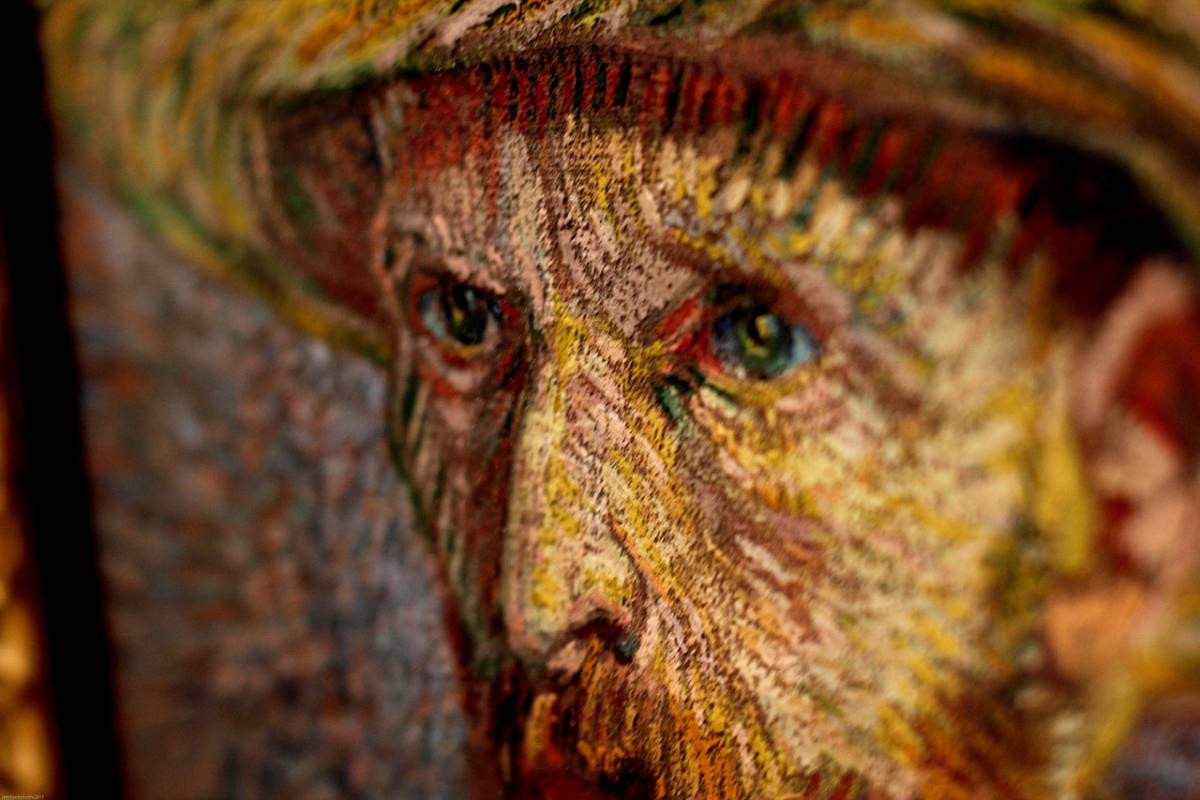
- Pinterest 31856
Looking for Van Gogh in Arles? Here’s how to do a self-guided Van Gogh art walk in the South of France.
Vincent Van Gogh is one of the most prolific painters in history, creating more than 2,000 works of art. Unfortunately, he was a tortured artist and is known for cutting off his left ear in a bout of mania.
Van Gogh spent a lot of time in asylums and hospitals to treat his mental health issues. During that time, painting served as his release.
Unlike other artists that are reclusive and leave us to guess as to their motivation/thoughts when creating a work of art, Van Gogh was an open book. Literally. He penned more letters than any other famous artist of his time, constantly explaining his thought process and plans to his brother Theo, his closest confidante, and other friends and family.
Today, Van Gogh’s paintings are scattered all over the world, from London to Chicago to Amsterdam. It’s impossible to find them all in one place. If you visit the South of France, however, you can see the real life places he painted, walking in Van Gogh’s footsteps.
The majority of the places on this list are in Arles, where Van Gogh lived and worked for many years. Some are also in Saint Remy, where Van Gogh was committed in the later part of his life. Saint Remy is only a half hour away from Arles and makes for an easy road trip.
RELATED POST: ONE WEEK ROAD TRIP THROUGH THE SOUTH OF FRANCE ITINERARY
If you want to chase Van Gogh in Arles, go to the tourism office and get a map for 1 Euro. From there, it’s easy to show yourself around the town. There are placards at designated sites on the art route so you can’t miss them.
This is a non-exhaustive list and there are many more places in the area where you can see artwork come to life. Here are some of the highlights of my search for Vincent Van Gogh in the South of France.
1) The Bedroom
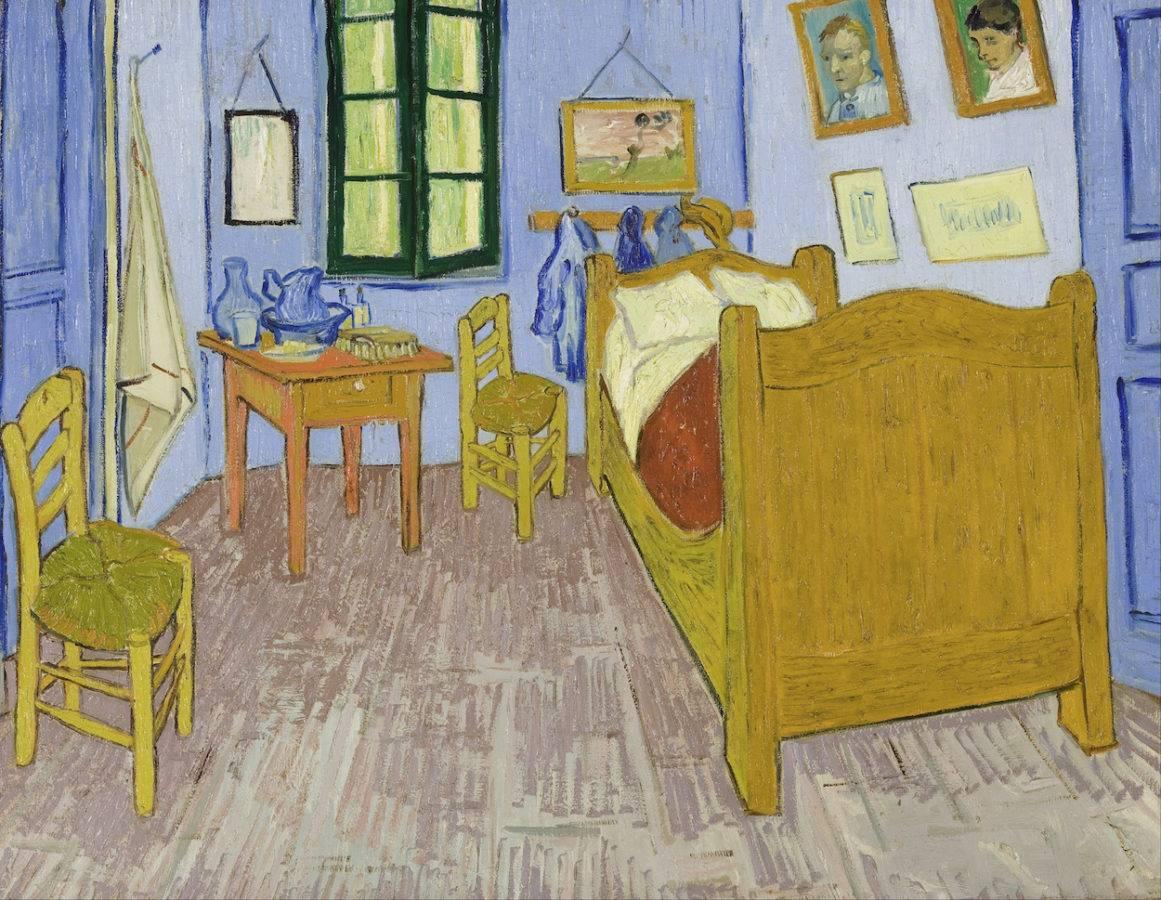
The Bedroom is one of Van Gogh’s most famous paintings. There are three in existence, showing the bedroom he had when he lived in the Yellow House in Arles. By the way, that house no longer exists so please do not waste two hours looking for it like I did.
Since the original bedroom is no longer available, the folks at the Saint-Paul de Mausolée Asylum and Monastery put together this replica. The place still serves as a psychiatric hospital but is an ode to Van Gogh, with prints of his paintings hung throughout the premises and a gift shop filled with Van Gogh souvenirs.
2) Oliveraie
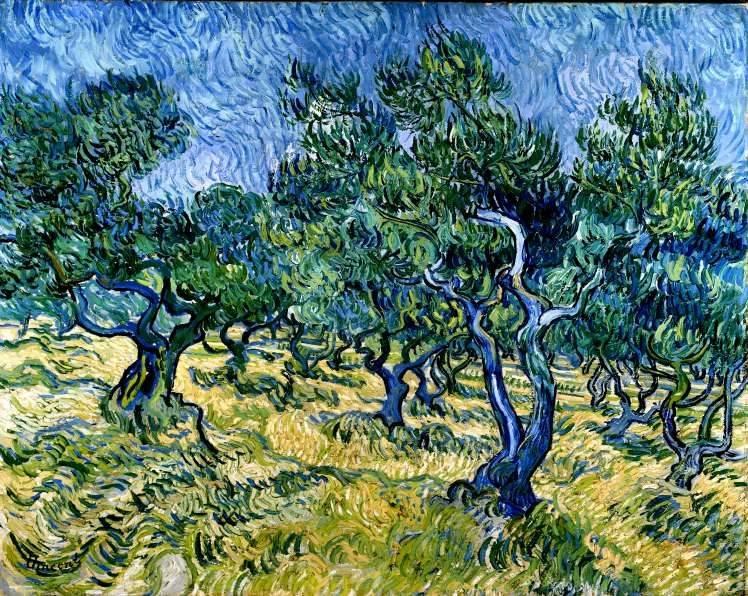
This is a field of olive trees outside of the asylum. Van Gogh painted many scenes from the area, finding respite in nature whenever he was given permission to roam the grounds. He described them as “venerable, gnarled olive trees.” Van Gogh wrote:
“The effect of daylight and the sky means there are endless subjects to be found in olive trees. For myself I look for the contrasting effects in the foliage, which changes with the tones of the sky. At times, when the tree bares its pale blossoms and big blue flies, emerald fruit beetles and cicadas in great numbers fly about, everything is immersed in pure blue.”
He felt that by interacting with nature, we could connect with the divine. As I walked around the premises to the tune of the cicadas, I couldn’t help but agree.
RELATED POST: VISITING LAC DE SAINTE CROIX IN CASTELLANE, FRANCE
3) Hospital in Arles
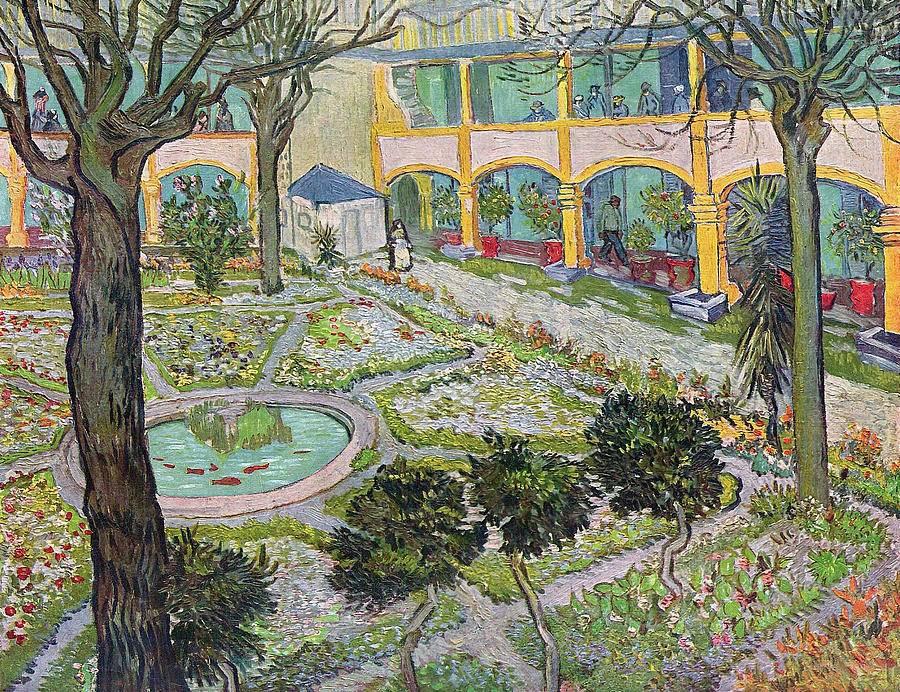
The courtyard of the former Arles Hospital, now known as “Espace Van Gogh,” is the subject of this painting. The vantage point is from Van Gogh’s room. The garden is well maintained and just as vibrant today as it was more than 100 years ago. Flowers featured in the painting include irises, pansies and poppies.
Aside from the courtyard, there’s not much to do here. The place is no longer operational but is maintained as a tribute to the artist who made it famous, despite him not being a welcome or an easy patient while he was there.
4) The Arena at Arles
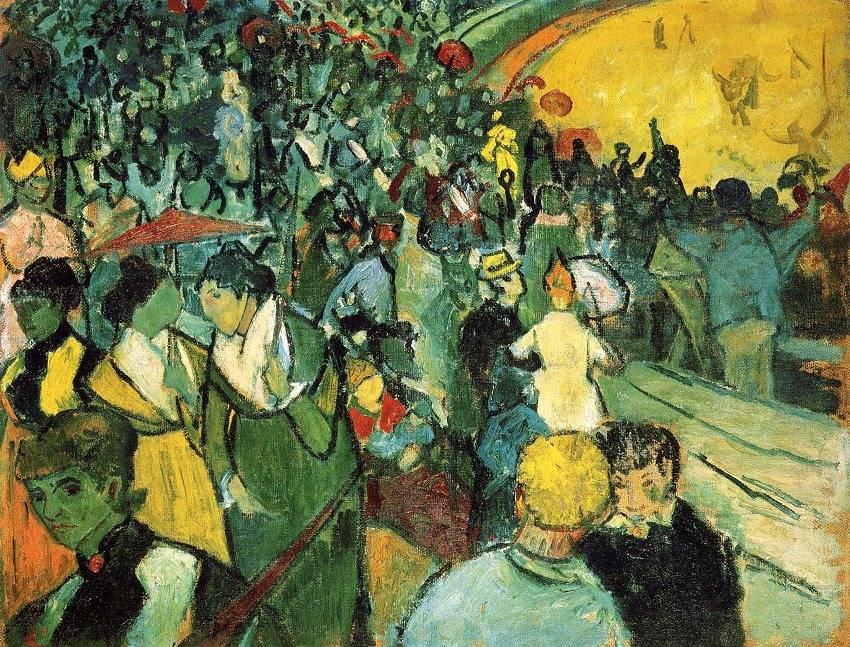
In the Van Gogh painting, the amphitheater is packed for a bullfight. The attention is on the crowd, however, not the show. The viewers include Van Gogh’s friends and acquaintances, which he often used as subjects in other paintings.
While in Arles, Van Gogh had a roommate, Paul Guaguin. He mimicked his style in this painting with flattened space and patches of color.
5) Cafe Terrace at Night
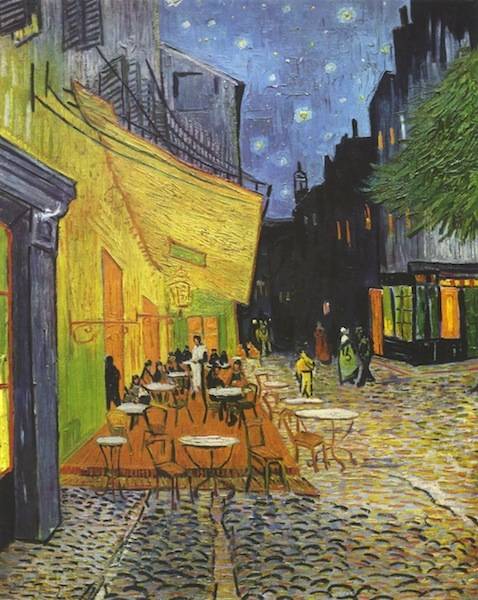
This was one of the earlier works that Van Gogh painted upon arriving in Arles, and the first one that he painted at night. The yellow cafe, illuminated from within, stands in sharp contrast to the night.
Today, the cafe is still operational, though I wouldn’t recommend eating there. It’s pricey and reviews aren’t great. In an effort to capitalize off the location, it’s called Cafe Van Gogh now.
There’s been a lot of development since the late 1800’s, so you’ll have a hard time seeing the terrace unobstructed and at the same angle that Van Gogh painted unless you’re dining there.
6) The Langlois Bridge at Arles
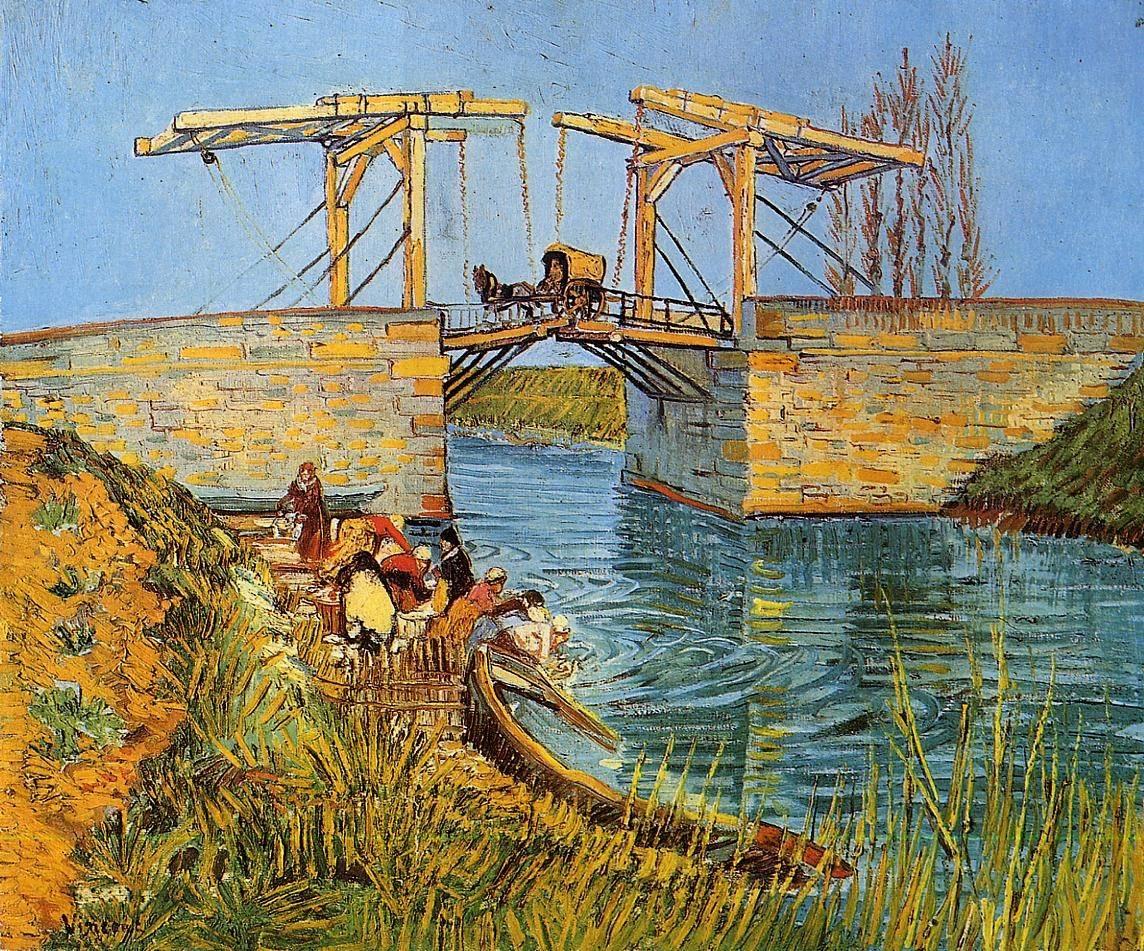
This bridge is the subject of four paintings Van Gogh made. The painting featuring the women washing clothes by the water is the most popular of the series. He said the canal reminded him of Amsterdam. At the time he painted it, Van Gogh was influenced by Japanese woodcut prints, using simple colors and forms to distill nature down to its essence and diagonal lines to direct the viewer’s eye.
The bridge has since been rebuilt and is called Pont Van Gogh. It’s located slightly outside the city and is not easily accessible if you’re walking.
7) Entrance to the Public Park in Arles
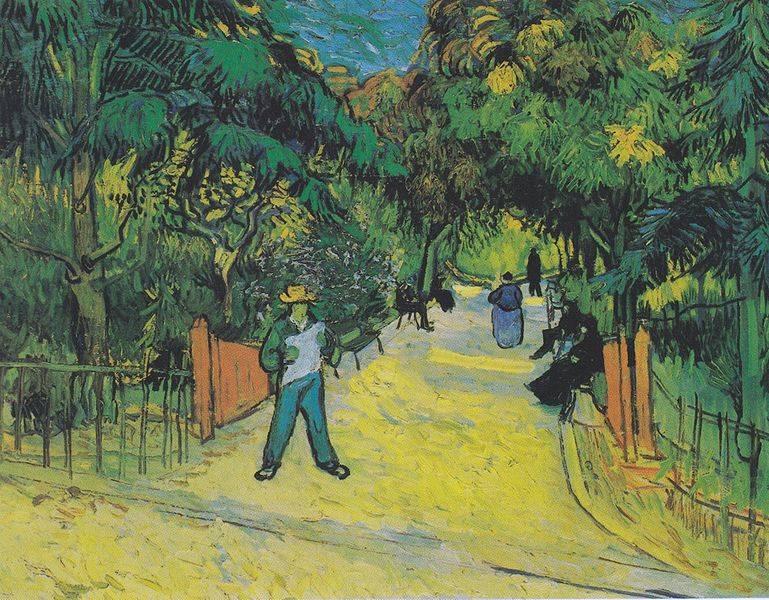
Van Gogh painted this park frequently since it was near his house. Here we see the entrance, modernized over the last 150 years to include new construction and development. The people in the scene are all enjoying restful activities.
In his letters, Van Gogh wrote that the sky was a marvelous blue, with the sun shedding “a radiance of pure sulphur.” The emphasis of this piece, however seems not to be the heavens but the earth, with heavy use of green to convert the lushness of nature.
RELATED POST: MY SOLO TRAVEL PHOTO SHOOT IN NICE, FRANCE WITH FLYTOGRAPHER
8) Corridor in the Asylum

This view of the corridor at Saint Remy was captured during Van Gogh’s voluntary 12-month stay. It is not an oil painting, however, but a watercolor drawing found at the MET Museum in New York . Van Gogh sent it to his brother Theo to give him a better idea of his surroundings.
Aside from being unusually large for a drawing, Van Gogh infuses color where there is none. The hallway is cold and ominous in real life, but in Van Gogh’s painting it is almost rainbow colored.
Notably, Van Gogh often used a mustard color for his yellows, as if the mute the inherent happiness of the hue. It is thought that Van Gogh might have suffered from xanthopsia, a color vision deficiency which causes a predominance of yellow in the vision, as a result of being treated with digitalis while committed.
9) Sunflowers
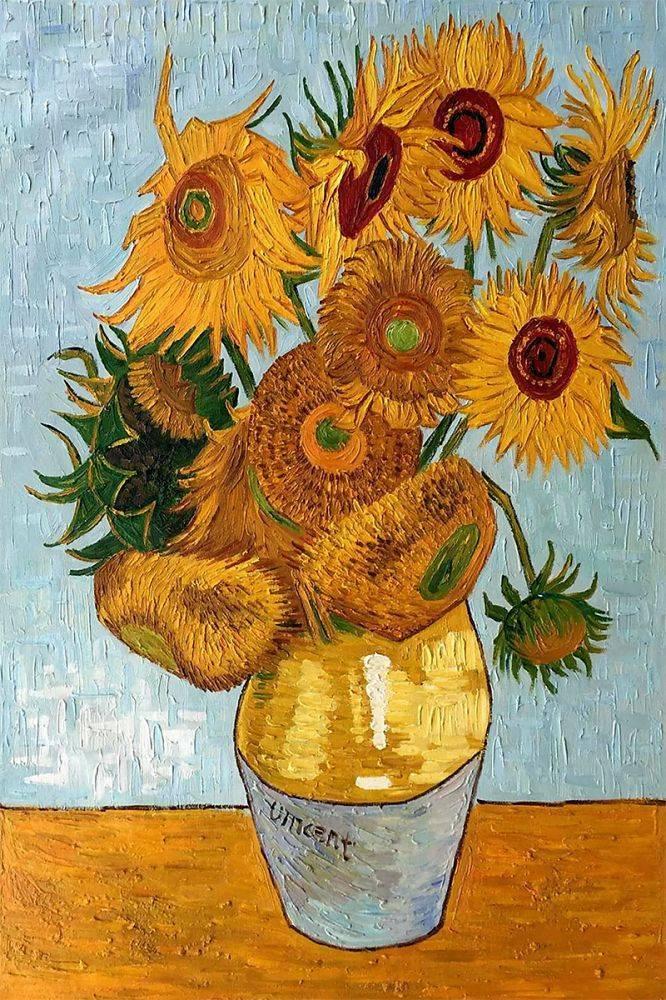
You won’t find a specific vase with sunflowers in them, but driving around Arles makes it easy to see why Van Gogh was so obsessed with the flower. Sunflowers symbolize happiness and hope. This series was completed during a more optimistic time in Van Gogh’s life, when he’d just moved to Arles and was awaiting for the arrival of Guaguin. He’d hoped to form an artist’s community in the area with Guaguin as his mentor.
Perhaps indicative of his inner struggles, the sunflowers in Van Gogh’s depiction are never seen in full splendor, but rather a few days after being picked, when they’re slightly wilted. It’s thought that Van Gogh painted the flowers as decoration for his bedroom.
10) Starry Night Over the Rhone
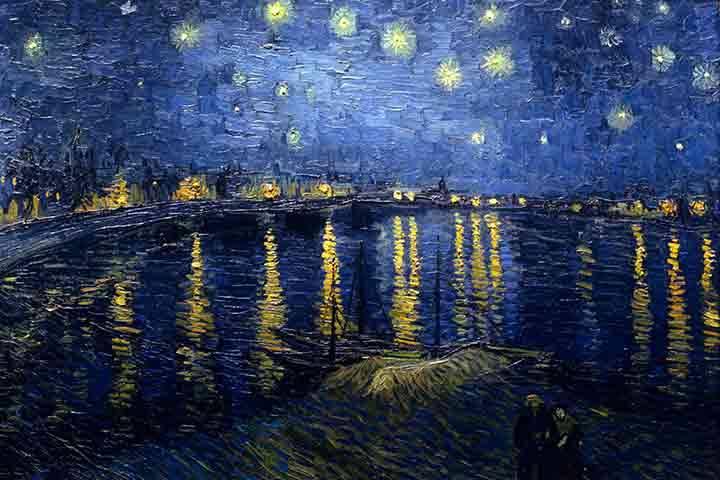
The evening sky served as inspiration for Starry Night Over the Rhone. It was painted from a vantage point just 2 minutes from Van Gogh’s house. Later, Van Gogh would paint the sky our Saint Remy in one of his most famous pieces, The Starry Night.
This piece captures the gas lighting of the time as it glimmered across the water. In the bottom right corner, two lovers are seen strolling at night.
Today, modern electricity takes away some of the magic, and an excess of ambient lighting makes the sky much less impressive (I didn’t see very many stars) but the basic outline remains and you can picture Van Gogh walking along the water at night, hoping to find some solace.
RELATED POST: VISIT THE LAVENDER FIELDS AT THE SENANQUE ABBEY IN FRANCE
Till next time, safe travels!
Liked this post? Pin me below.
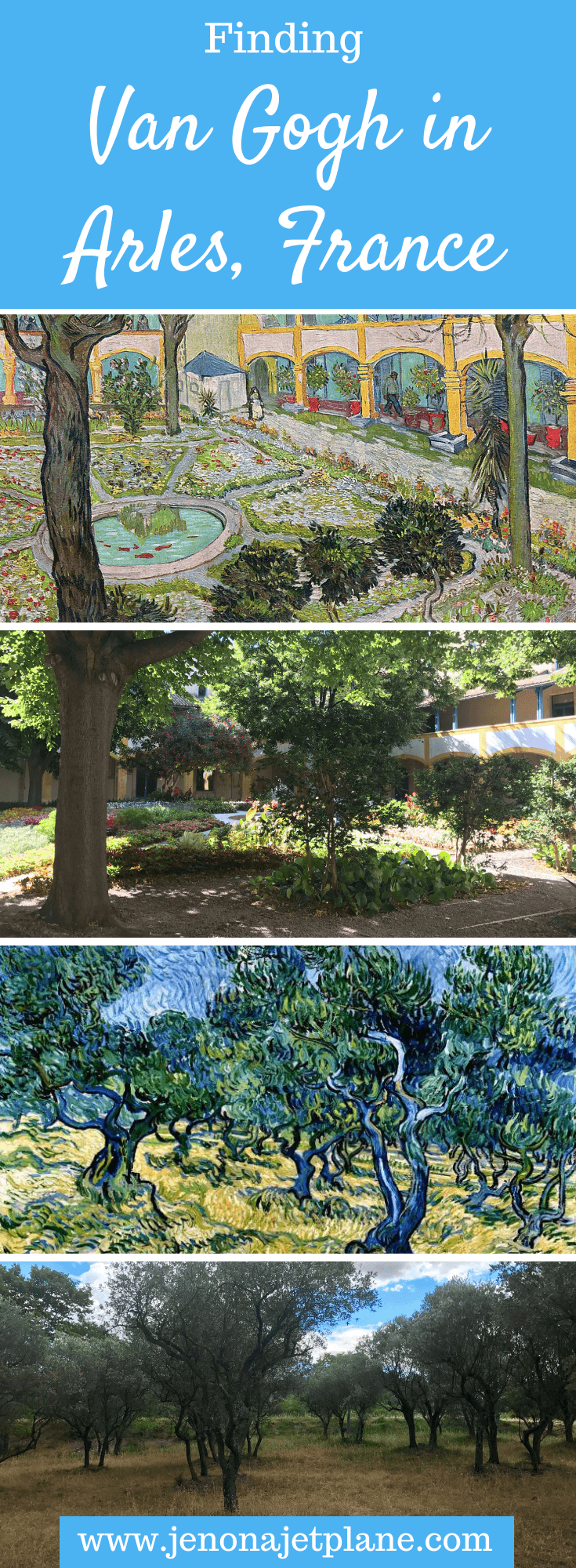
starry night
Tuesday 21st of January 2020
Wow, you've got an amazing experience, so happy for you! Every art lover should visit those places, this is history! Definitely helps to see the world with Vincent's eyes
Wednesday 18th of September 2019
Any recommendations on where to stay in Arles? I will be there for two nights and hope to do this tour. Is there any neighborhood more convenient than others?
Jen on a Jet Plane
Saturday 21st of September 2019
If I remember correctly I stayed somewhere a little out of the way that was convenient to reach by car and affordable with all the basic necessities, believe it was Hotel ibis Styles Arles Palais des Congrès. I can't speak to the other neighborhoods but felt safe where I was. I hope this helps, and have a great trip!
Wednesday 19th of June 2019
Uh oh. It looks like I've found something new to add to my ever-growing travel wish list. What an amazing experience. I just saw one of the Bedroom in Arles paintings at the Musee d'Orsay in Paris. To actually travel to Arles would be amazing!
Thursday 20th of June 2019
It's an amazing experience for art lovers! There's a special vibe to the city, highly recommend it!
Lynne Nieman
Saturday 2nd of March 2019
I love Van Gogh and love that you sought this out. Now I want to go to Arles and St Remy!!
Monday 4th of March 2019
It's so worth a visit!
What a fascinating article and what a great way to see France. I love it. When I go back, I am definitely following your post.
Thank you Julie!

Van Gogh in Arles
- 20 Feb. 1888 1888 - 8 May 1889
Vincent lived in Arles in the South of France for more than a year. He experienced great productivity there before suffering a mental breakdown.
Vincent moved to Arles on 20 February 1888. After two years in Paris , he was tired of the bustle and demands of city life and longed for the sunshine and vibrant colours of the south. Upon arrival in Arles, Vincent took a room at the hotel-restaurant Carrel , and later, one at Café de la Gare. In early September, he settled into the Yellow House , which he had begun using as a studio on 1 May.
Vincent was highly productive during this period and made numerous paintings and drawings in and around Arles. He developed an expressive, individual painting style characterised by bold colours and dynamic brushstrokes. In Arles, he met the artists Eugène Boch, Dodge MacKnight and Christian Mourier-Petersen and befriended Joseph Roulin, the postal official at the train station. The artist Paul Gauguin came to join him in October, and they worked together in Arles for two months.
In late December, Vincent suffered a psychosis during which he cut off part of his ear and handed it to a prostitute. Gauguin returned to Paris soon afterward. Vincent was admitted to hospital and discharged on 7 January. In late January and February, however, he suffered two more attacks and he returned to hospital for a longer stay. On 8 May 1889, Vincent left Arles to be voluntarily committed to a psychiatric institution in Saint-Rémy de Provence.
Locations in Arles
Existing, accessible
Existing, inaccessible
Disappeared
Cathédrale Saint-Trophime
Café du forum, folies-arlésiennes, saintes-maries-de-la-mer, musée lapidaire, musée réattu, bridge of langlois, restaurant vénissac, café de la gare, restaurant carrel, the yellow house.

View of a butcher's shop, 1888
Oil on canvas on cardboard, 39,7 x 33,1 cm.

An old woman of Arles, 1888
Oil on canvas, 58 x 42 cm.
Van Gogh Museum, Amsterdam (Vincent van Gogh Stichting)

Landscape of snow 1888
Oil on canvas, 50 x 60 cm.

De Arlesienne (Madame Ginoux),1888
Oil on canvas, 92,3 x 73,5 cm.
Musée d'Orsay, Parijs

Postman Josesph Roulin, 1889
Oil on canvas, 81,3 x 65,4 cm.
Museum of Fine Arts, Boston

Joseph Roulin, 1888
Oil on canvas, 64,1 x 47,9 cm.
Oil on canvas, 64,1 x 47, 9 cm

Oil on canvas, 65 x 54 cm
Erven van Georg Reinhart, Kunstmuseum Winterhur

Portrait of Joseph Roulin, 1889
Oil on canvas, 64,4 x 55,2 cm.
The Museum of Modern Art, New York

Portrait of Camille Roulin, 1888
Oil on canvas, 40,5 x 32,5 cm.

Portrait of Marcelle Roulin, 1888
Oil on canvas 35,2 x 24,6 cm.

Portrait of Armand Roulin, 1888
Oil on canvas, 66 x 55 cm.
Museum Folkwang, Essen

La Berceuse (portrait of Madame Rouline),1889
Oil on canvas, 91 x 72 cm.
Kröller-Muller museum, Otterlo

La Berceuse, 1889
Oil on canvas, 92,7 x 73,7 cm.
The Metropolitan Museum of Art, De Walter H. en Leonore Annenberg Collectie, New York

Augustine Roulin (La Berceuse), 1889
Oil on canvas, 93 x 74 cm.
The Art Institute of Chicago, Helen Birch Barlett Memorial Collectie, Chicago

Oil on canvas, 91 x 71,5 cm
Stedelijk Museum, Amsterdam

Oil on canvas, 92,7 cm x 72,7 cm
Museum of Fine Arts, nalatenschap van John T. Spaulding, Boston

Ward in the hospital, 1889
Oil on canvas, 73 x 92 cm.
Oskar Reinhart Collection, Winterhurt

Brug te Arles (Pont de Langlois), 1888
Oil on canvas, 53,4 x 64 cm.
Kröller-Müller Museum, Otterlo

The bridge at Langlois
Oil on canvas, 59,6 x 73,6 cm

Bridge at Langlois with woman with umbrella, 1888
Oil on canvas, 49,5 x 64,5 cm.
Wallraf-Richarts Museum & Fondation Corbound, Cologne, Gemany

Sunset at Montmajour, 1888
Oil on canvas, 73,3 x 93,3 cm.
Useful links
- Toeristische informatie Arles
- Fondation Vincent van Gogh Arles
- The Vincent van Gogh Gallery
Relevant letters from Vincent
No relevant letters found so far.
Continue reading
Marije Vellekoop, Roelie Zwikker
- Privacy Overview
- Strictly Necessary Cookies
- 3rd Party Cookies
This website uses cookies so that we can provide you with the best user experience possible. Cookie information is stored in your browser and performs functions such as recognising you when you return to our website and helping our team to understand which sections of the website you find most interesting and useful.
Strictly Necessary Cookie should be enabled at all times so that we can save your preferences for cookie settings.
If you disable this cookie, we will not be able to save your preferences. This means that every time you visit this website you will need to enable or disable cookies again.
This website uses Google Analytics to collect anonymous information such as the number of visitors to the site, and the most popular pages.
Keeping this cookie enabled helps us to improve our website.
Please enable Strictly Necessary Cookies first so that we can save your preferences!
Come and discover our new exhibition — The High Yellow Note — Open from Tuesday to Sunday
- Buy tickets
- The Foundation

Stay in touch with us:
Opening hours
Fondation Vincent van Gogh Arles 35 ter, rue du Docteur-Fanton 13200 Arles
Shop +33(0)4 88 65 82 86 [email protected] www.eshop-fvvga.com
Ticket: 10 € Reduced ticket*: 8 € Students rate**: 3 € Free Entrance: Children under 18 years, disabled visitors, tour guides, holders of a Press Card or an ICOM card, art students and art teachers
* Reduce rates: Seniors from the age of 65, unemployed visitors, large families, international artists ID, holders of the Arles City Pass, students over 26 and people with an entry ticket from the 3 institutions: the Montmajour abbey, Lee Ufan Arles and LUMA Arles (less than six months old).
** Student rate: for students under 26 years
Combo Tickets – Benefit from preferential rates!
With the Musée Réattu > 12 € pass 1 entrance to the Musée Réattu + 1 entrance to the Fondation Ticket valid for 1 year from date of issue
With Sud Contemporain — Festival Permanent > 20 € pass 1 entrance to each of the 4 institutions: – Collection Lambert, Avignon – Carré d’Art, Nîmes – MO.CO., Montpellier – Fondation Vincent van Gogh Arles Ticket valid for 1 year from date of issue
School groups
The Fondation Education team offers three options for school and children groups! Download the booking form to let us know what you want.
The Dicovery Tour
A guided tour lasting one hour, for students from preschool to high school. Price: 30 €
The Thematic Tour
A guided tour lasting an hour and a quarter, conducted with the help of a kit and educational tools, for students from preschool to secondary school. Price: 30 €
The Educational tour
A duo offer, consisting of a visit of your choice and an artistic practice workshop lasting one and a half hours, for pupils from preschool to secondary school. During the workshop, each student produces a personal work and participates in a collective creation. Price: 80 €
Informations & booking
E-mail : [email protected] Telephone : +33 (0)4 90 93 49 36 (from Monday to Friday, from 10am to 12.30pm and from 2pm to 4pm)
All visits are conducted by our Educational team and are adapted to the level and age of the children. Groups must be booked at least 15 days in advance. Self-guided tours are not permitted. Groups must arrive at the Fondation entrance five minutes before the start of the visit.
For each option, see above. For all packages, the entrance ticket is free for children, accompanying adults (maximum 4 people) and the bus driver.
For schoolchildren, the recommended number of accompanying persons is as follows:
- preschool and primary school: one accompanying adult for every eight pupils
- secondary school and high school: one accompanying adult for every ten pupils
Guided tours
Guided tours are offered every day by our Educational team, and last approximately 1h15. A maximum of 30 people is allowed per guided tour. Self-guided tours are not admitted.
Information & booking
The booking office is open Monday to Friday : 10am-12.30 & 1.30-4.30pm.
E-mail : [email protected] Telephone : +33 (0)4 90 93 49 36
All group visits must be booked via our booking office at least 15 days in advance.
Groups must arrive 5 minutes before the start of the tour at the meeting place indicated on the booking confirmation.
Tour & admission fees
Guided tour : 80 € (admission ticket excluded) Admission ticket: 7 € per person The accompanying person and the bus driver of the group get free admission. Tour prices include booking fee.
Guided tours are offered in French, English and Italian. Groups may be accompanied by their interpreter.
- Booking form | ADULT GROUPS
Families are welcome at the Fondation, where everything is done to welcome them in the best conditions! Puschchairs are accepted; two wheelchairs are also at disposal.
Admission is free for children under 18.
During July & August, a booklet for children aged 7 to 12 is available for free at the ticket office (in French and English). This allows the youngest to discover the exhibition in a fun and educational way!
Three reasons to support us: • To (re)discover original works by Vincent van Gogh from the most prestigious international cultural institutions and private collections • To explore current artistic creation through the works of established and emerging contemporary artists • To participate in the Fondation’s primary mission: to promote access to culture and the transmission of art to all audiences
The benefits: • Annual pass (unlimited access to the Foundation) • Invitation to the opening of each exhibition, in the presence of the artist(s) and the curator(s) • Priority booking on all educational activities (young public, families and adults)
- Bulletin d'adhésion | Particulier
Practical informations
Ticket office and general information on the exhibition program: +33(0)4 88 65 82 93 / [email protected]
Group booking: +33 (0)4 90 93 49 36 (open Monday to Friday from 10am to 12.30 and from 2pm to 4pm) / [email protected]
Administration: [email protected]
Cloakroom and wheelchairs
A cloakroom is available free of charge. However, the space is limited and we highly recommend our visitors to come without big bags. Only smaller handbags are allowed inside the exhibition space. Backpacks are authorized if worn in front. In case of rainy weather, jackets and umbrellas must be left in the cloakroom.
Two wheelchairs are available at the reception of the Foundation
Come by pedicab!
To get around the Arles city centre and to come to the Fondation, think of using the Taco & Co pedicabs!
Information and booking: +33 (0)6 50 29 60 00
Website : www.visiterarles.com
The Fondation is located in the heart of Arles where traffic is difficult and not recommended. It is best to park in one of the nearby car parks ( prices available here ):
P1 – Hortus (68 spaces), 11 min walk / 850 m
P2 – Cirque Romain (500 spaces), 11 min walk / 1,4 km
P3 – Sixte Quenin (174 spaces), 11 min walk / 900 m
P4 – Ancienne Caserne (500 spaces), 11 min walk / 950 m
P6 – Gare SNCF (200 spaces + 22 bus spaces), 14 min walk / 1,1 km
P7 – Centre (500 spaces, indoor), 9 min walk / 750 m
P9 – Minimes (450 spaces), 23 min walk / 1,8 km
An insider’s travel guide to Van Gogh's Arles
Follow in the artist’s footsteps and discover the places that inspired his greatest paintings.
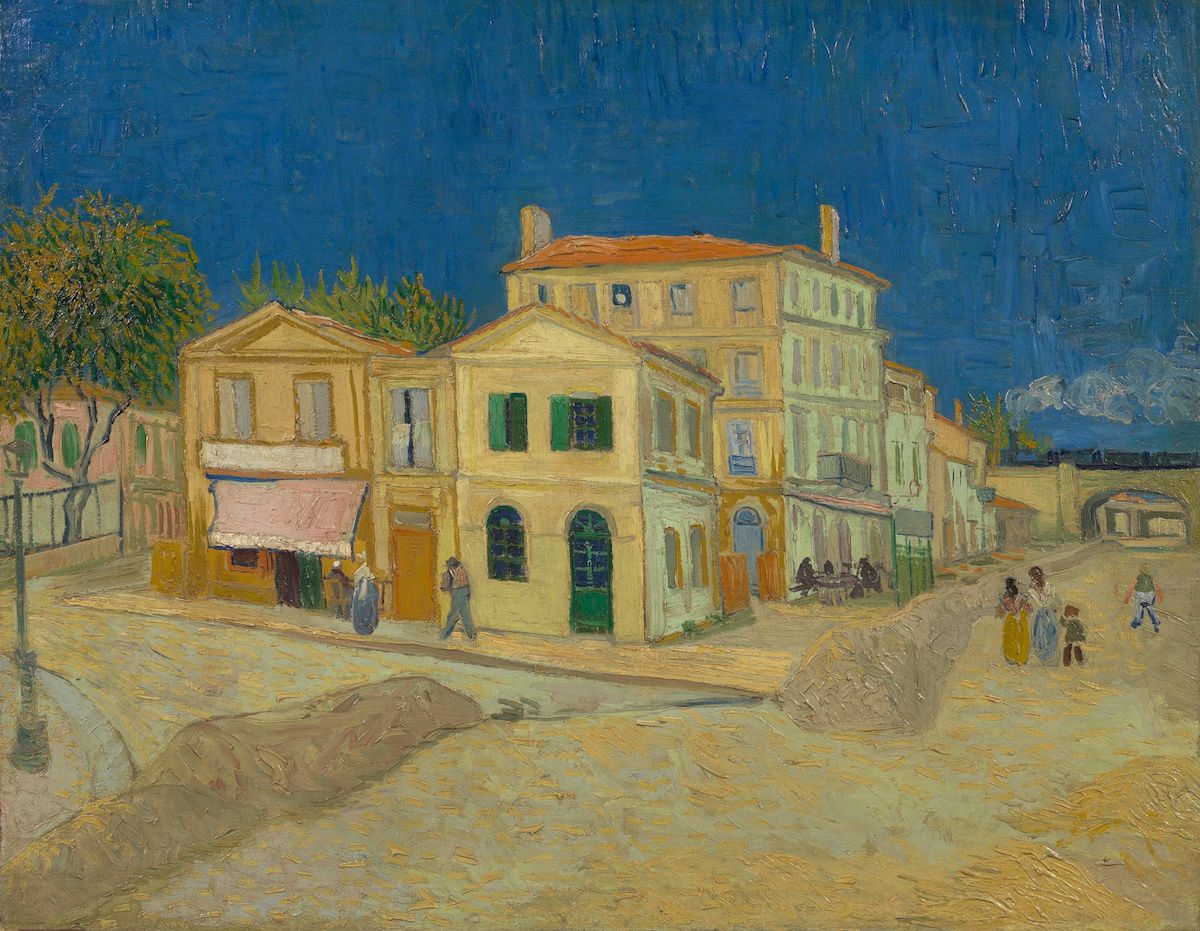
Vincent van Gogh, The Yellow House, September 1888 Van Gogh Museum, Amsterdam (Vincent van Gogh Foundation)

Adventures with Van Gogh is a weekly blog by Martin Bailey, our long-standing correspondent and expert on the artist. Published every Friday, his stories range from newsy items about this most intriguing artist to scholarly pieces based on his own meticulous investigations and discoveries. © Martin Bailey
June is probably the best month to visit Provence and follow the Van Gogh trail. A stroll through Arles offers a delightful insight into the artist’s life and work. Low-rise houses with sun-bleached shutters line its narrow, pedestrianised streets. The sweeping curve of the Rhône embankment is never far away, along with remnants of the ancient ramparts that once surrounded the city’s historic centre.
Start the Van Gogh trail in Place Lamartine, two minutes walk from the railway station. It was here that the artist painted one of his most personal pictures, The Yellow House . Van Gogh rented the small, cosy house soon after his arrival in 1888. For the only time in his adult life, he had a real home of his own. “I live in a little yellow house with green door and shutters, whitewashed inside”, he wrote excitedly to his sister Wil. Later that year, he invited his friend Paul Gauguin to join him from Paris. Sadly, their collaboration came to an abrupt end just before Christmas, when Vincent mutilated his ear.
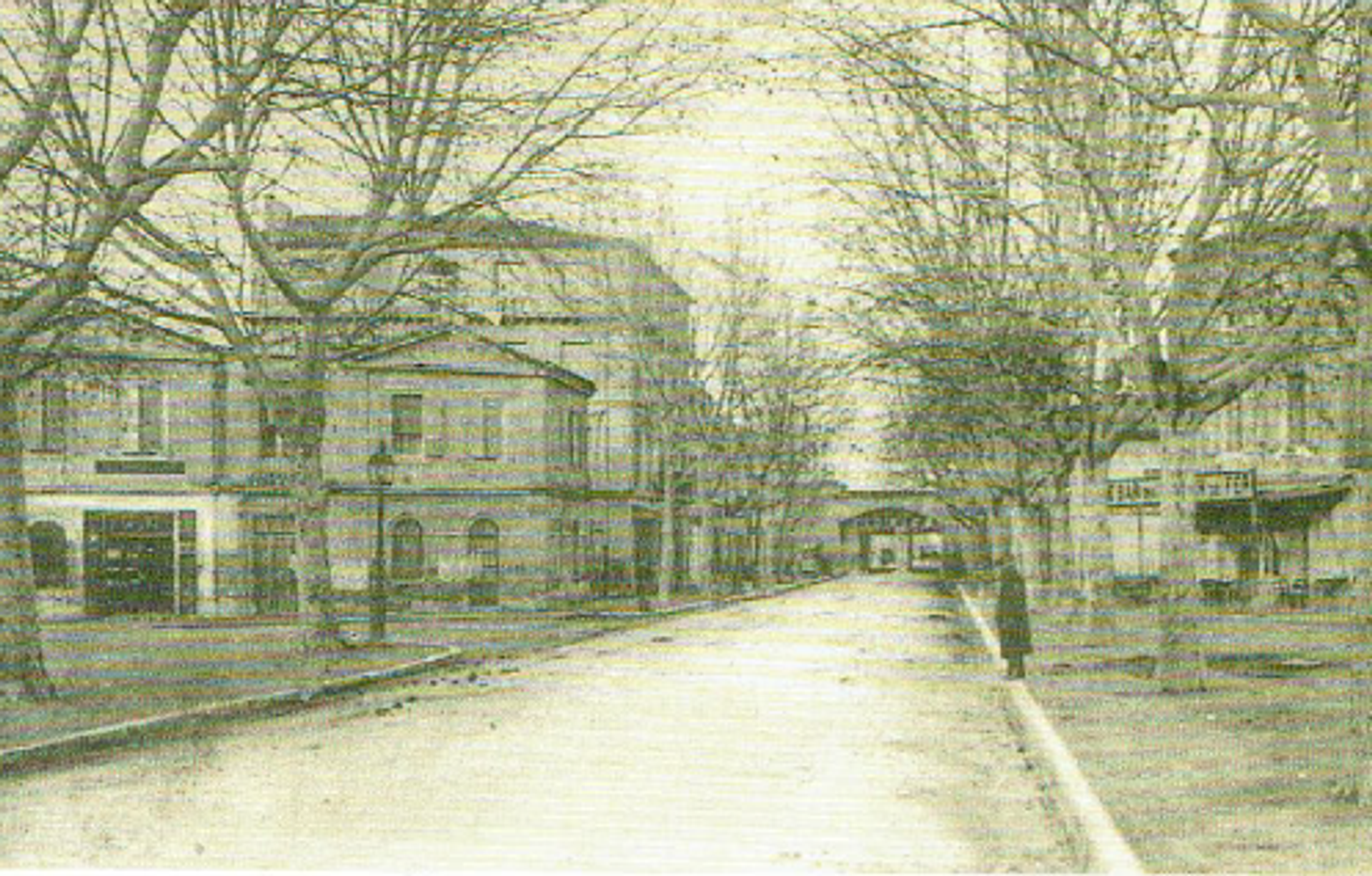
Detail of a postcard showing Place Lamartine and the Yellow House, around 1904
A postcard from around 1904 represents the earliest photograph of the Yellow House (which lies behind the lamppost). The building just to its left, with a whitewashed exterior on the lower floor—and a pink awning in the painting—housed a grocery shop, which must have been very convenient for Van Gogh.
Behind the Yellow House lies a taller building that now houses the Café Terminus—a good place to stop for a coffee and croissant. Further up the road are two railway viaducts that were depicted by Van Gogh and still survive. Van Gogh called it the Route de Tarascon, and he would set off along the dusty way most days to work in the landscape just outside Arles. It is now the Avenue de Stalingrad, honouring the Red Army’s victory over Nazi Germany.

A postcard showing the Yellow House after the bombing of 25 June 1944
During the Allied bombing of Arles during the Second World War, the Yellow House was hit. Van Gogh’s bedroom on the upper floor (with the closed green shutters in the painting) was destroyed, although Gauguin’s adjacent room partly survived. Downstairs the walls of the studio and the kitchen suffered lesser damage. The building could have been saved, but instead it was simply demolished. Had the Yellow House been rebuilt, it would now rank among the most popular French tourist attraction outside Paris.
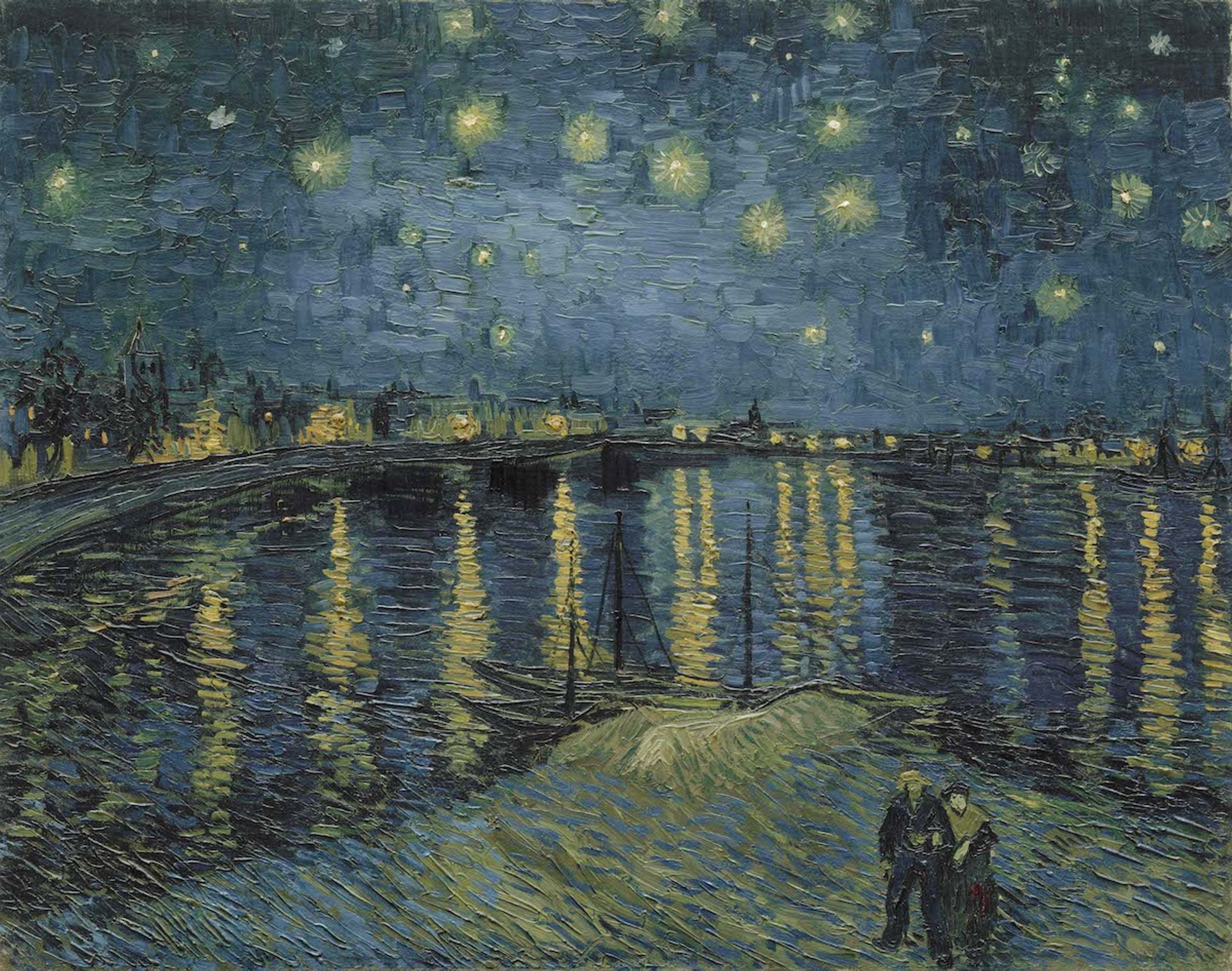
Vincent van Gogh, Starry Night over the Rhône (1888), Musée d’Orsay, Paris, currently on loan to Tate Britain, London © RMN-Grand Palais (Musée d'Orsay)/Hervé Lewandowski Musée d’Orsay, Paris
Three minutes walk away from the left edge of the painting lies the river, where Van Gogh painted Starry Night over the Rhône . This bold riverscape under the stars is temporarily in London, on display in Tate Britain’s Van Gogh exhibition (until 11 August). The river scene at night remains largely unchanged, although of course the sky in the painting comes from the artist’s imagination.
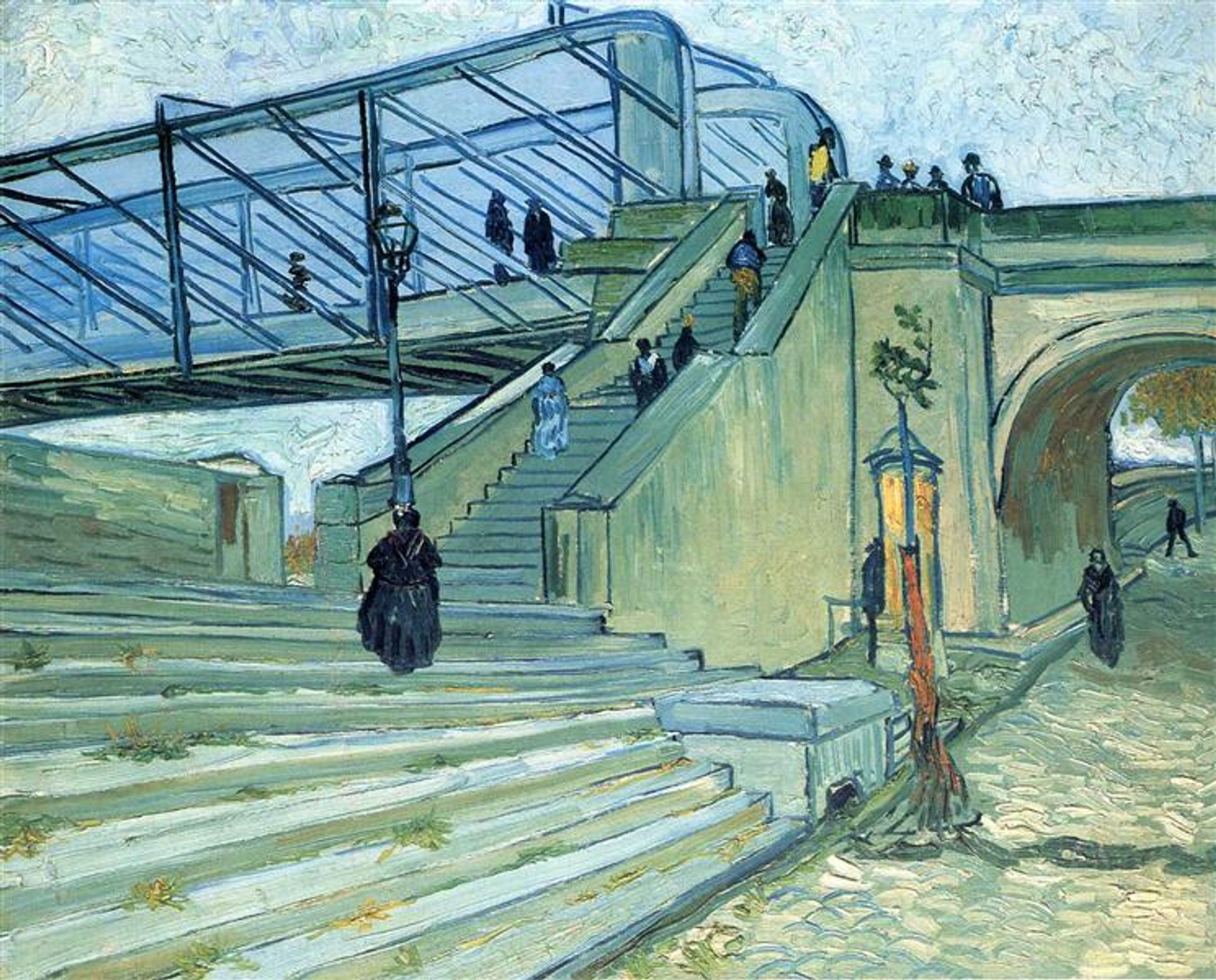
Vincent van Gogh, Trinquetaille Bridge, 1888, private collection
Then walk along the Rhône embankment towards the bridge which crosses the river to the suburb of Trinquetaille. Although the bridge was bombed and rebuilt to a modern design in 1951, part of the original stonework approach remains on the Arles end. Van Gogh painted Trinquetaille Bridge from the embankment on the southern side. The tall tree now standing there may even have been the sapling in his painting. Félix Rey, the doctor who treated Van Gogh after the ear incident, lived on the upper approach to the bridge at what is now 6 Rue Anatole France.
Five minutes away is the Fondation Vincent van Gogh Arles, an exhibition venue which opened in 2014 in a converted 15th century mansion. Curated by Bice Curiger, it mainly shows contemporary art, some that is inspired by the Dutch master. The venue also usually holds summer exhibitions that have some original Van Gogh drawings and paintings. The current displays include Vincent van Gogh: Speed & Aplomb , a show of six paintings that runs until 20 October.
Sadly, Van Gogh’s artistic efforts in Arles were ignored during his lifetime, and the few paintings that he gave to local friends were all sold off by the very early 1900s. The Fondation therefore now plays a key role in bringing back some of his pictures to the city where he produced his finest works.
• For a more detailed travel guide, see my book Studio of the South: Van Gogh in Provence , pp. 188-91.
Martin Bailey is a leading Van Gogh specialist and special correspondent for The Art Newspaper . Bailey has curated Van Gogh exhibitions at the Barbican Art Gallery, Compton Verney/National Gallery of Scotland and Tate Britain.

Martin Bailey’s recent Van Gogh books
Bailey has written a number of bestselling books on Van Gogh’s years in France: The Sunflowers Are Mine: The Story of Van Gogh's Masterpiece (Frances Lincoln 2013 ( UK and US ), Studio of the South: Van Gogh in Provence (Frances Lincoln 2016 ( UK and US ), Starry Night: Van Gogh at the Asylum (White Lion Publishing 2018, UK and US ) and Van Gogh’s Finale: Auvers and the Artist’s Rise to Fame (Frances Lincoln 2021, UK and US ). The Sunflowers are Mine ( UK and US ) and Van Gogh’s Finale ( UK and US ) are also now available in a more compact paperback format. Living with Vincent van Gogh: the Homes and Landscapes that shaped the Artist (White Lion Publishing 2019, UK and US ) provides an overview of the artist’s life. The Illustrated Provence Letters of Van Gogh has been reissued (Batsford 2021, UK and US ). My Friend Van Gogh/Emile Bernard provides the first English translation of Bernard’s writings on Van Gogh (David Zwirner Books 2023, UK and US ).
To contact Martin Bailey, please email [email protected] . Please note that he does not undertake authentications.
Read more from Martin's Adventures with Van Gogh blog here .
Most popular inspiration
Most popular experiences
Most popular destinations
Most popular itineraries
Travel bucket list idea:
Van Gogh Walk in Arles
Arles, Provence, France

The Langlois Bridge
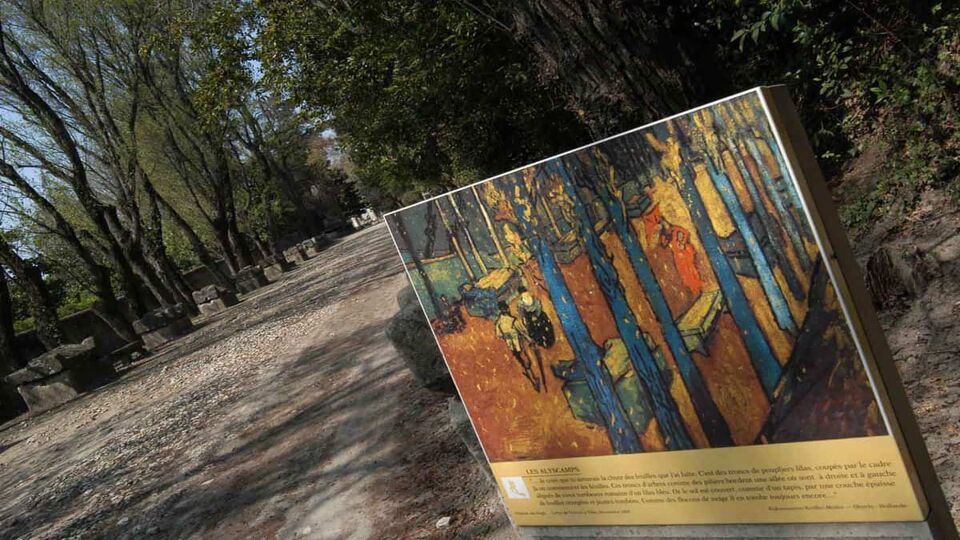
Location of Van Gogh’s painting ‘The Yellow House’

St Paul de Mausole, the psychiatric asylum Van Gogh was interned
Credit Shutterstock.com/EQRoy
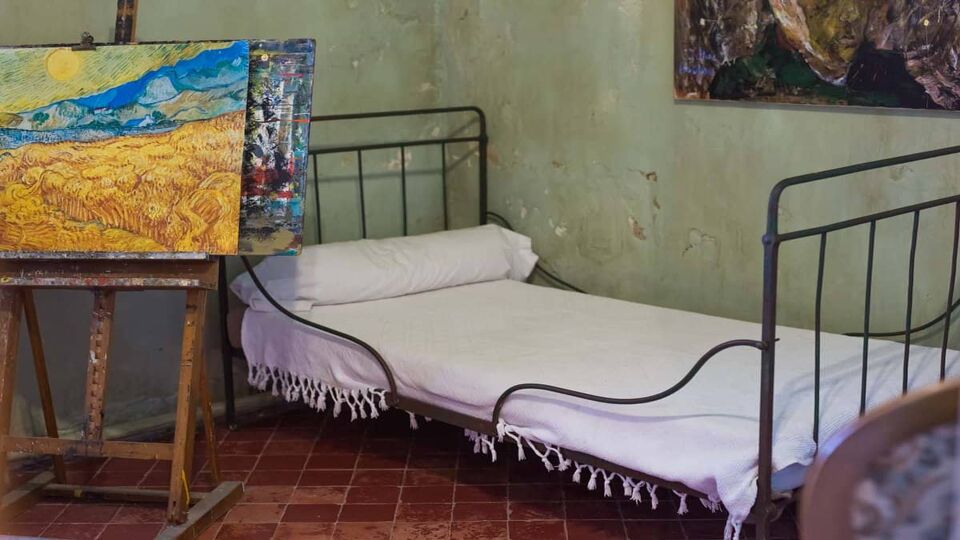
Van Gogh’s bedroom

The bath tubs at the St Paul de Mausole asylum
Credit Shutterstock.com/Tatiana Chekryzhova
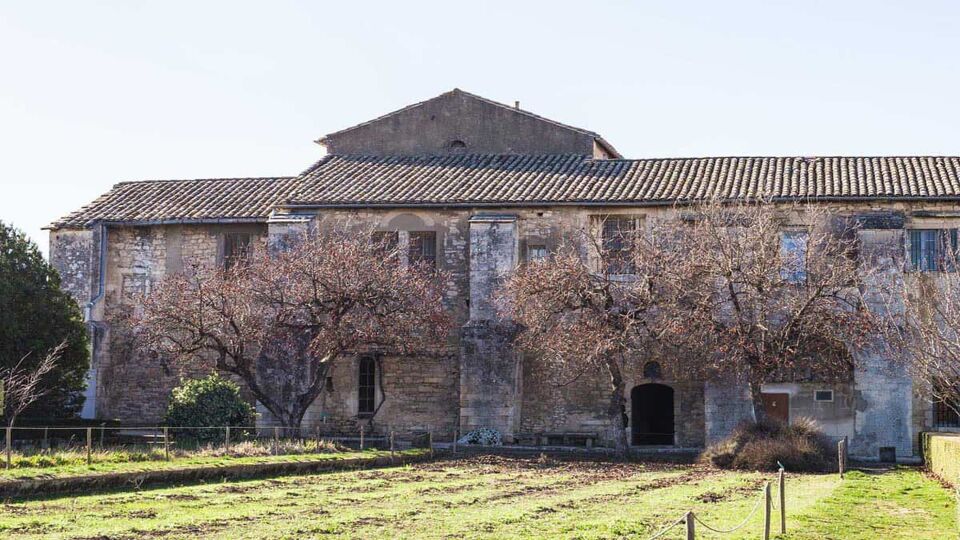
The asylum of St Paul de Mausole

Credit Shutterstock.com/Oliverouge 3
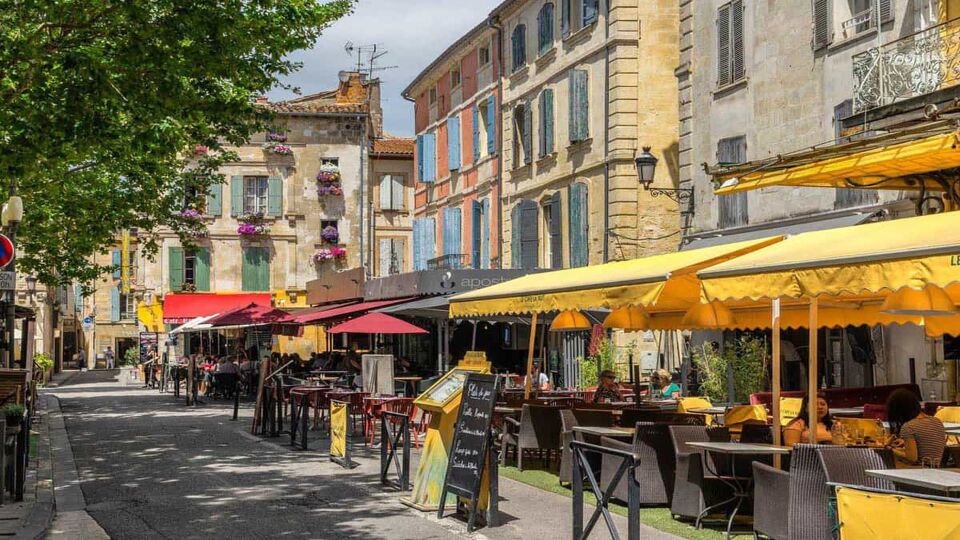
Espace Van Gogh

Cafe Van Gogh, subject of another famous Van Gogh masterpiece
Credit Shutterstock.com/ladderadder
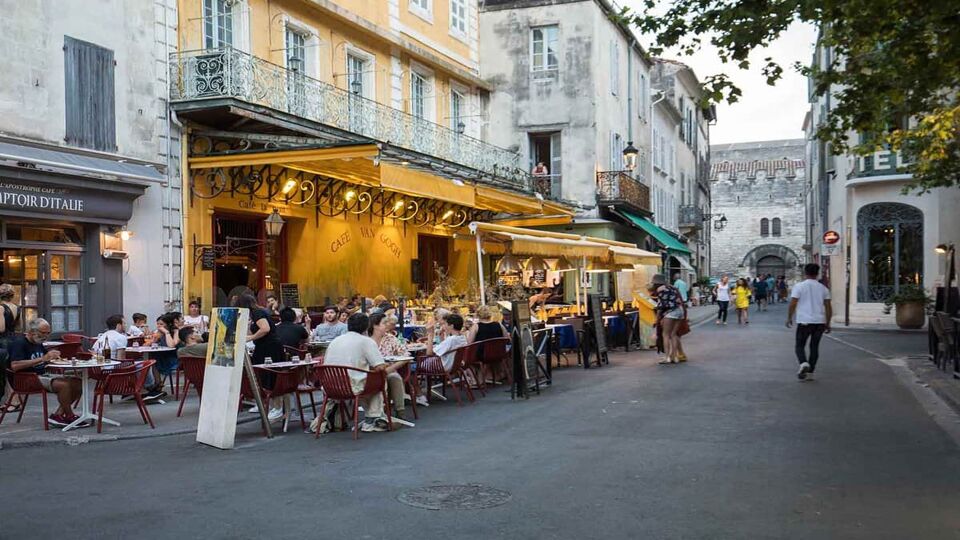
Why not finish up with a coffee here?
Credit Shutterstock.com/wjarek

As prime spots where Van Gogh lived and painted, the towns of Arles and Saint-Remy both regret not hanging on to any of Van Gogh’s original works while he was alive. To make up for it, each has set up a self-guided Van Gogh Walk, pinpointing the scenic spots where the master planted his easel.
When doing the walk in Arles, spare some time to see the Espace Van Gogh in the former hospital on Place du Dr Félix Rey, where he had his ear stitched up and was later locked up. Inside you’ll find exhibits chronicling his stay. The hospital’s courtyard has been remodelled to resemble as closely as possible his famous painting ‘Le Jardin de l’Hôtel de Dieu’. You’ll also pass by the Reattu Fine Arts Museum, which houses many of Van Gogh letters, and the famous Café Terrace on the Place du Forum.
Don't miss
After your walk, visit the Van Gogh Foundation on Place Honore Clair, which displays art (paintings, sculpture, photography, texts) in homage to Van Gogh.
Getting there & doing it
For the self-guided walk, pick up information and a map at the Arles tourist office on Boulevard des Lices before setting out – or download the map from the website before you go. The walk traces a path across the city, with information boards that include photos of his paintings along the way. The tourist office also produces an excellent little booklet that you can download with information on all of the stops and any associated paintings.
There are several local tour operators that will take you on the walk, either specifically or as part of a broader tour (see our recommendations below of who to go with). The major plus is a knowledgeable guide, who’ll have information, insights and anecdotes on Van Gogh you won’t get if you go it alone.
When to do it
Obviously, you can follow the walk at any time of year, but it’s most picture-perfect when Van Gogh’s favourite flowers are in bloom: go in April and May for the irises, or in late June to early August for the sunflowers.
The Foundation is open all year round, seven days a week, though it closes on Mondays in winter months. The Espace van Gogh is also open all year round, seven days a week, though it closes on Sundays.
Who to go with: organised tours
Our selection of the best Viator tours of this attraction or activity
In the footsteps of Van Gogh in Provence from Avignon

Rating 4.34 / 5 [72 ratings]
Tour supplied by:
Half-Day Van Gogh Tour of Provence from Avignon

Rating 4.76 / 5 [26 ratings]
History and Van Gogh in Provence from AIX-EN-PROVENCE
Aix-en-Provence

Rating 4.5 / 5 [22 ratings]
You may also like…

Cruise the River Rhone

Arles Amphitheatre

Courses Camarguaises
Self-guided Walking Tour of Arles (with Map!)

This website uses affiliate links which earn a small commission at no additional cost to you.
Embarking on a walking tour of Arles is like stepping into a vivid tapestry woven with the threads of ancient history, artistic heritage, and Provençal charm. Nestled in the heart of the sun-drenched region of Provence in southern France, Arles serves as a captivating portal to the past, boasting an array of well-preserved Roman monuments, medieval buildings, and streets that echo with the footsteps of Vincent van Gogh, who found profound inspiration in this picturesque town.
As you meander through the cobblestone lanes, every turn presents a new page of history, a burst of colorful culture, or a masterpiece of nature. From the imposing Roman Amphitheatre, whispering tales of gladiators and spectators of yore, to the serene beauty of the Rhône River that gently nudges the town’s edges, Arles is a mosaic of timeless moments.
This blog aims to guide you through the most enchanting corners of Arles, ensuring you soak up the essence of its storied past and vibrant present. Whether you’re a history buff, an art enthusiast, or simply in search of the Provençal dolce vita, our walking tour itinerary is designed to offer a comprehensive experience of Arles’s unique allure. We’ll explore hidden gems and iconic landmarks, delve into the town’s rich artistic legacy, and perhaps, find ourselves walking in the very steps of Van Gogh, immersing in the landscapes that inspired some of his most celebrated works.
Place de la Republique (Republic Square)

The Place de la République, nestled at the heart of Arles, embodies a pivotal spot within the city’s vibrant core. This square is a tapestry of architectural evolution and urban metamorphosis over centuries, crafting its distinctive, multifaceted identity. Located to the south of the erstwhile Roman forum, this space was initially a compact antechamber flanked by the Saint-Trophime and Sainte-Anne churches during the medieval era. The construction of the town hall in the 17th century marked a significant transformation, broadening the square and altering its façade considerably. Over the years, the Place de la République has been embellished with a variety of monuments, each bearing different styles and purposes, assembling an eclectic mix reminiscent of an Italian piazza. It has become a focal point for significant local traditions, including the triennial crowning of the “Queen of Arles,” which draws community engagement and infuses the area with energy.
Clock Tower of Arles
Featuring classical Provençal Renaissance decorations, the clock tower is a testament to the area’s refined architectural taste. Even with the new town hall’s construction, the decision to keep the clock tower by the city’s leaders emphasizes a commitment to preserving the classical elegance of that era.
Obélisque d'Arles

The Arles Obelisk is a significant ancient Roman monument located in Arles, France, recognized for its historical and cultural importance. It is an anepigraphic obelisk, meaning it lacks inscriptions, and stands out due to its Roman origins and inclusion on the UNESCO World Heritage list since 1981. Unlike traditional Egyptian obelisks made from Egyptian granite, the Arles Obelisk is crafted from red granite from Asia Minor, around the ancient city of Troy, and stands approximately 20 meters tall, including its base.
Originally erected in the 4th century during Emperor Constantine’s reign, it was positioned in the Roman circus of Arles, a site for chariot races. The obelisk fell into disrepair by the 6th century, breaking into two parts. Rediscovered in 1389, there were plans by King Henri IV to relocate it to the Arènes d’Arles, which were never realized. In the 19th century, the obelisk’s base was adorned with a basin and bronze lions designed by sculptor Antoine Laurent Dantan, enhancing its visual and historical appeal. Since 1840, it has been recognized as a historic monument, underscoring its significance within Arles’ rich Roman and Romanesque heritage.
Saint-Trophime Cloister

The Cloister of St. Trophime, nestled within the ancient cathedral of Arles, stands as a testament to exquisite craftsmanship spanning the 12th to 14th centuries, imbuing it with profound historical and artistic value.
Distinctively positioned in relation to the cathedral, the St. Trophime Cloister diverges from common architectural practices; it’s linked to the choir via a staircase of twenty-five steps, rather than adjoining the nave or transept directly.
Initiated around 1150, the construction of the cloister began with the north gallery and was swiftly followed by the east gallery. It was only by the late 14th century, during Jean de Rochechouart’s episcopacy (1390-1398), that the construction saw completion, including the west and south galleries. This phased development bestowed the cloister with a blend of Romanesque styles in the north and east galleries and Gothic styles in the west and south galleries, marking a fusion of architectural influences.
The architectural finesse of the St. Trophime Cloister, with its balanced volumes and intricate sculptural details, reflects the artisans’ pursuit of aesthetic excellence.
Since being designated a historical monument in 1846, and later a part of the UNESCO World Heritage list in 1981 for its inclusion among the Roman and Romanesque monuments of Arles, the St. Trophime Cloister has been celebrated for its exceptional cultural significance and contribution to the architectural heritage of the region.
Église Sainte-Anne d'Arles

The Sainte-Anne church, erected between 1614 and 1630, exhibits the enduring charm of southern Gothic architecture, providing insights into the area’s rich artistic legacy. Furthermore, the 17th-century revamp of the archdiocese and the late 18th-century reconstruction of its façade add to the Place de la République’s architectural richness, creating a layered and compelling narrative of Arles’ historical and cultural landscape.
Town Hall and Cryptoportics of Arles

Arles boasts two notable yet intertwined heritage sites: the Town Hall and the Cryptoportics, each reflecting the city’s rich history.
The Arles Town Hall, finalized in 1676 and declared a historical monument, stands as a testament to architectural magnificence and fine craftsmanship across its three stories. Upon entering, visitors are welcomed by a grand vestibule under a low vault, demonstrating the intricate French stereotomy. This architectural feature, with its dual intersecting barrel vaults tied elegantly to the walls through arches and spanning 15 meters with minimal sagging, highlights the exceptional skill of its creators. It showcases the essentials of stereotomy, like the precision in lowering and the masonry’s interplay, all while revealing the inner beauty of the vault’s structure.
The ascent up the main staircase introduces guests to lion sculptures by Jean Dedieu, adding to the space’s splendor. A reproduction of the Venus of Arles, a find from Arles’s ancient theater now in the Louvre, graces the staircase. A replica by Girardon enriches this setting with classical elegance. The first floor features a balcony supported by double columns, and the second floor is distinguished by a central pediment with the sun symbol of Louis XIV, decorative balusters, and fire pots, enhancing the Town Hall’s historical allure.
In close proximity, the Cryptoportics form a mysterious underground network dating back to Roman times, lying beneath the city’s contemporary heart. Originating from the first Roman colony in 46 BC, these subterranean passages, possibly built upon older Greek structures, invite visitors to traverse through millennia. Likely serving as commercial or storage spaces in the Roman forum, the Cryptoportics offer an immersive journey into Arles’s ancient commercial practices and everyday life.
The combination of the Town Hall and Cryptoportics in Arles presents an enriching narrative of the city’s past, from the splendor of municipal architecture to the underground echoes of ancient commerce, offering a comprehensive glimpse into the legacy and daily existence of historic Arles.
Église Saint Trophime d'Arles

Dedicated to the legendary first archbishop of Arles, this church showcases the Romanesque architectural style and stands on the foundations of a 5th-century basilica. It functioned as a cathedral until the episcopal see was relocated to Aix in 1801. Constructed from the 12th to the 15th centuries, it is celebrated as a quintessential example of Provençal Romanesque art. Noteworthy is the elaborately carved western entrance, crowned by a tympanum that illustrates the Apocalypse, featuring St. Trophime wielding his bishop’s staff. The interior houses a treasury with relics of Arles’ bishops. The adjacent Cloître St-Trophime cloister occasionally serves as a venue for exhibitions.
Théâtre Antique, Arles (Ancient Theatre of Arles)

The Arles Ancient Theater, nestled in Arles, France, is a significant historical landmark, constructed towards the close of the 1st century BC under Emperor Augustus’s rule. It emerged as one of the initial Roman stone theaters, with its construction phase stretching from around 40/30 BC to approximately 12 BC, coinciding with Arles’s elevation to a Roman colony status.
Positioned along the decumanus, the primary east-west thoroughfare in the Roman urban layout, the theater exemplifies the Romans’ sophisticated approach to city planning. Since 1840, it has been acknowledged as a historical monument, underscoring its profound historical importance.
Presently, this site offers a window into the past for visitors. Despite the survival of only a single section of the original seating structure, this remnant, repurposed as a part of the medieval city’s fortifications, speaks volumes about the theater’s former splendor. The orchestra, the space preceding the stage, retains evidence of an altar dedicated to Apollo, featuring swan motifs, a nod to Emperor Augustus’s symbol.
A notable aspect of the Arles Ancient Theater is the “two widows,” solitary columns from what was once a hundred-column stage facade, standing as silent witnesses to history’s passage.
Beyond its historical allure, the theater doubles as a vibrant cultural hub, hosting an array of events and festivals from June to August. These include the Arles and Costume Festivals, the International Photography Meetings, Les Suds, Cargo Stopovers, and the Peplum Film Festival, breathing life into this ancient venue and perpetuating its role as a center for cultural and artistic endeavors.
Arenes d'Arles (Arles Amphitheatre)

Located in the charming town of Arles, the Arles Amphitheatre is a monumental structure from Ancient Rome, constructed in 90 AD. This magnificent amphitheatre is a testament to the architectural prowess and enduring legacy of Roman civilization, making it a key attraction for visitors to Arles.
Designed as a two-tiered coliseum, it could host over 20,000 spectators, offering them a variety of spectacles, from thrilling chariot races to intense gladiatorial combat, reflecting Arles’s cultural prominence in the Roman world.
Despite its ancient origins, the amphitheatre underwent changes in the medieval period, including the addition of towers that contribute to its distinctive appearance by merging Roman and medieval architectural styles.
Today, the Arles Amphitheatre continues to enchant audiences, serving as a venue for cultural activities rather than ancient sports. It is the centerpiece of the Feria d’Arles, a lively annual festival, and hosts an array of performances such as plays and concerts during the summer, drawing both local and international crowds.
In 1981, UNESCO acknowledged the amphitheatre’s significant cultural contribution by designating it a World Heritage Site, under the “Arles, Roman, and Romanesque Monuments” category. This honor emphasizes the amphitheatre’s role in global heritage, celebrating its historical and cultural importance.
Musee Reattu (Reattu Museum)

The Reattu Museum stands out for its eclectic array of art, including paintings, drawings, sculptures, and photographs. It highlights works by Jacques Réattu, a native of Arles, alongside pieces by Picasso and a range of contemporary artists. The museum also frequently organizes contemporary art exhibitions.
Home to a remarkable collection of 800 works by Jacques Réattu, the museum dedicates twelve rooms to both his creations and personal collections, primarily featuring 17th-century paintings. The exhibition space also honors Réattu’s connections, showcasing works by his uncle Antoine Raspal, among others, with “The Couturiers’ Workshop” from the 1780s as a standout piece. Picasso’s artistic genius is spotlighted in three rooms, while a separate area is reserved for an extensive photography collection, representing various artists and eras.
The Musée Réattu’s holdings are rich in contemporary sculptures by figures like César, Richier, Bourdelle, and Zadkine, and modern paintings by Dufy, Vlaminck, and Prassinos. This breadth offers a panoramic view of historical and contemporary art movements.
A distinctive feature of the museum is its vast photography collection, initiated with contributions from notable photographers such as Richard Avedon and Man Ray, expanding to over 4,000 works by 2001. This collection has grown through donations from participants of the Rencontres d’Arles photography festival, enriching the museum’s offerings and providing a deep dive into the development of photography as an art form.
Thermes de Constantin (Baths of Constantine)

The Baths of Constantine, also known as the Thermes du Nord, are historic Roman bath ruins situated along the Rhône River in Arles. Constructed in the early 4th century during Emperor Constantine’s stay in Arelate (Arles), these baths later earned the moniker “Palais de la Trouille” in the Middle Ages, mistakenly thought to be a palace built by Constantine himself.
Recognized as historical monuments in 1840, with the Roman wall and adjacent cellars additionally classified in 1922, the city acquired and meticulously renovated the site from 1980 to 1995, aiming to safeguard its architectural legacy.
Today, the Thermes de Constantin rank among France’s most well-preserved Roman baths, alongside the Thermes de Chassenon in Charente and the Thermes de Cluny in Paris. Initial excavation and cleaning in the 19th century revealed much of what is visible today.
Presently, the baths’ most prominent features are the remains of the caldarium, the hot-water bath area, characterized by its underfloor heating system (hypocaust) and three pools, two rectangular and one semi-circular with an apse, showcasing three windows under a half-dome vault. This area links to the laconicum (a dry sauna) and the tepidarium (a warm bath), the latter ending in a semi-circular apse on its western side.
Visitors to the Thermes de Constantin are offered a fascinating insight into Roman bathing culture and architectural ingenuity. The diligent restoration and conservation efforts by Arles highlight the enduring allure and historical importance of these ancient baths.
Place du Forum, Arles

Forum Square is a place of considerable historical and artistic value, historically serving as the heart of activity in many Roman cities, including Arles. Originally, it covered a vast area from what is now Boulevard des Lices to the north, reaching towards the river.
The square’s fame is significantly attributed to Vincent van Gogh’s iconic painting, “Cafe Terrace at Night,” created in September 1888. This artwork captures a lively café scene on Forum Square, where the café now known as Cafe Van Gogh stands, painted in the same yellow hues featured in Van Gogh’s piece. Though the painting bears no signature, Van Gogh frequently discussed and referenced it in his correspondence, and a pen drawing of the scene is part of his estate.
Present-day visitors to Forum Square can experience the same view Van Gogh did when he painted the enchanting café scene. The square remains a vibrant center of life in Arles, bustling with energy both day and night. Tourists are invited to enjoy the lively scenes, absorb the square’s ambiance, and witness the timeless allure that inspired Van Gogh.
Forum Square not only highlights the historical prominence of Arles as a Roman metropolis but also stands as an emblematic site in the art world, famed for being depicted in one of Van Gogh’s most celebrated paintings. Its rich history intertwined with notable artistry continues to attract global visitors, offering them a chance to delve into Arles’s cultural heritage.
Similar Blogs

Arles Van Gogh Self-guided Walking Tour (with Maps!)
You’re about to embark on a self-led tour through the heart of Arles, where history is palpable in every quaint street and enduring building. Whether they hail from the Roman era, the Middle Ages, or more modern times, these structures lend the city a timeless charm. This charm has not only captivated artists throughout history […]
Embarking on a walking tour of Arles is like stepping into a vivid tapestry woven with the threads of ancient history, artistic heritage, and Provençal charm. Nestled in the heart of the sun-drenched region of Provence in southern France, Arles serves as a captivating portal to the past, boasting an array of well-preserved Roman monuments, […]

Walking Tour of Marseille's Old Town
Welcome to our vibrant walking tour blog post, designed to take you on a journey through some of Marseille’s most popular and iconic landmarks. This tour is perfect for anyone eager to explore the city’s rich heritage and breathtaking architecture. We’ll begin at the historic heart of the city, the Vieux Port (Old Port), a […]
Lost in the Right Direction
Van Gogh Self-Guided Walking Tour
van gogh walking tour
Van Gogh did much of his work in Arles and this self-guided tour does a great job of showing the painting against the actual scene. Allow a half day to fully appreciate it. Pick up the brochure/map in the TI office to begin your tour. Read more about what you’ll visit this downloadable PDF .
You should also check out
- Stone Windmill and Fort St. Elme Hike
- Cluny Museum
- Mémorial de Caen
- Chateau de Beynac
- Château de Cheverny
- Musee l’Orangerie


The Ultimate Self-Guided Historical Walking Tour of Ancient Arles
It might seem strange to learn that in the centre of Provence stands a city where you can visit some of the most remarkably well-preserved Roman ruins. While many of us might only think of Rome (obviously), Herculaneum and Pompeii, the idea of Roman ruins being in Provence might surprise many of you. But in fact, here in Provence, there is a fantastic collection of everything from ancient Roman aqueducts to an amphitheatre to rival the great Roman Collesium in Italy . One of the very best places to see a massive collection of antiquities is right here in the picturesque city of Arles .
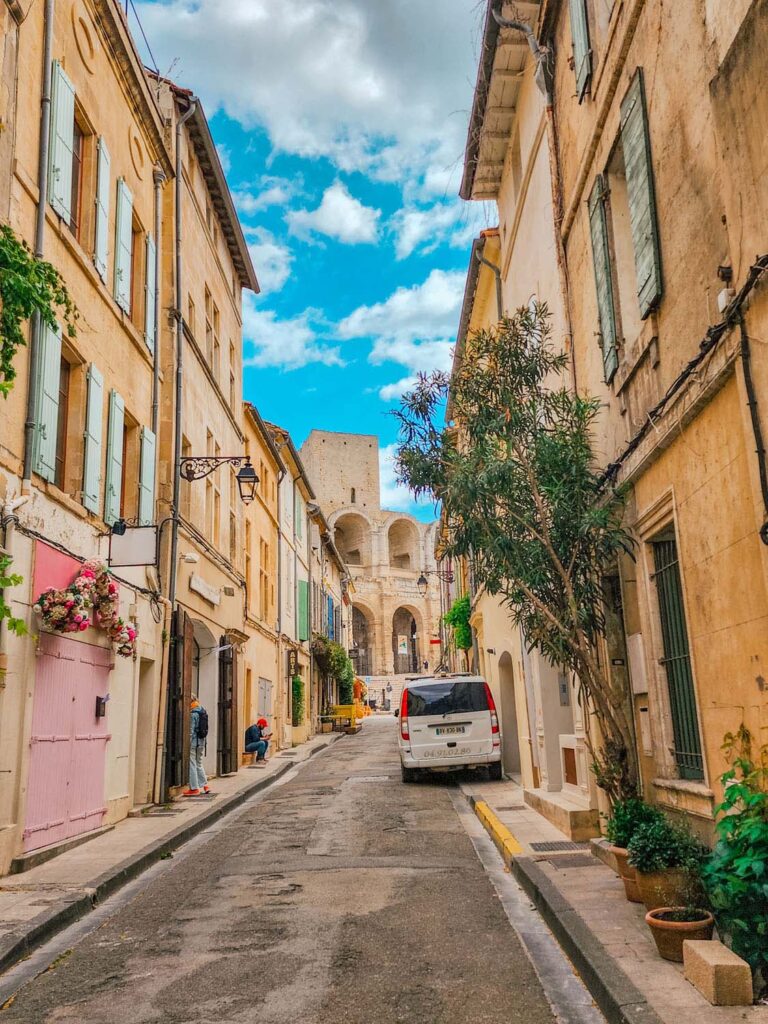
Our previous self-guided walking tour focused primarily on following in the footsteps of Vincent Van Gogh . Van Gogh lived and worked here in Arles , and some of his most prolific works of art were made during his time in his yellow house. Featured in many of his paintings were remnants of the ancient Roman ruins of Arles, as they are hard to miss and truly a part of the fabric of this city. And just like this mesmerized Van Gogh a hundred years ago, they fascinate visitors daily. So join us as we travel back in time, long before Van Gogh, to peek into the Roman and Medieval world of Arles.
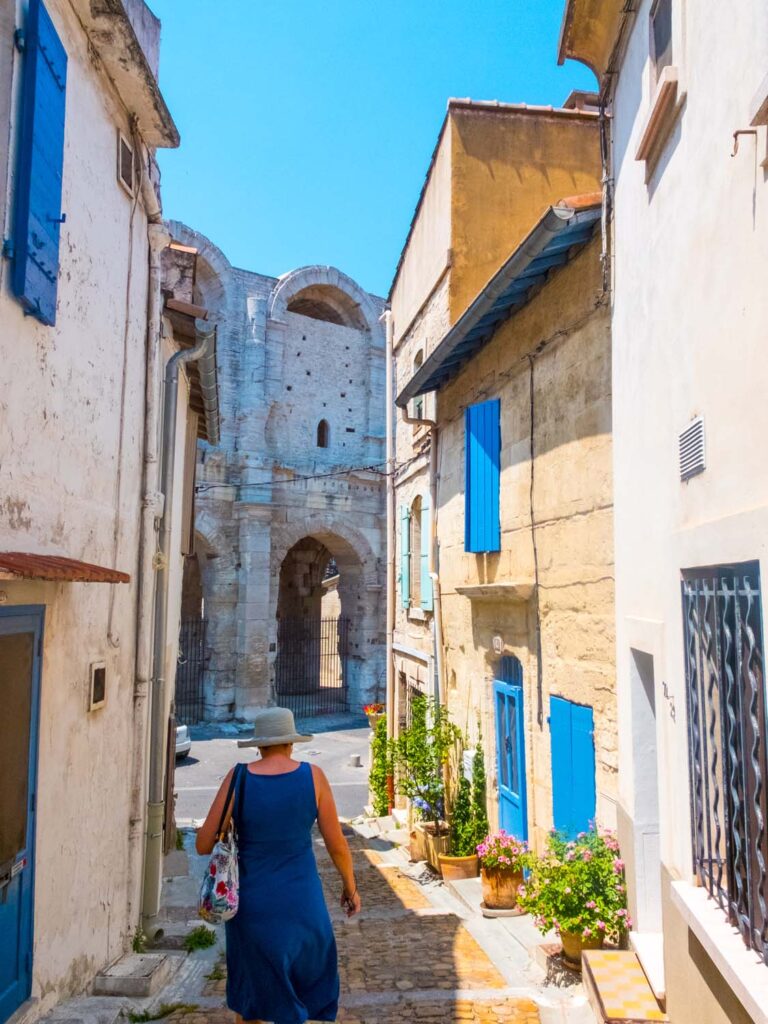
Map of Walking Tour of Ancient Arles
Arles has a rich and storied history that dates back thousands of years. The Ligurians were the first known people to inhabit this area around 800 BC. In the 2nd century BC, Arles came under Roman rule, and the village flourished with the construction of the canal connecting the Mediterranean Sea to the city. The Romans sought to build huge architectural landmarks that included the Arles Amphitheatre and the Roman Theatre, which were built during this period. Both of which we can still see prominently featured in the city today.
The Roman Era
During the Roman era of Arles, the city became a vital hub for trade due to its strategic location along the Rhône River, which made facilitating commerce and cultural exchange a breeze. As the city grew, it became the centre of arts and culture in the Roman “ Provincias ,” a Latin phrase which referred to the territories that the Roman Republic controlled. And where the name Provence came from.
Many Emperors frequently were drawn to the city of Arles. And even would use it as a home base during their military campaigns. Emperor Constantine I, especially favoured the city. Under his rule, the Roman Baths were built in Arles to mirror the Baths of Constantine in Rome. His son Constantine II was born in Arles, and his son Emperor Constantine III went on to declare Arles as the capital of Rome when he moved there in 408!
The Fall of Rome
After the fall of the Roman Empire, Arles continued to hold lots of power over the rest of the South of France. It was still a major center for trade and commerce along the Rhone River. But soon, its prominence was eclipsed by the ever-growing port of Marseilles . Since Marseille was located right along the Medieterran, they could accept larger ships from farther away into their ports. And before long, Arles ceased to hold any real political power.
Admission to Historical Sights
While many of the Roman ruins can be seen, at least in part, from outside the ticketed area, visiting the interior of many of these sights is well worth the admission fee. You get up close and personal. Explore hidden interiors, and even delve below the city to see the internal structure holding it up today.
The best ticket to buy for our self-guided tour is the Pass Avantage . This gives you access to six monuments and four museums. While that might seem like a lot, it’s mainly the monuments we’re focused on, and the museums are simply a bonus. If you are planning to spend more than one day in Arles, this is great as it will allow you more time to check out the additional museums. The ticket is valid for six months, so if you prefer to split this tour into two days, you can take everything at your own pace.
Pass Avantage Price
Adults 19€ | Reduced 16€ | Free for children under 18 accompanied by a parent. You can buy your Pass Avantage at the first stop on our guided tour.
For the most up-to-date opening hours for each stop on the tour, check this handy guide .
If you don’t want to buy the monuments and instead would rather pick and choose only a few different locations to go inside, I’ve included all the individual entry prices in this post.
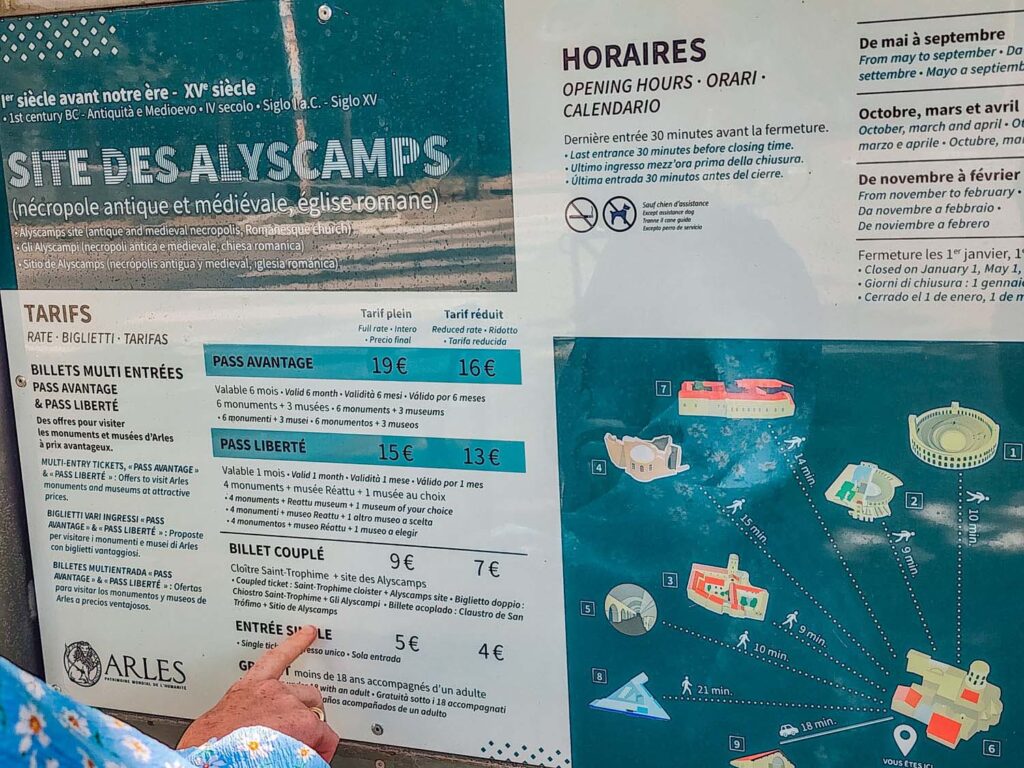
How To Get To Arles
Arles is easily reached by car via the N113 and A54 highways from Marseille or D570 via Avignon.
If you are staying in towns like Nimes, Avignon or Marseille , you can also opt to take the TER train. These trains run very frequently and are often even quicker than driving! But note that most small Provencal villages around Arles don’t have public transit. So, in that case, driving will be the only option.
Where to Park
One of the best spots to park, where there are lots of spaces, and it’s very central, is at the Parking du Centre . Along the Rue Emile Fassin . I’ve made sure to mark that on the map . Parking costs 2€ an hour. There is also a public washroom kiosk outside this parking lot. But remember, these require a 0.20€ coin to get use. I always make sure to carry some coins as often “public” doesn’t mean “free” in Provence.
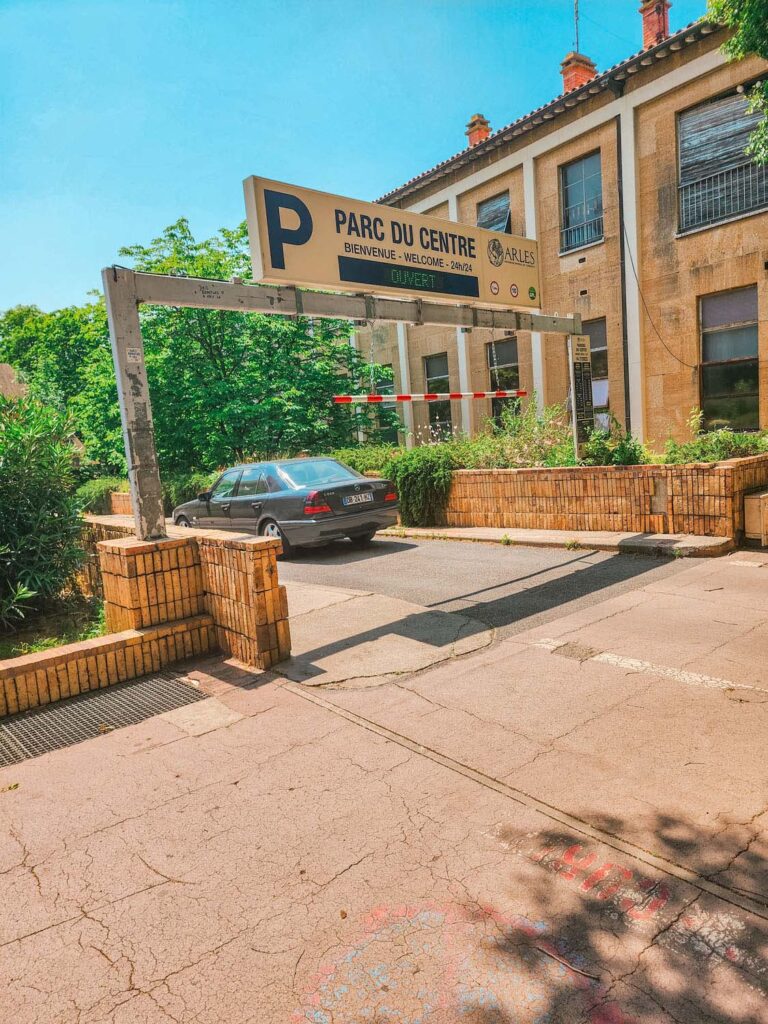
How Long is the Walking Tour
I would recommend spending an entire day in Arles. There is much to see and do besides the stops mentioned here on this tour. You’ll want to stop for food, and there are great shopping opportunities all along the colourful and quaint streets. As mentioned above, if you are staying in Arles, you can also split this tour up at your leisure. This means less walking all at once, and it will be a slightly more relaxed few days.
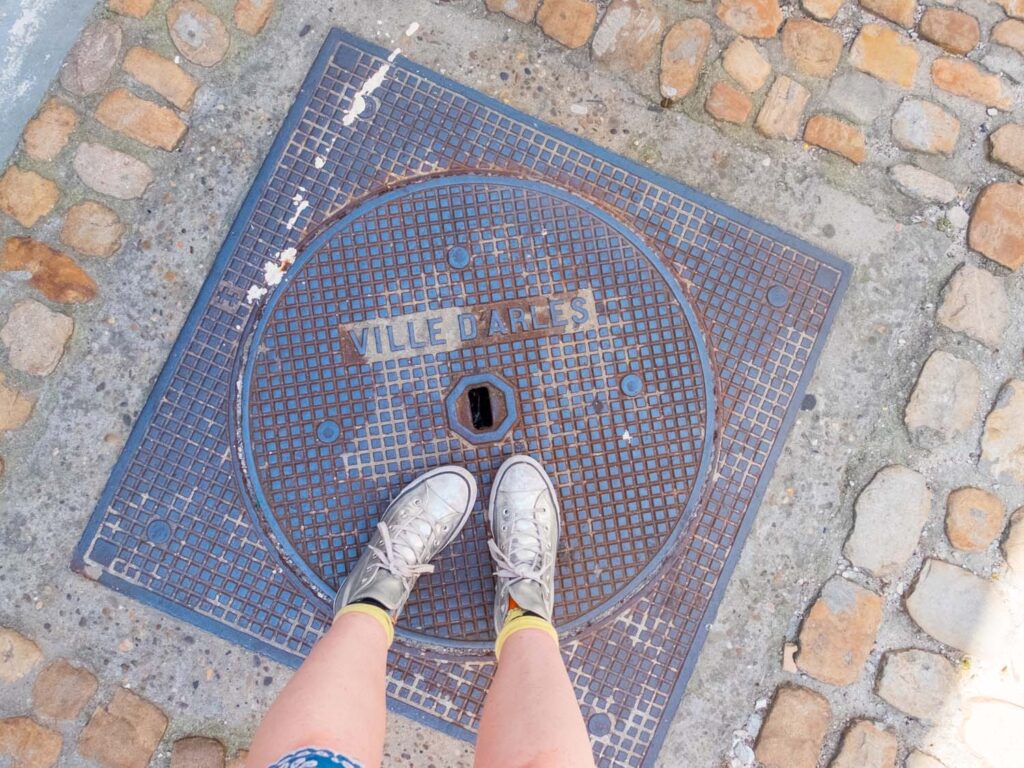
Alyscamps, the Roman Necropolis
Our journey back hundreds of years to ancient Arles begins on the city’s edge. Along what was once the ancient Roman road to Aurelia. Here hides a great Roman cemetery dating back to the 4th century AD. Behind the tall iron gate and under rows of poplar trees, we find the archaic Alyscamps, a Roman Necropolis .
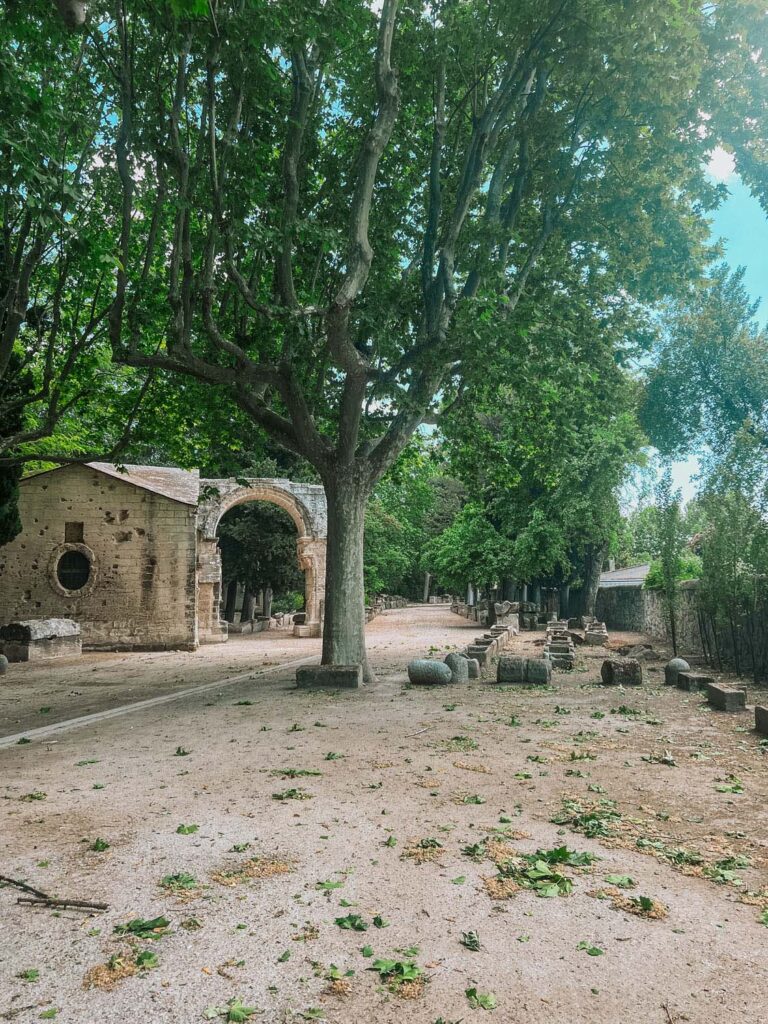
“ Alyscamps ” is a corruption of the original Latin name Elisii Camp . In English, we call this the Elysian Fields, which in Greek mythology refers to the afterlife paradise for heroic and virtuous souls.
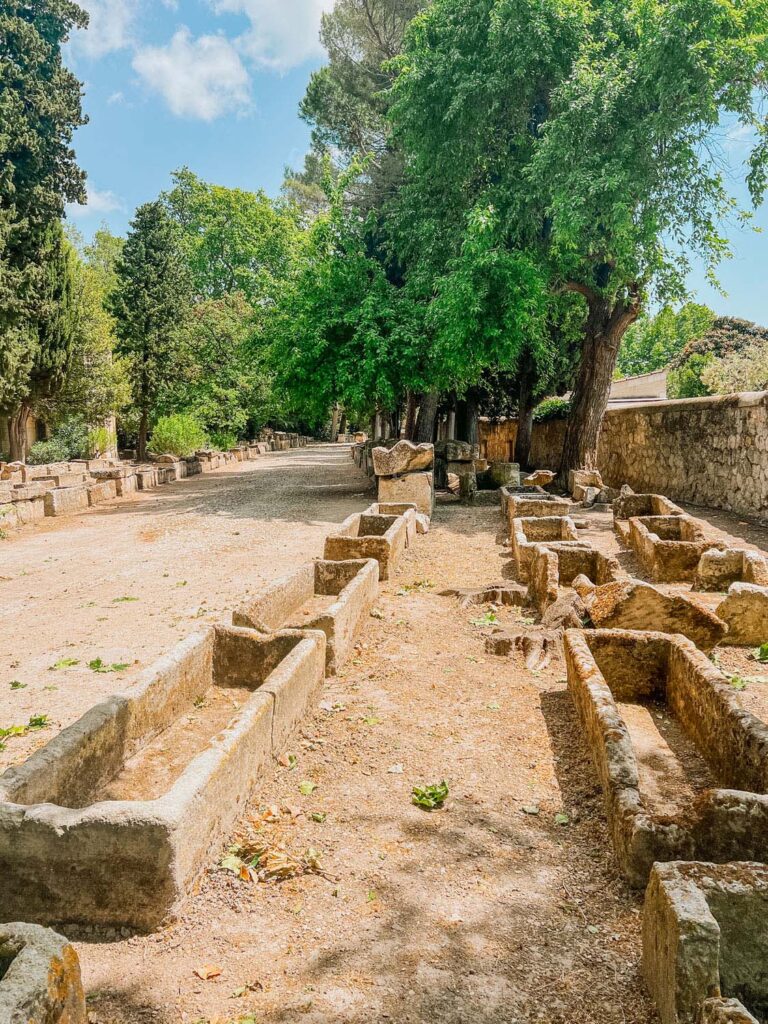
History of the Alyscamps
During the Roman Empire, burials were not allowed within the city limits. Therefore, it was commonplace for the roadways leading into cities to be lined with tombs and mausoleums. The cemetery followed the Roman practice of inhumation. Inhumation dates back at least to the Middle Paleolithic period. The oldest form of inhumation was done by hollowing out a trench in the ground and covering the body with rocks and dirt.
But for the Romans, buried their deceased in the ground inside stone tombs or sarcophagi. The burial ground accommodated various social classes, from common citizens to prominent figures of the time. This included everyone from military officers to merchants. Strolling down the main road, you can still see hundreds of these old sarcophagi and tombs lining the ancient Roman road. Stop to look at some of the details which can still be seen on these tombs, which are almost over 2000 years old.
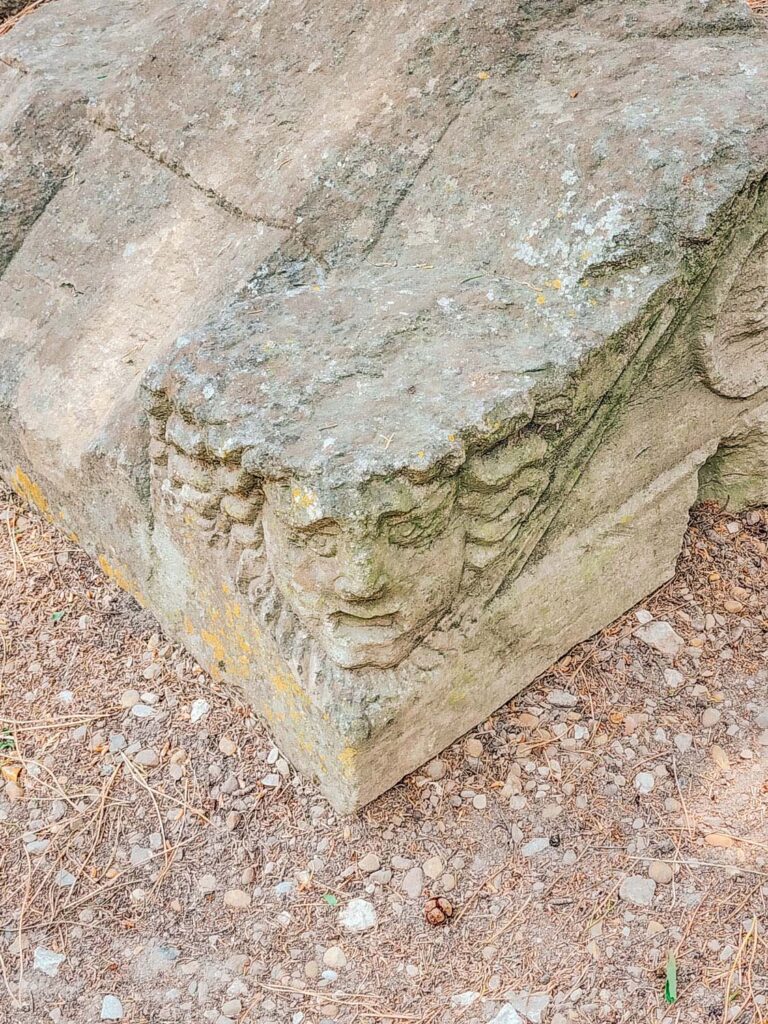
The Saints of the Alyscamp
With the spread of Christianity, the Alyscamps gained even greater significance. This was largely because Saint Genesius was buried here after his beheading and subsequent martyrdom. Saint Trophimus , the first Bishop of Arles, was also buried here. With these high-profile burials, people from all over the country started to want to have the honour of being buried here. The Rhone River became somewhat of a burial highway. Families had their loved ones shipped on boats in from all over Europe to be buried in such a distinguished cemetery. And tombs had to be stacked three layers deep to accommodate the influx.
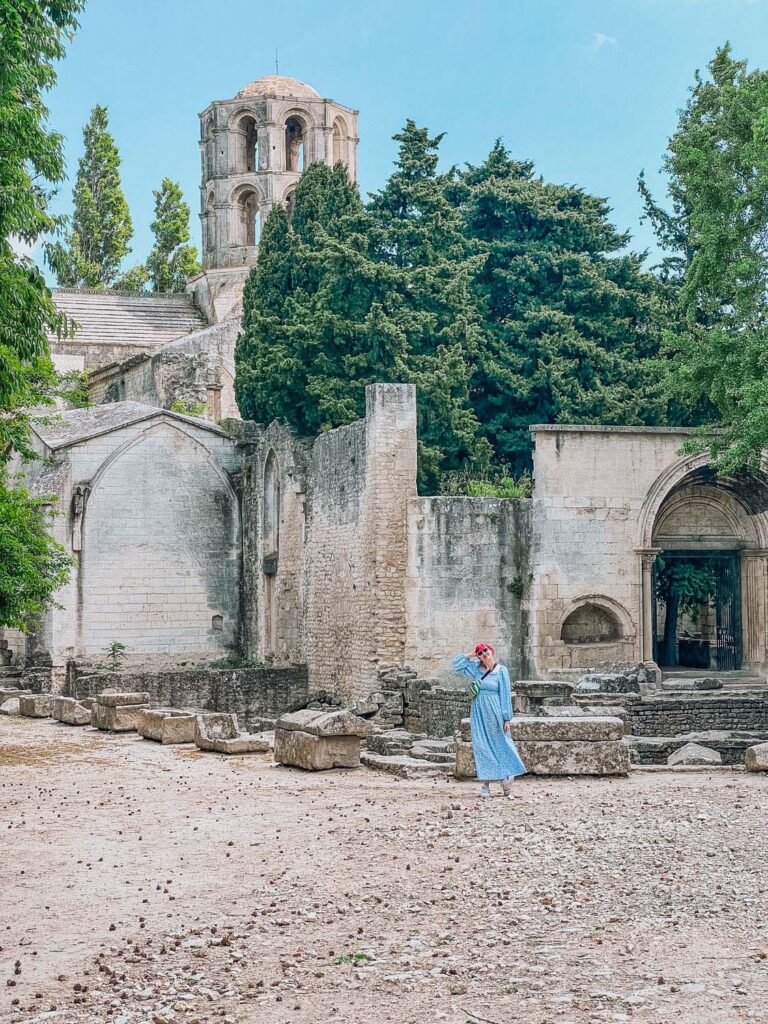
The Decline of Alyscamps
But in 1152, Saint Trophimus’ relics were moved to the Arles cathedral. This was the start of the end for the Alyscamps. Having lost its most important “resident,” its popularity dried up. And within a hundred years, the site was abandoned, and the tombs were systematically looted. Sarcophagi were given as gifts to distinguished visitors of the city. And many of the gravestones were dismantled to use as building materials. Some sarcophagi were even used as water troughs for cattle.
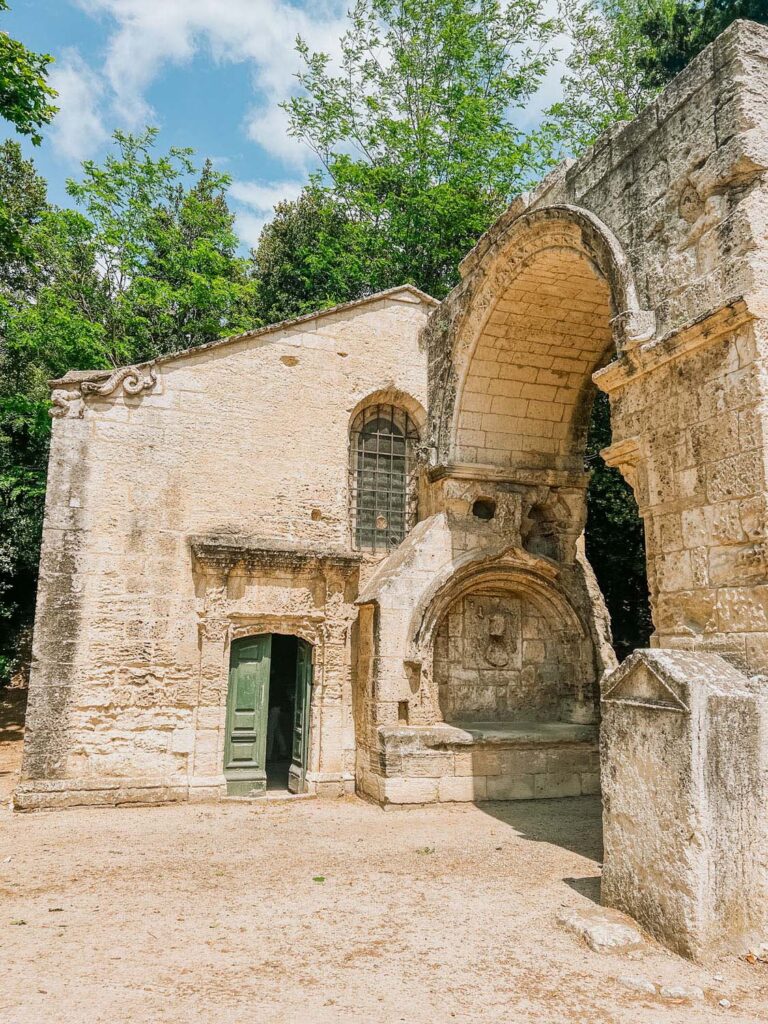
Van Gogh’s Alyscamps
But the Alyscamps never lost its natural beauty. And during the 19th century, the locals started to use it as a public park. Here they could stroll and remark on the ancient graves still present in the rubble. It was a favourite spot for Van Gogh when he lived in Arles . He even made a point to bring his fellow painting partner Paul Gaughin to the Alyscamps. Here each one made their own interpretation of the site’s picturesque and evocative atmosphere. To learn more about Van Gogh’s time in Arles, read our dedicated Van Gogh-ian Self-Guided Tour of Arles .
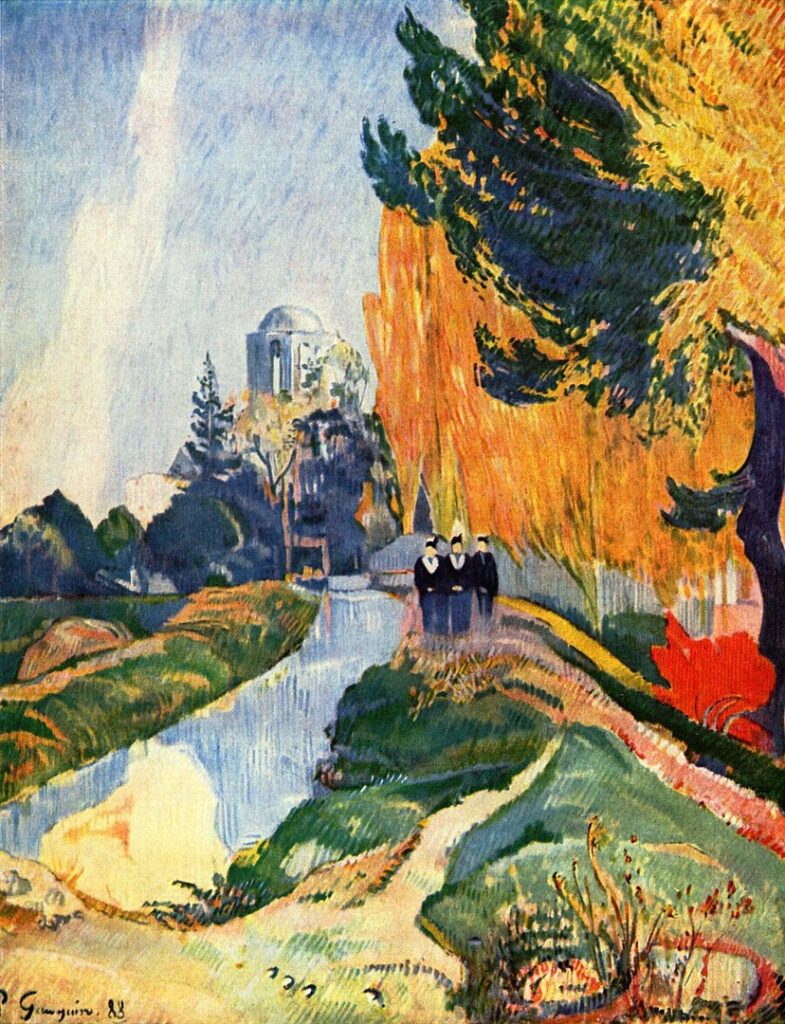
The Eglise Saint Honorat
Saint Honorat was Archbishop of Arles in the 3rd century. When he died in 429 AD, his tomb became a prominent pilgrimage site for the early Christians. In the mid-11th century, a Romanesque church was built inside Les Alyscamps and named after him. Much of the old church has fallen into ruins, but the east and west aisles still survive today. As well as the massive lantern tower that dominated the skyline inside.
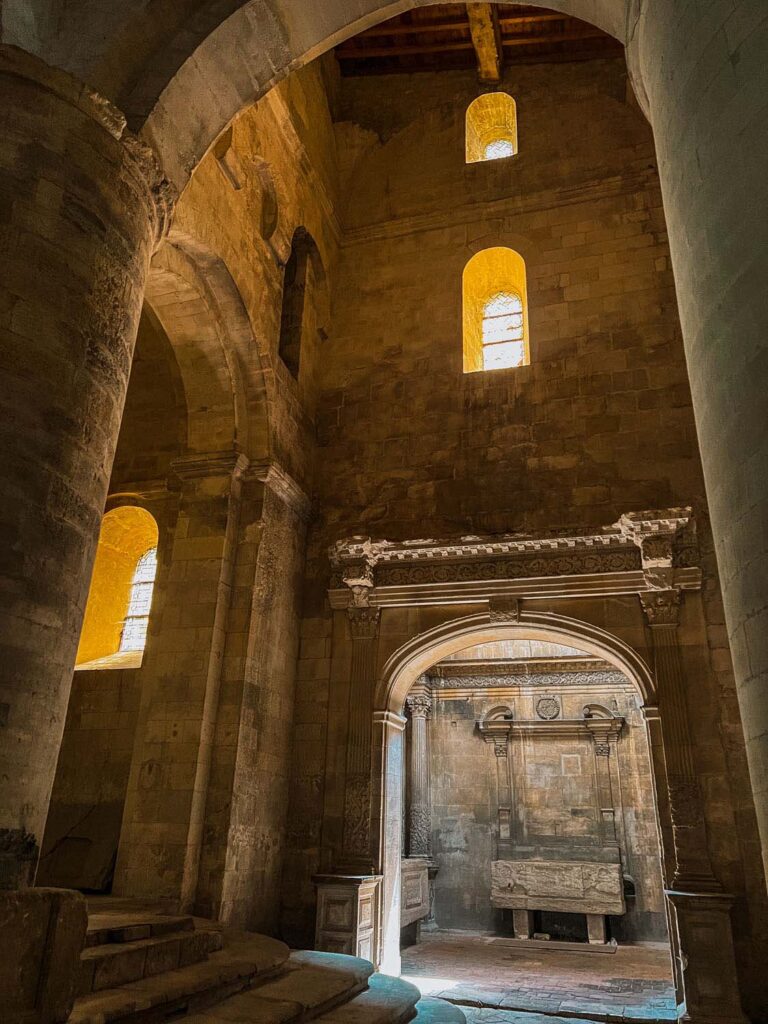
The building has almost entirely been left to the elements, and yet there are so many aspects of the original architecture that you can study inside. It’s a forgotten treasure, and even without being covered in stained glass and lavish ornamentation, there is such an earnest beauty to this church.
Individual Entry Price for Les Alyscamps: 5€
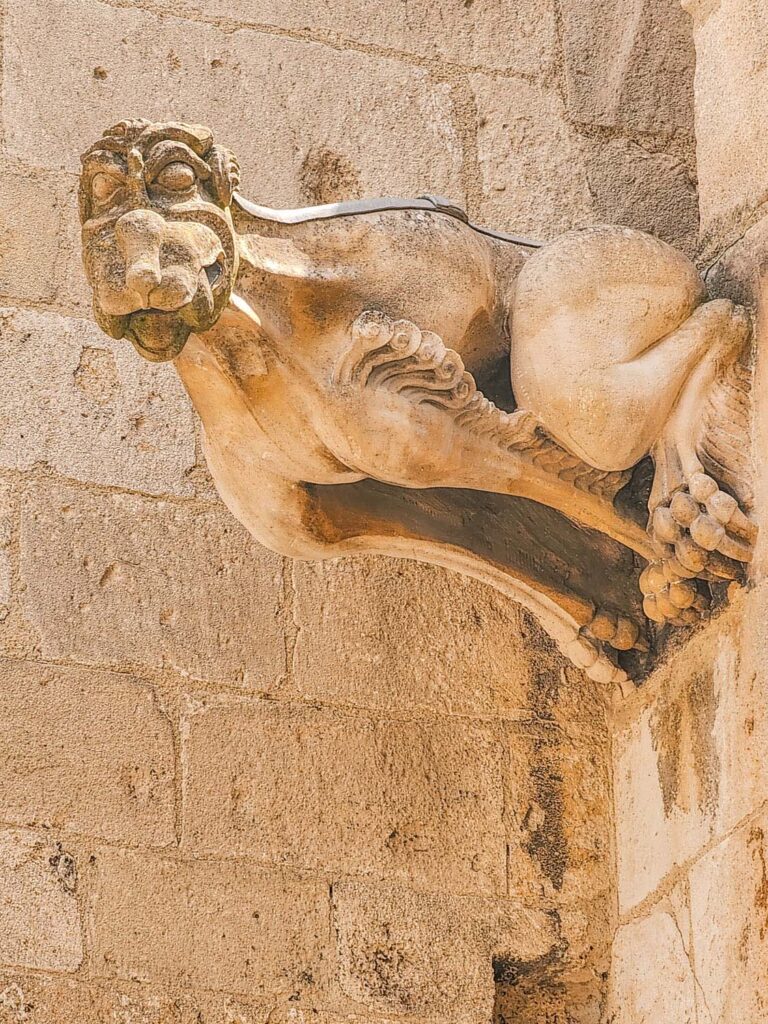
Tour des Mourgues
Walk northwest along Avenue des Alyscamps . On the northwest corner of Boulevard Emile Combes , you’ll see a great stone wall called the Tour des Mourgues . The Mourgues Tower is the most well-preserved of the circular towers that flanked the city’s defensive ramparts. The tower gets its name from the nearby monastery founded by Bishop Césaire in the 6th century. The monastery was the primary residence of nuns (called morgues in Latin.) Initially, The tower was circular but modified in the 14th to this more octagonal appearance.
View this post on Instagram A post shared by V A P (@madame_butterfly_clichy)
Théâtre Antique d’Arles
Walk along Mnt Vauban street, turning up the Rue de la Calade as it curves around the back of the iconic Roman Theatre . Built in the 1st century BC, this well-preserved theatre was built to accommodate up to 8,000 spectators! The theatre was constructed during the reign of Emperor Augustus . Unlike the Colosseum or Roam Amphitheatre, which were the centre of gladiatorial events, this building served as a venue for various theatrical performances. Much lighter and less violent entertainment for the Roman public to enjoy.
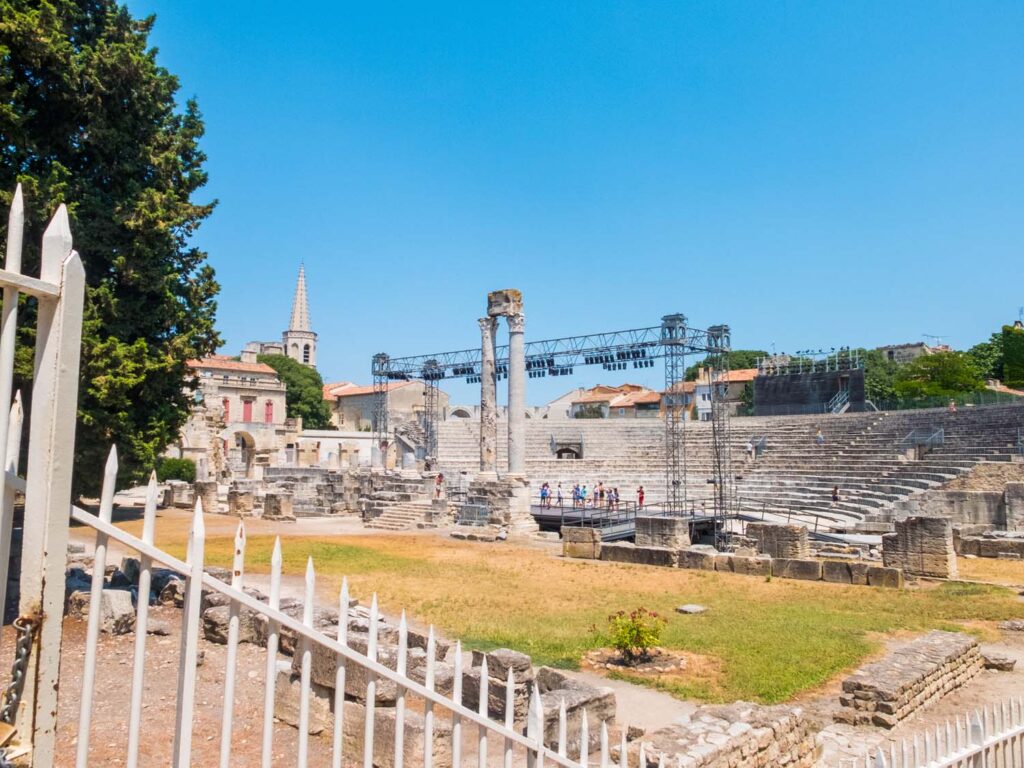
History of the Roman Theatre of Arles
The theatre’s design resembles a Roman amphitheatre which has been cut in half. Rows and rows of tiered seating are wrapped around the stage in a semi-circular shape. The structure is built into the side of a hill, maximizing its acoustics and providing excellent views of the stage from all angles. Originally, the would have been a wooden roof and a large rear wall at the back of the stage. Today, only the orchestra section, seating rows, and two large Corinthian columns survive. Little more than a few pieces of rubble remain of the once impressive rear wall, which would have acted as a theatrical backdrop for the actors.
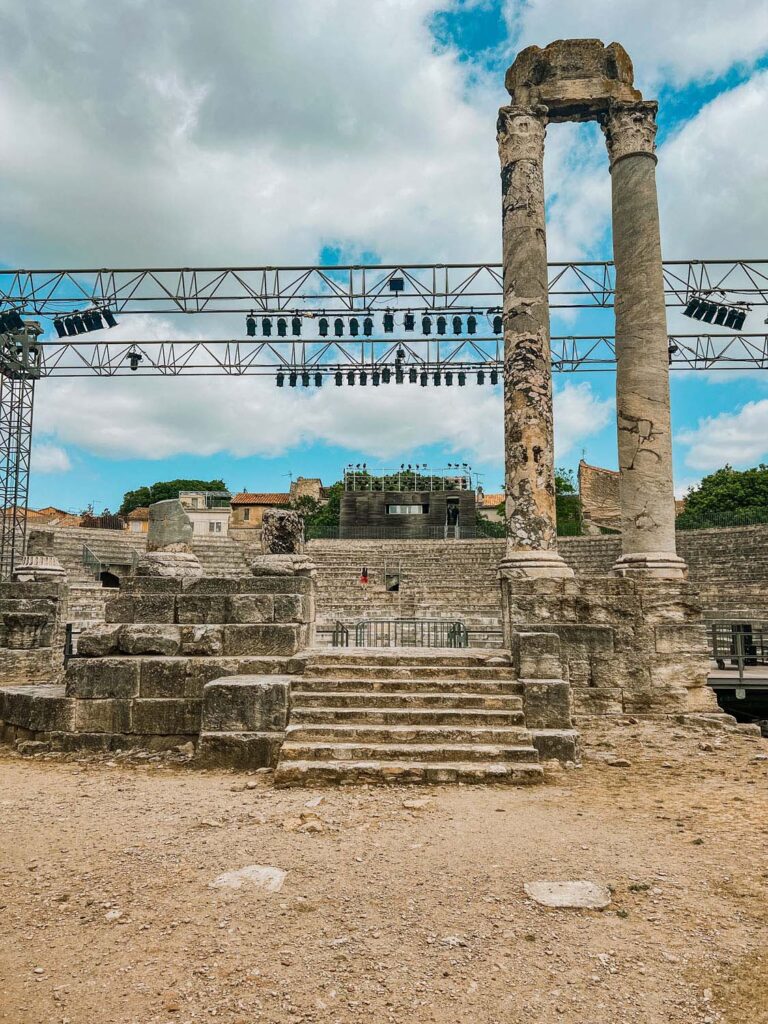
As a Roman citizen of Provence, you could attend everything from theatrical plays, musical performances, poetry readings, and political and religious gatherings here in the Roman Theatre. Just as theatre is today, this place would have been essential to the town’s social and cultural life.
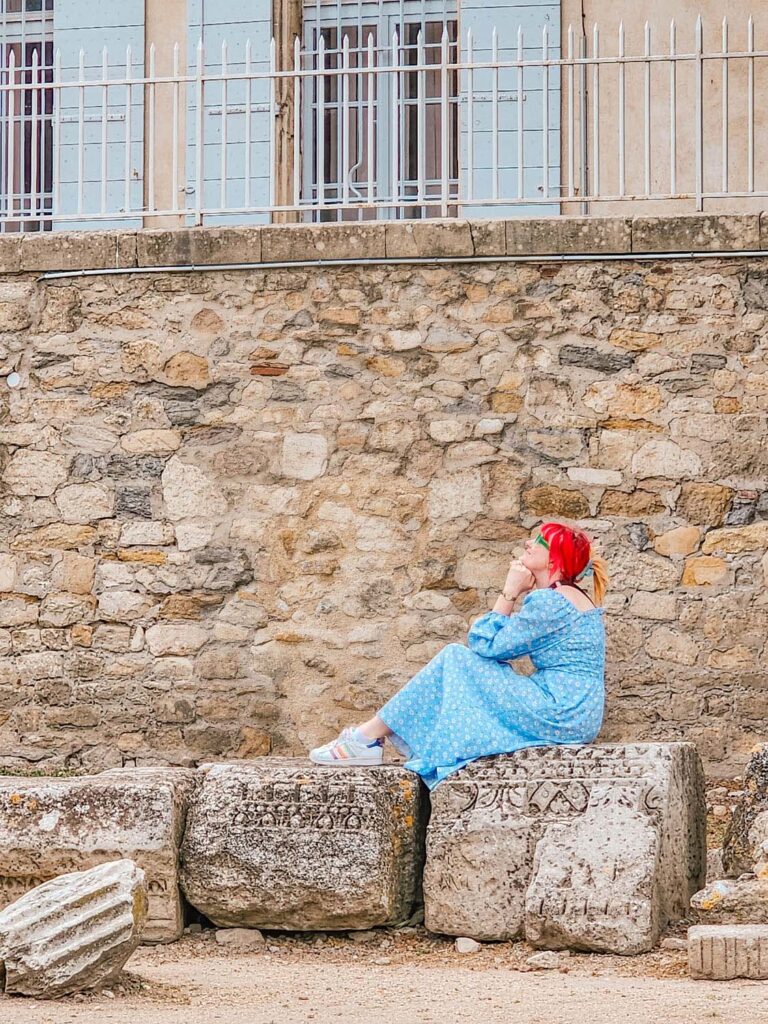
Like many other ancient Roman structures, the theatre gradually disappeared during the Middle Ages. Over the centuries, parts of the theatre were repurposed for other constructions. The ruins were later rediscovered and excavated during the 19th and 20th centuries.
Today, this theatre is still used for the very same purpose it once was, to host musical and theatrical events. When we visited, they were performing a soundcheck for the concert later that evening. The scaffolding of the lighting rig carefully places around the stone outline of the old stage. It is so nice to see these sites still in use today, rather than simply being a relic of a bygone era.\
Individual Entry Price for Roman Theatre of Arles: 9€
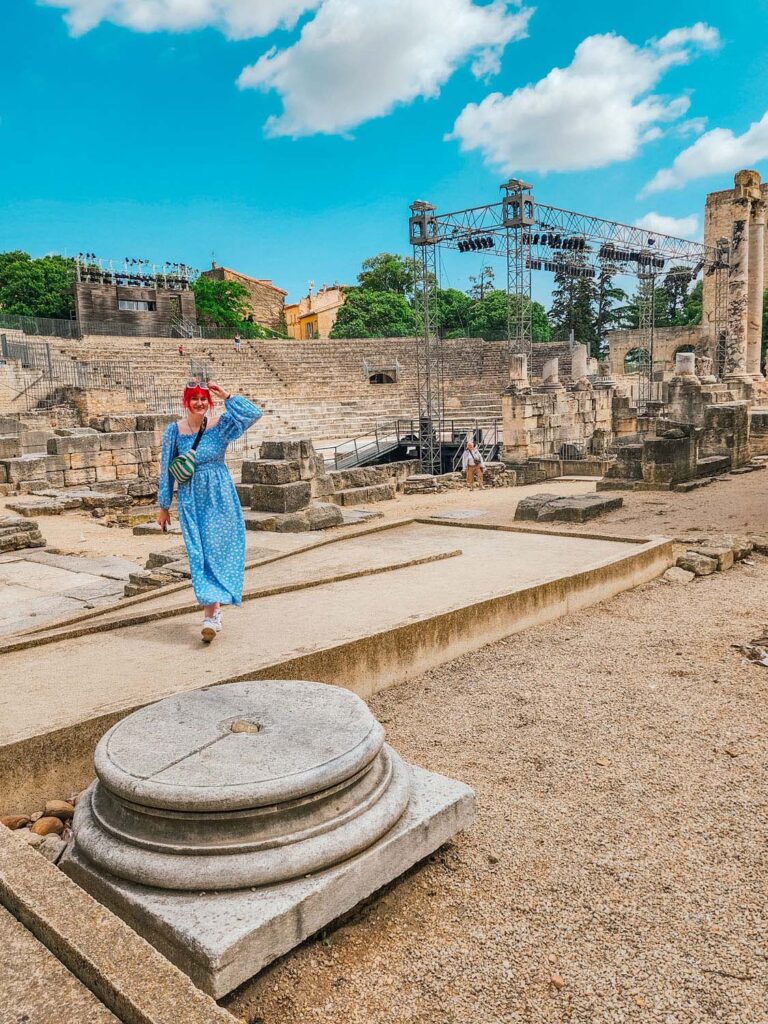
Arles Amphitheatre
Make your way back onto the Rue de la Calade onto the Rue Porte de Laure , which wraps around the giant arches of the majestic Arles Amphitheatre . The Arles Amphitheatre dates back to 90 AD. The Arena was primarily used for hosting various public spectacles and gladiatorial games. This enormous Arena could hold an estimated 20,000 spectators.
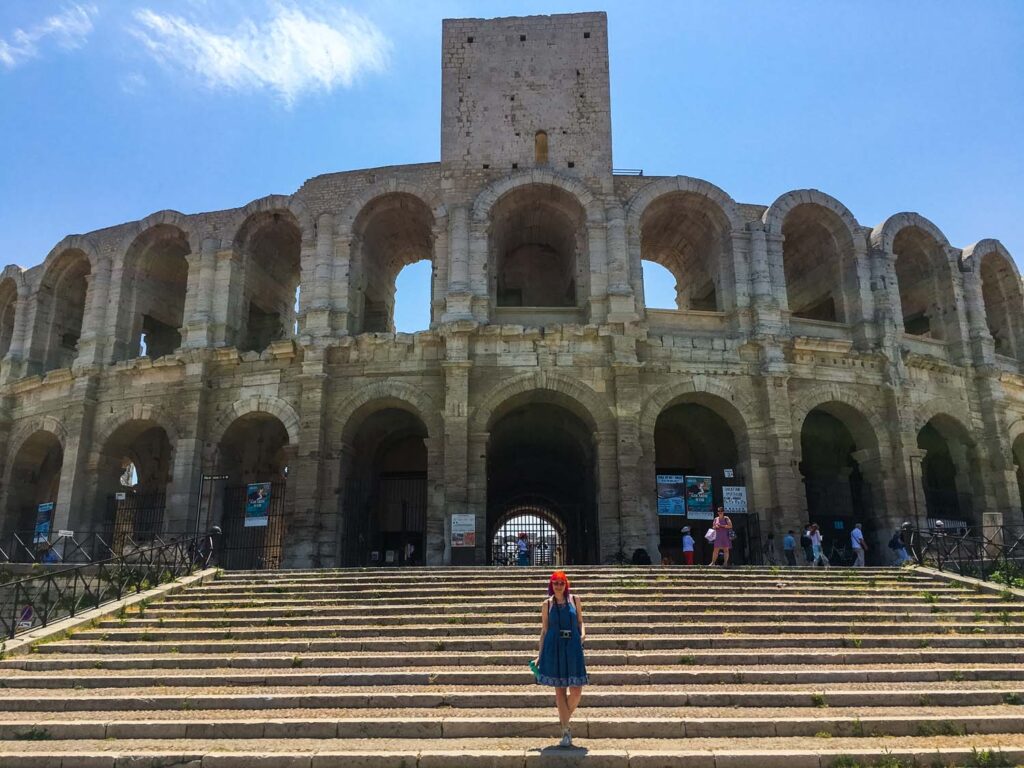
Gladiatorial Events
Gladiatorial contests were a central part of Roman entertainment. These events served to entertain and satisfy the masses while also reinforcing the power and authority of the Roman Empire. These battles were thrilling and often brutal spectacles in the Roman amphitheatre.
Gladiators in Arles were typically slaves, prisoners of war, or condemned criminals who were forced to fight to the death for the audience’s amusement. These fighters were trained in specialized gladiator schools, known as ludi , where they honed their combat skills and developed signature fighting techniques.
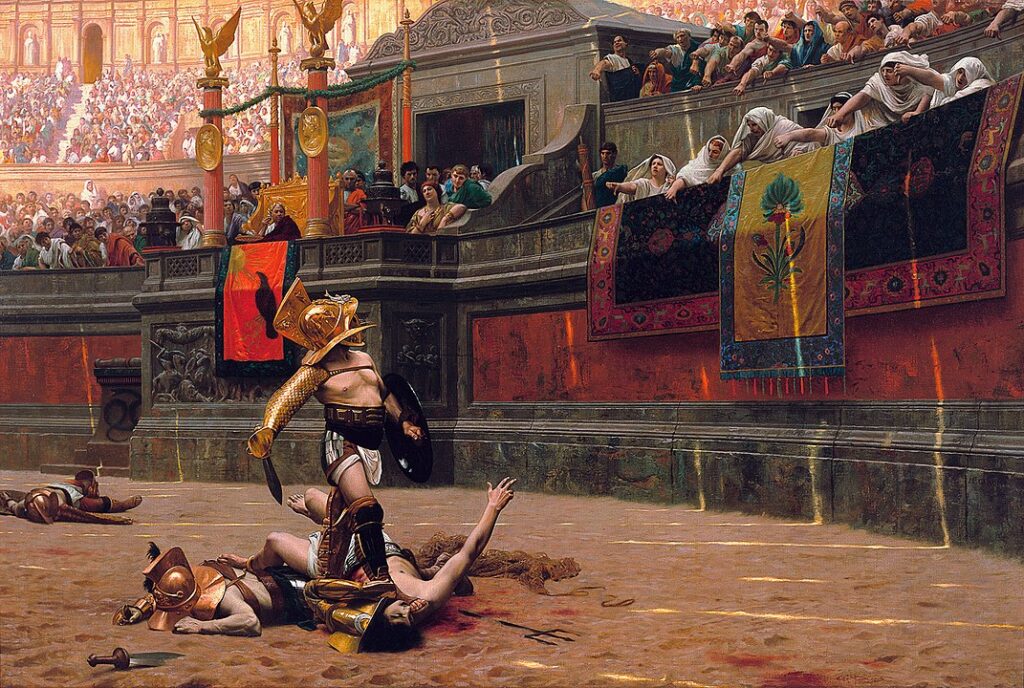
The spectacles in Arles included various forms of combat, such as one-on-one duels, group battles, and even confrontations with wild animals like lions and bears. The contests were often organized and sponsored by wealthy individuals or the Roman government to gain popularity and political influence.
As social attitudes changed, the demand for such violent spectacles waned. And by the 5th century AD, the tradition of gladiatorial games in Arles began to fade, and the amphitheatre was eventually repurposed for other activities.
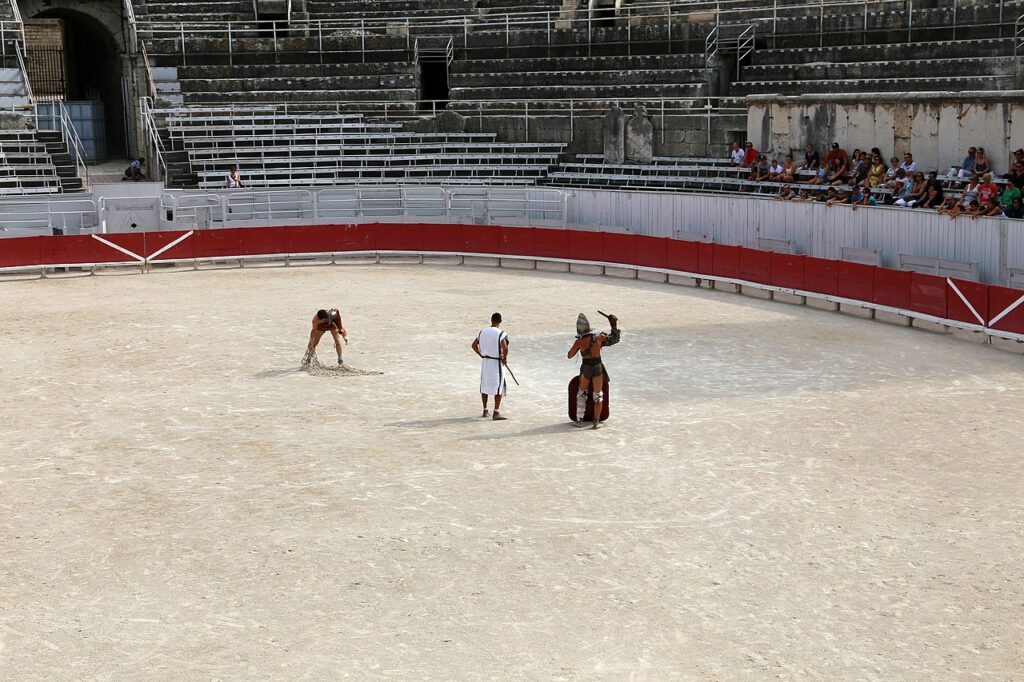
Amphitheatre in the Middle Ages
After the fall of the Roman Empire, the theatre’s purpose shifted. In the Middle Ages, it was transformed into a fortress to protect the inhabitants of Arles. Four towers were added to either side of the fortress to keep a lookout over the city. Houses, stables, and workshops were built right into the arches of the arena. It was indeed a town within a town, with a square where the arena once stood. There was even a chapel inside. If you look closely at the walls when you enter, you can still see holes where different structural supports were installed to build two-story houses inside the archways.
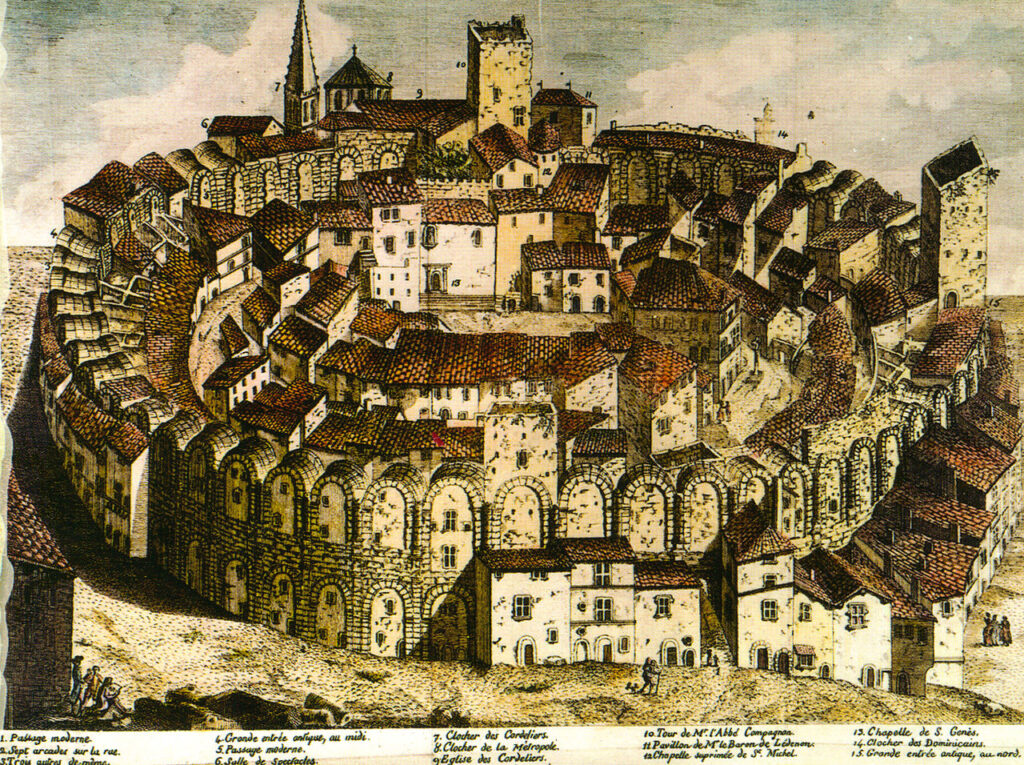
Arena Layout
Entering this elliptical-shaped amphitheatre, you can really appreciate how this is a masterpiece of Roman engineering and architecture. It measures about 136 meters long and 109 meters wide, and its exterior reaches a height of around 21 meters.
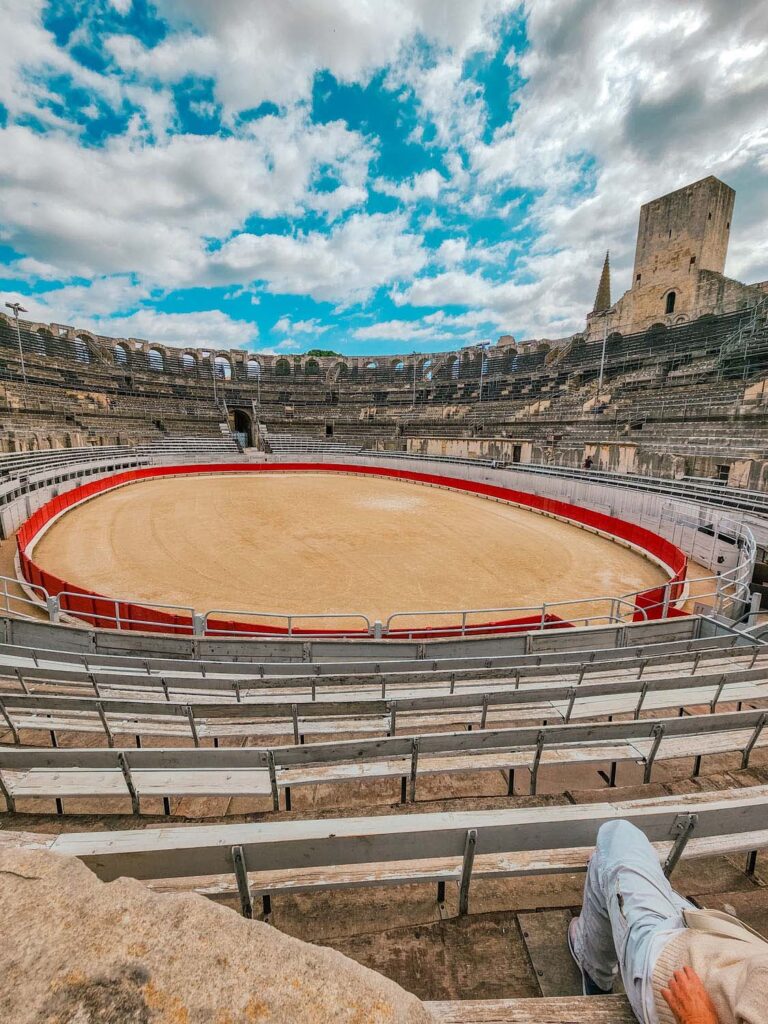
The structure consists of two levels of arches, a grand entrance, and a complex system of corridors, galleries, and staircases that allow easy access for spectators. You can access almost all these areas today with your entry ticket. Allowing you to really get a feel of the entirety of the arena.
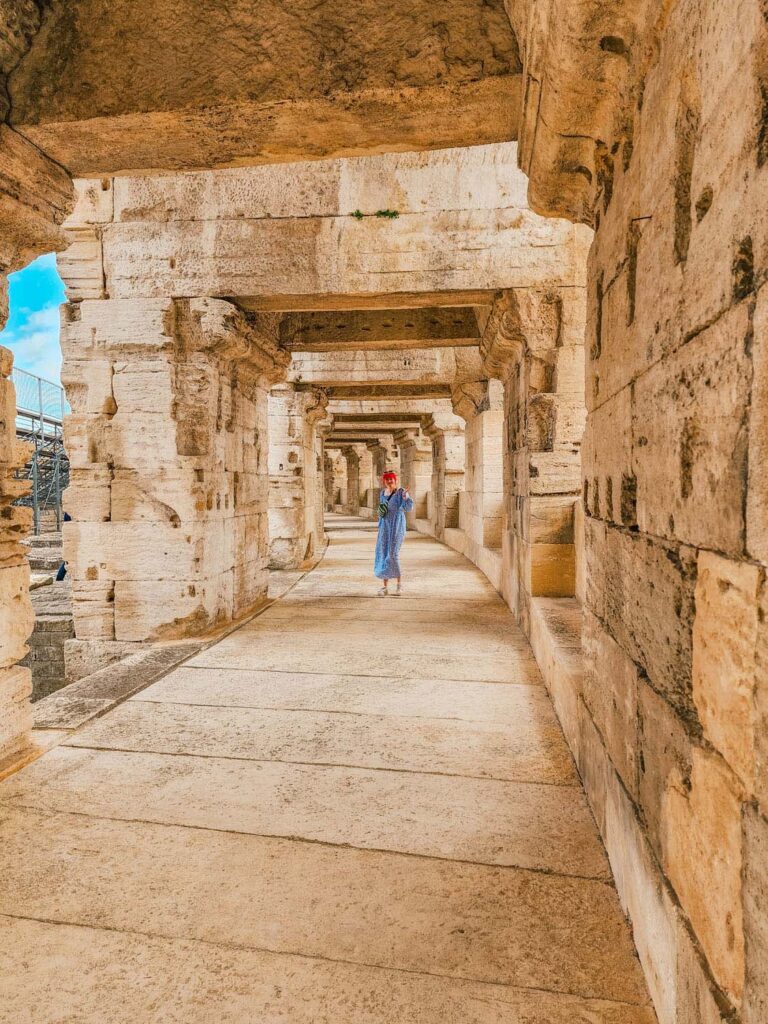
The Interior
While the main attractions were gladiatorial contests, other events included mock sea battles, animal hunts, and public executions. Climb to the top of the Arena for the most incredible panoramic views of the city and the surrounding countryside.
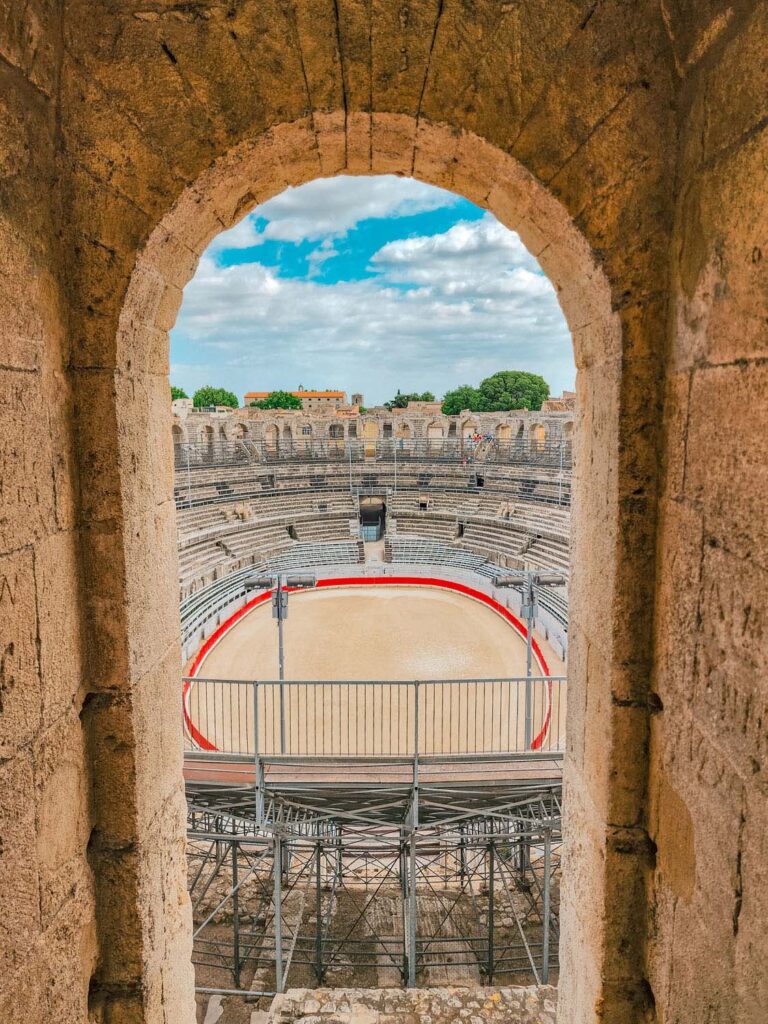
Bullfighting
In the 19th century, efforts were made to restore and protect this iconic structure. But instead of hosting Gladitorial events, it was repurposed into a bullfighting arena. Bullfighting in Provence is known as “ Course Camarguaise. ” It differs from the well-known Spanish-style bullfighting in that the bull is not killed in the theatre. Moreover, the focus is on the agility and daring of the participants rather than inflicting harm on the animal.
View this post on Instagram A post shared by Charles Desmarais (@artguypix)
During Course Camarguaise, agile and skilled participants, known as “ raseteurs ,” attempt to remove small tassels or rosettes attached to the bull’s horns. The raseteurs use a claw-shaped hook called a “raset” to try to grab them. The objective is to demonstrate their bravery and deftness in evading the charging bull while trying to collect as many rosettes as possible. All the while dressed in spectacular costumes that sparkle and shine in the sun and impress a captive audience. Van Gogh himself loved to frequent these events and even captured a vibrant scene in the arena of spectators viewing the bullfighting games.
Individual Entry Price Arles Amphitheatre: 9€
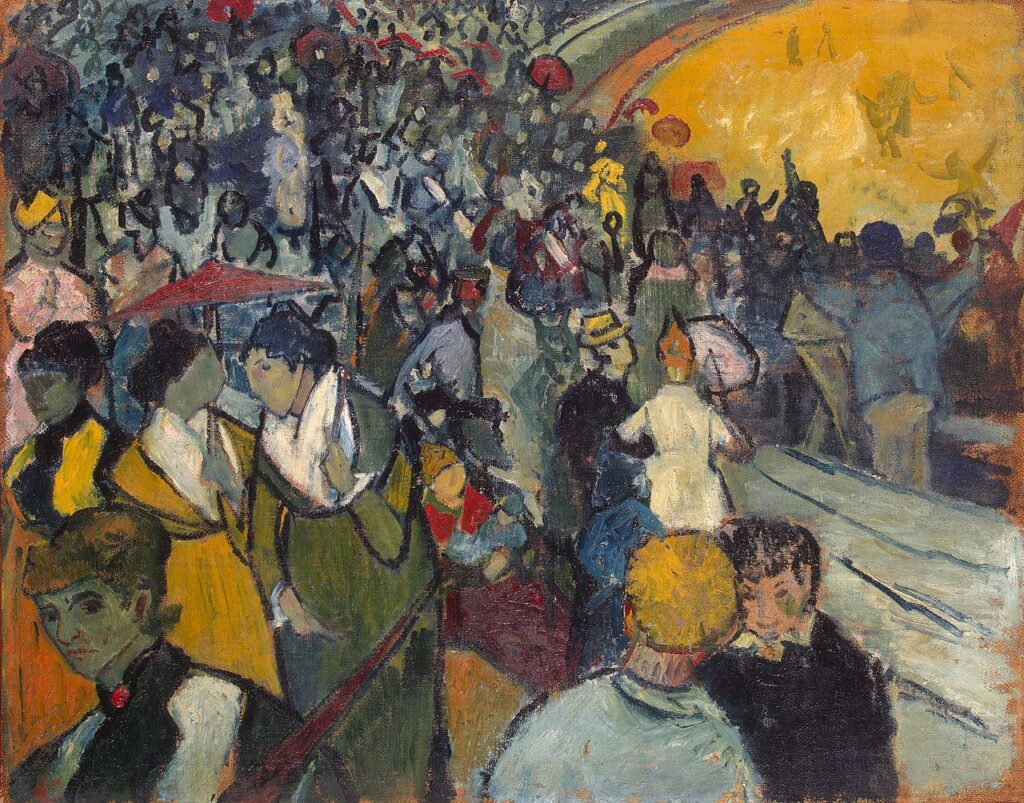
Rue Voltaire
After finishing touring the Amphitheatre, take a walk away along the Rue Voltaire . But sure to look back down the street towards the Amphitheatre as I loved this framed view of it.
The Rue Voltaire is an adorable cobblestone street flanked on all sides by charming shops, crawling ivy, and those classical Provencal brightly painted window shutters. This is the perfect place to grab a bit to eat, as the people-watching opportunities along this road are unmatched.
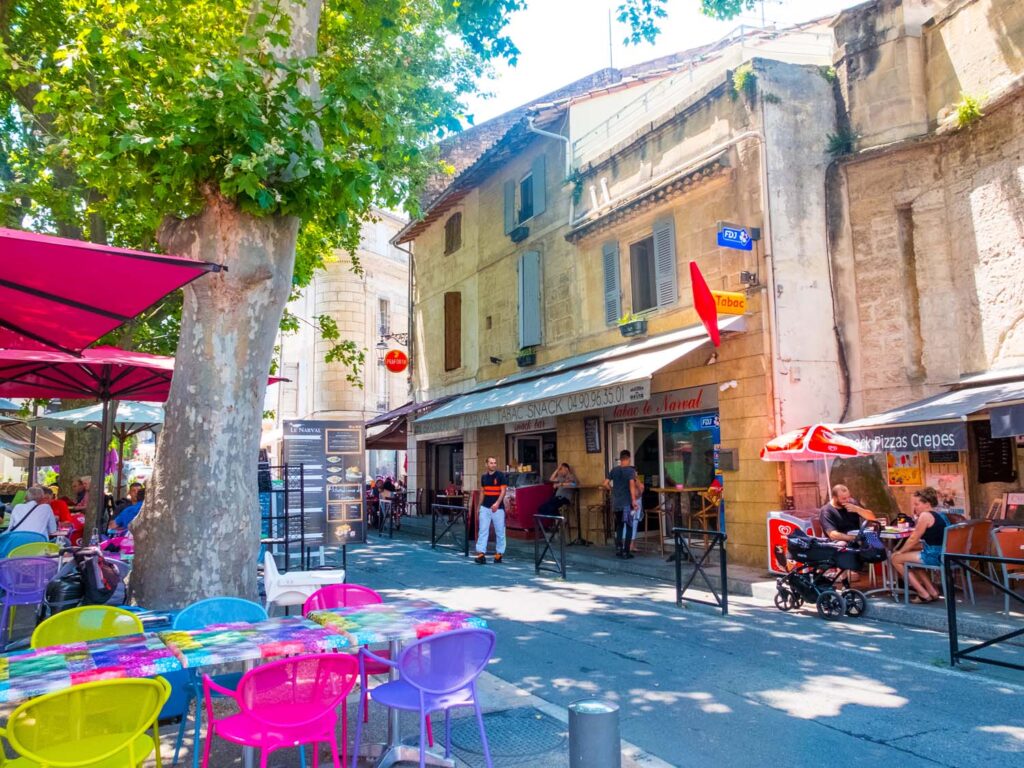
Bistrot le Mistral is a great choice for a hyper-local French menu that changes daily. Don’t let the handwritten chalkboard menu scare you away. Chalkboards are the best indication that the food is fresh, as it signals the dishes change with the season or, indeed, with the daily whims of the chef! For such artistic French plating, the prices are very affordable. A must-check out while you’re in town
View this post on Instagram A post shared by 🧿Le Mistral🧿 (@lemistral_arles)
Amédée Pichot fountain
Returning to the road, stop to admire the incredible Amédée Pichot fountain , found at the intersection of Rue Amédée Pichot and Rue Voltaire. This elegant fountain and accompanying mosaic were built in honour of the 19th-century journalist and writer Amédée Pichot . The installation was a love letter from Pierre-Amédée Pichot to his father. When his father was alive, he purchased a monumental painting from French artist Paul Balze at his salon in Paris. The painting was an allegory of poetry inspired by a painting by Raffaello. Before Amédée Pichot died, he wanted to gift the painting to the people of the city of Arles. So they could enjoy its beauty instead of the painting being cooped up inside his house. But the city couldn’t find an appropriate location, and his dream was abandoned.
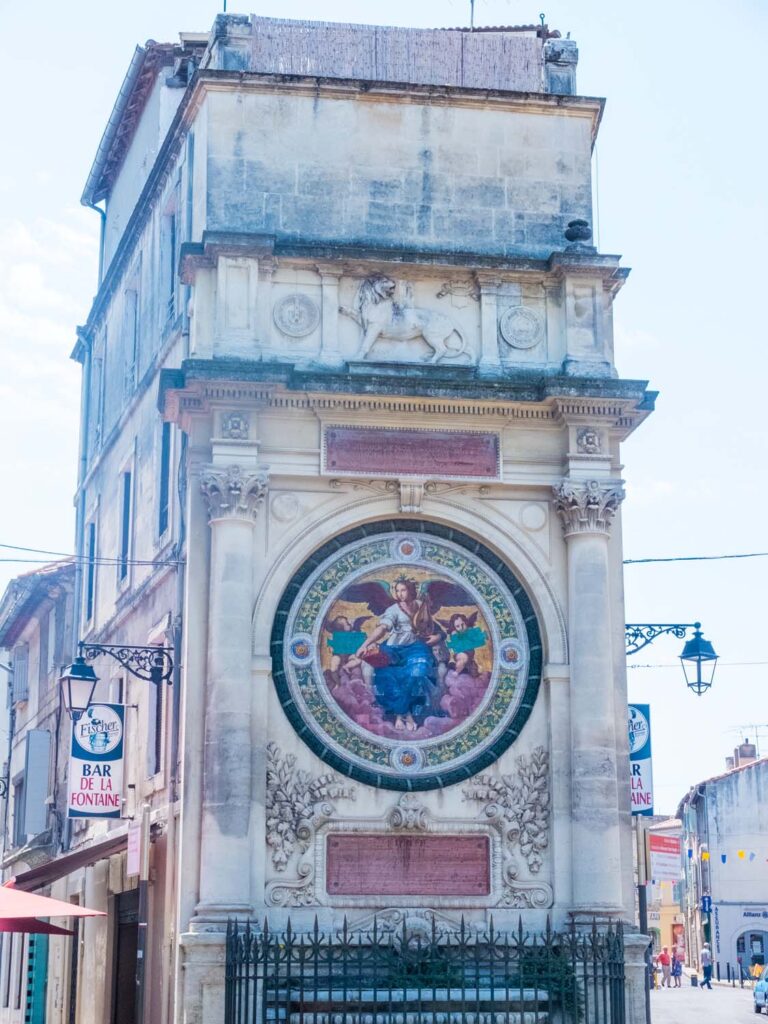
After his father died, Pierre-Amédée Pichot was driven to accomplish the goal that his father had abandoned. On a recent visit to Paris, he was inspired by the fountain outside the Place Saint Michel, which stood on the exterior of a large wall. Pierre managed to buy the house on the corner along Rue Voltaire to use its prominent exterior to build this monument. But you can’t simply hang a painting outside in the elements. So instead, he had a great reproduction artist reproduce the painting on enamel ceramic tiles. Now the painting is preserved in enamel and hanging in such a place of honour. Drawing the eyes of all those who pass it by.
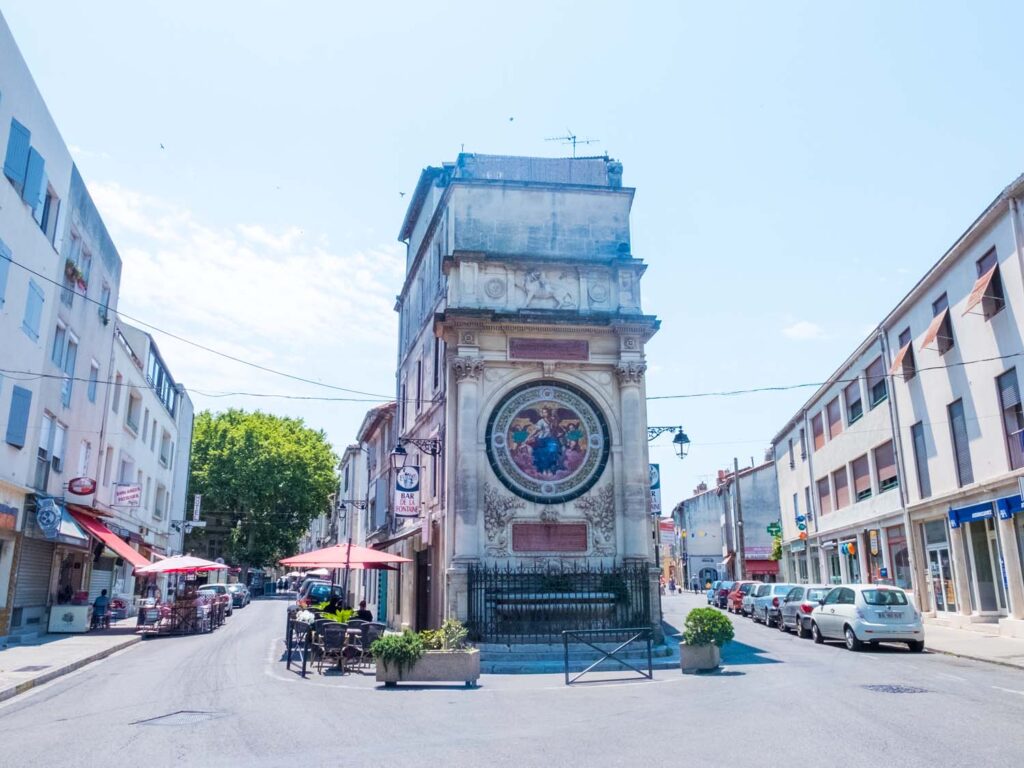
The Porte de la Cavalerie
At the end of the Rue Voltaire stands the great Porte de la Cavalerie , also known as the Cavalry Gate . This ancient Roman gate was where people would have entered the city for the first time along the long road to Arles. The enormous, crumbling, stone defensive walls date back to the 3rd century AD. Sturdy stone towers on either side of the arched opening are called the “ barbicans .” They were designed to reinforce the gate’s defensive capabilities, allowing guards and soldiers to monitor and defend the entrance effectively.
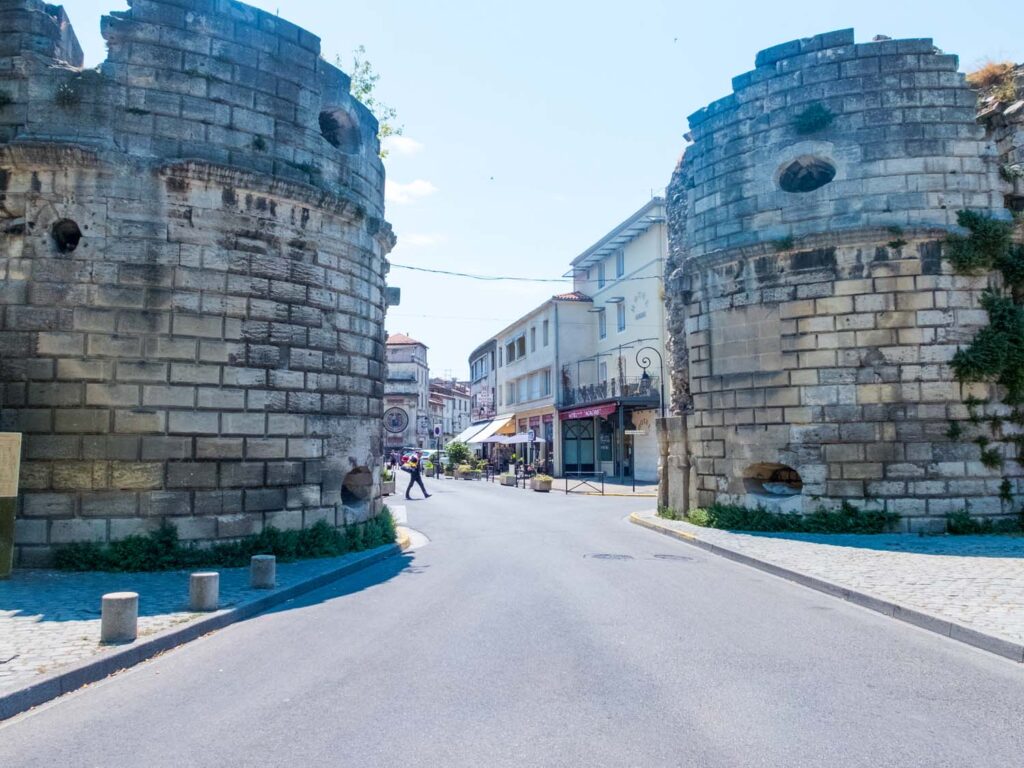
Quay Marx Dormoy
Walk through the gates and turn west along the Quay Marx Dormoy, which curves around the famous Rhone River . René Marx Dormoy was a French politician. During his tenure as mayor, he played a significant role in French politics and administration, advocating for social reforms and progressive urban development. Dormoy’s commitment to public service and contributions left a lasting impact on the communities he served, and he is given pride of place here in Arles with such a picturesque pathway named after him.
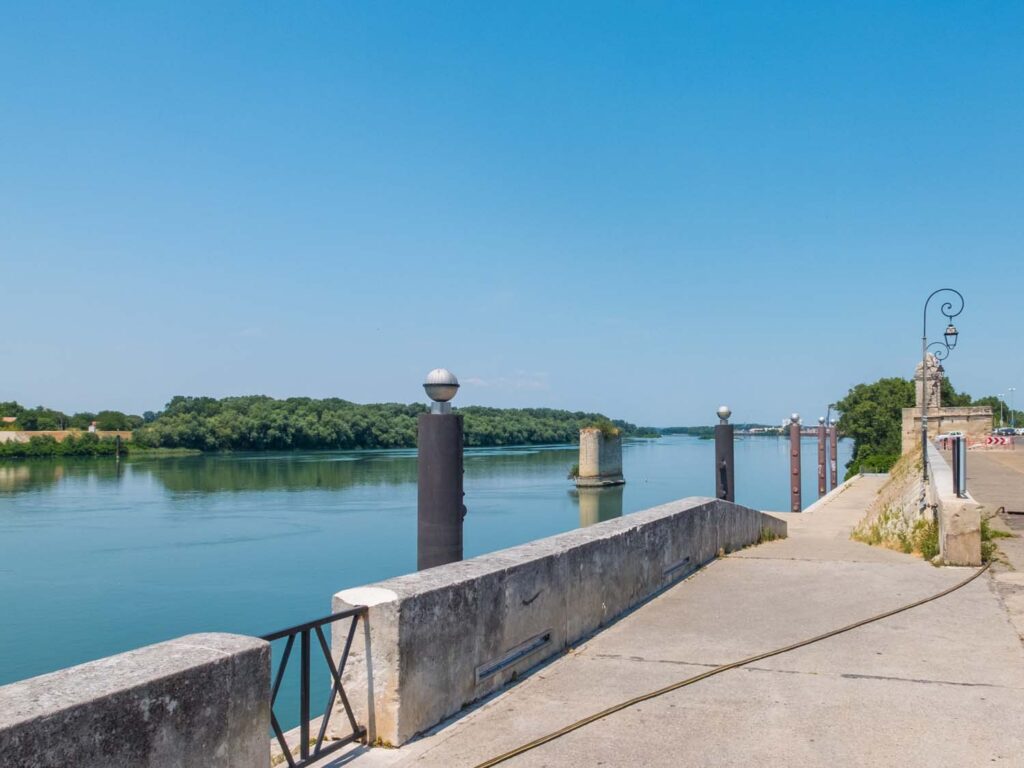
Wander along the riverside walk for a few minutes. Gazing out at the exquisite landscape which wraps around the river. The Rhône River holds immense historical importance to Arles, shaping its identity and playing a pivotal role in its development over the centuries. During the Roman Empire, the river connected Arles to the rest of the Empire. With goods being both imported and exported from this thoroughfare.
Post-Roman Empire, the river continued as a vital trade route connecting the city to the Mediterranean Sea. Goods, such as agricultural produce, textiles, and luxury items, passed through this waterway. Today, the river is no longer a busy port, with huge freight ships landing in Marseille. But you’ll be able to watch dozens of River Cruise boats gently floating on the water, taking in the sights of this majestic waterway.
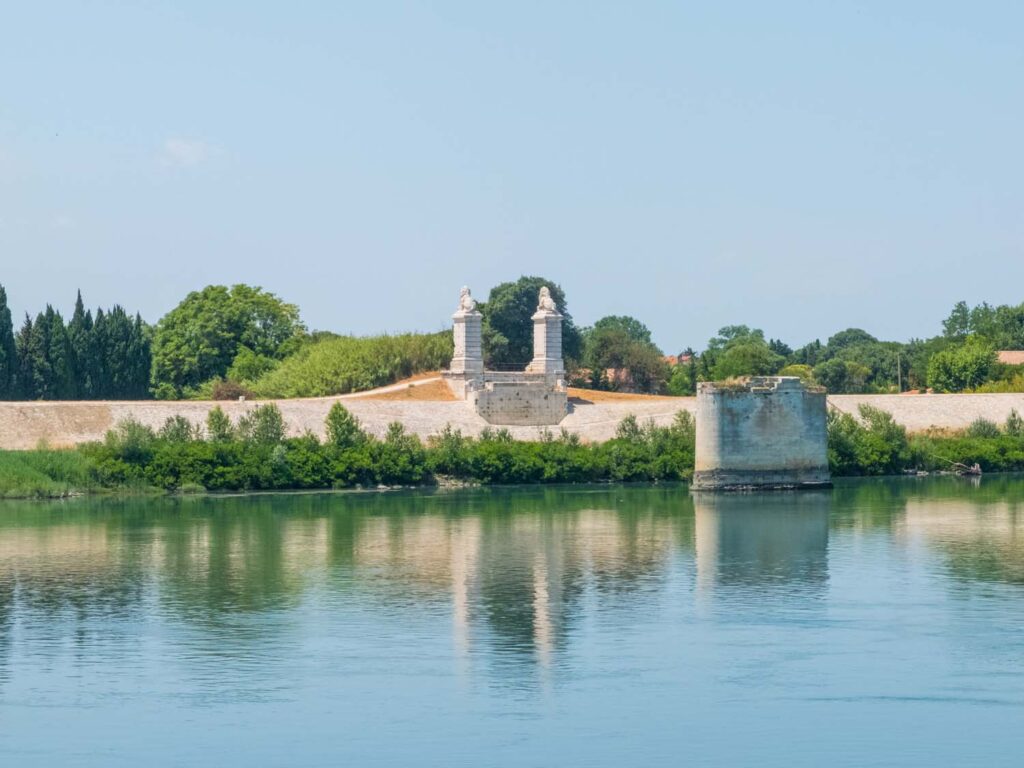
Starry Night Over the Rhône
One of the most prolific reasons people view this part of the river is to study the inspiration for Vincent Van Gogh’s famous paintings, Starry Night Over the Rhône. His home in Arles, the Yellow House, was just around the corner, and it was right here where he came to immortalize the river forever.
The painting features a starry night sky filled with a vibrant and swirling mix of blues and yellows. The brushstrokes are bold and expressive, making the scene almost turbulent. The stars appear to twinkle and dance across the canvas. Hidden in the bottom right corner, we can see a couple taking a leisurely stroll along the riverbank. Just like we are doing today!
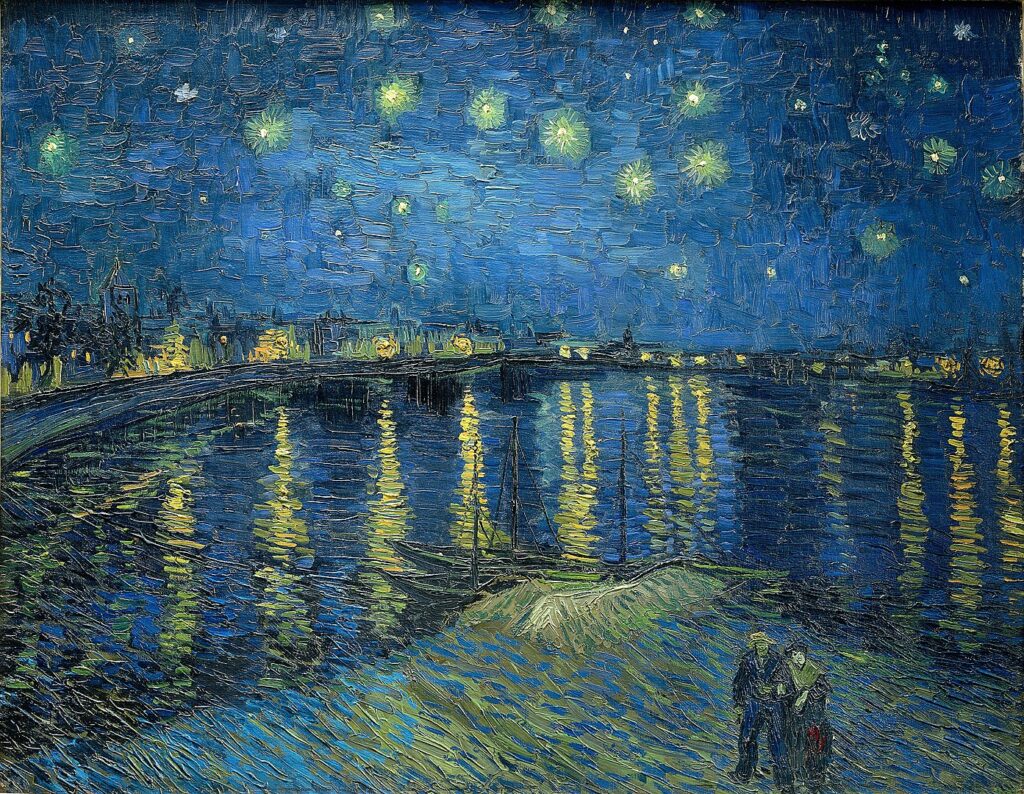
Thermes de Constantin
A small staircase leads you down away from the Quay towards the Rue du Grand Prieuré . As you make your way down, you are met with a large curved brick wall. This is the exterior of the great Thermes de Constantin . The Thermes de Constantin , also known as the Baths of Constantine , is an ancient Roman bath house.
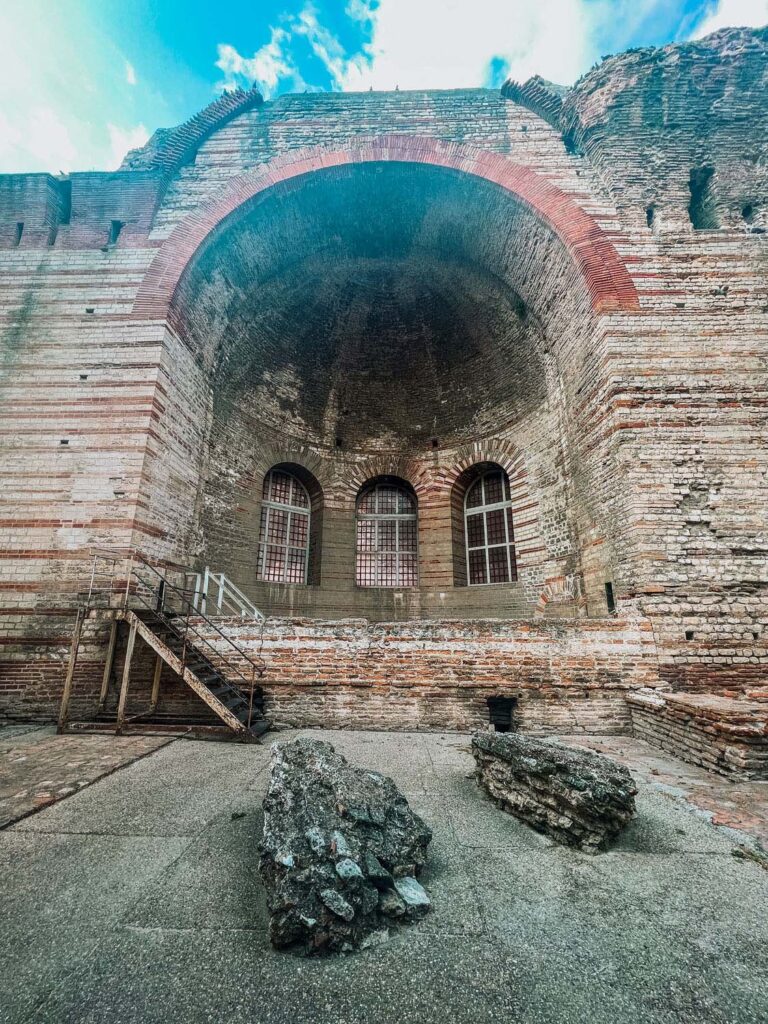
Built in the 4th century AD, the Thermes de Constantin was named in honour of the Roman Emperor Constantine the Great . When we hear the word “bath” today, we think of a small, plastic or enamel tub meant for one person. But during the Roman Empire, public baths were an enormous structure where dozens, if not hundreds, of people could come together. Bathing back then was not just to maintain your personal hygiene, but it was also great. For Romans, bathhouses were a social and cultural center where people from all walks of life would gather, relax, and socialize.
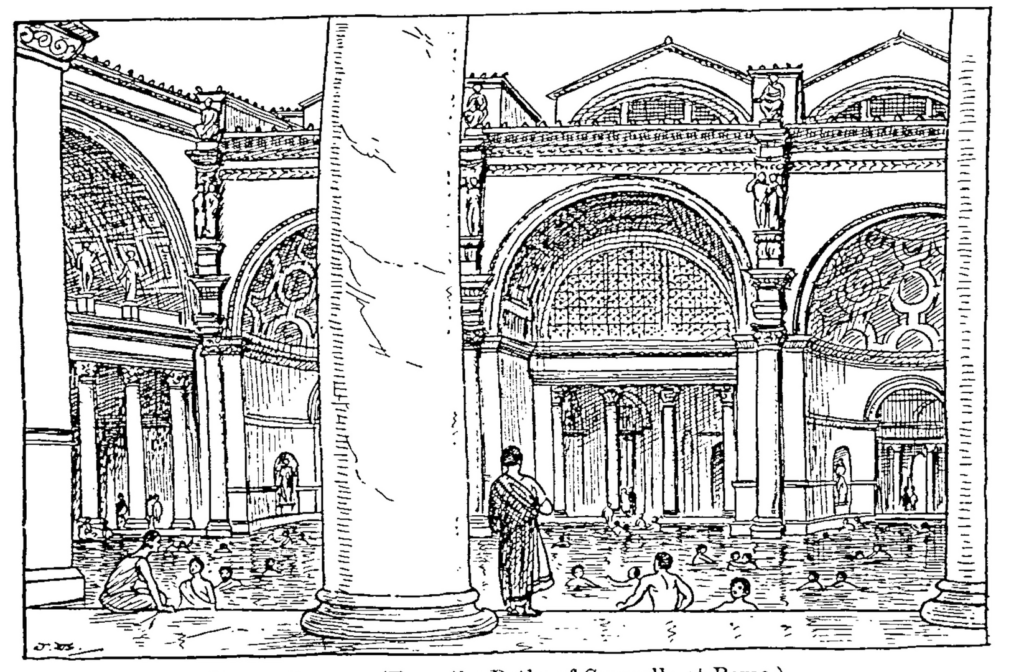
Using a Roman Bath House
Roman baths were grand, impressive structures. Stepping inside, you can walk around the space on raised platforms to really appreciate the grandeur of the building. While most of the decoration has been lost to time, imagine for yourself as you walk through the now-barren interior with stunning mosaic decorations and intricate marble sculptures. These were all meant to showcase the opulence and grandeur of Rome. The walls would have been adorned with frescoes depicting scenes from mythology, everyday life, and the glories of the Roman Empire.
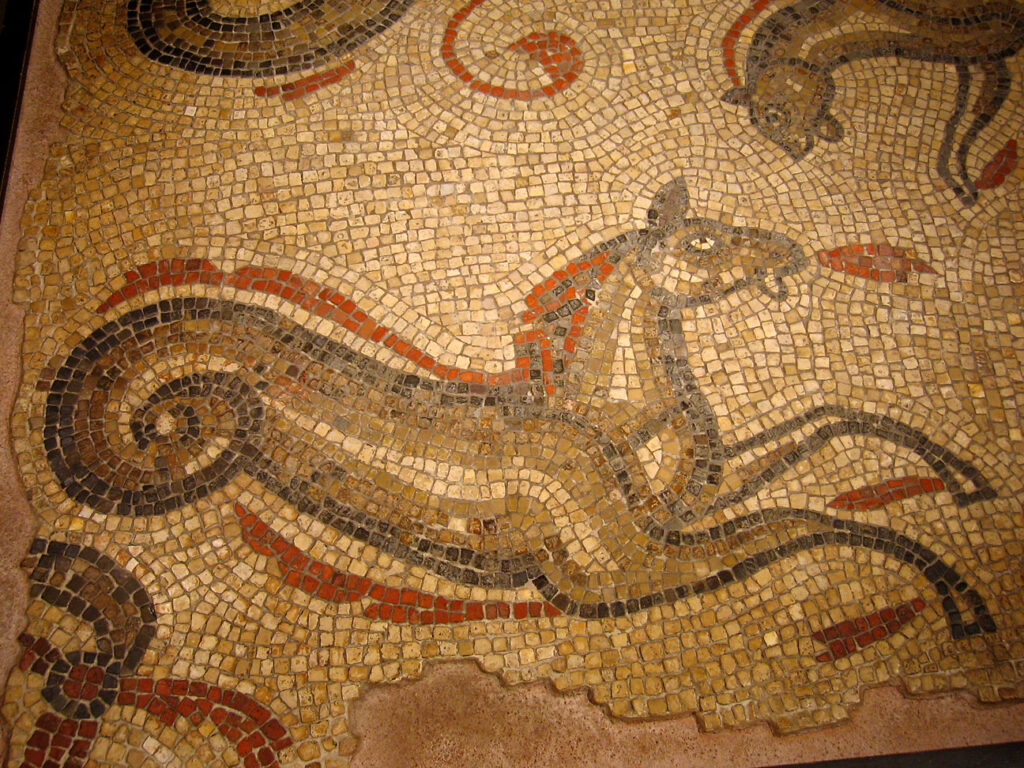
Visitors would enter through an imposing entrance hall known as the frigidarium, which led to a series of interconnected rooms offering different temperature baths. These rooms included the tepidarium (warm room) and the caldarium (hot room), equipped with underfloor heating systems known as hypocausts. You can still see several of these underfloor heating systems today; look for the signs that point it out.
Roman baths were not only for physical relaxation but also hubs for intellectual and cultural exchange. Philosophical discussions, debates, and other social interactions would occur within these spaces.
Individual Entry Price Roman Baths: 5€
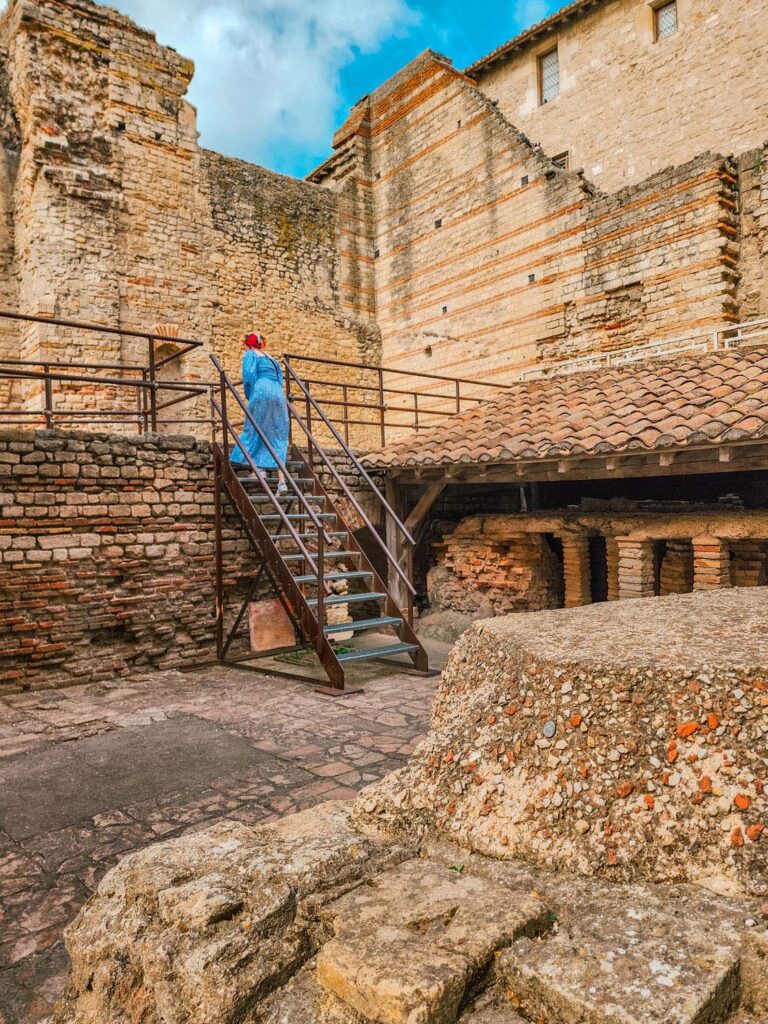
Musée Réattu
Leaving the Roman Baths, you can opt to visit the Musée Réattu just down the street. Entry to the Musée Réattu is included in the Pass Avantage . If you’re not an avid art fan, you can skip this stop. But the museum is very small, so even if you just want to peek inside to see a few pieces, you won’t spend very much time inside.
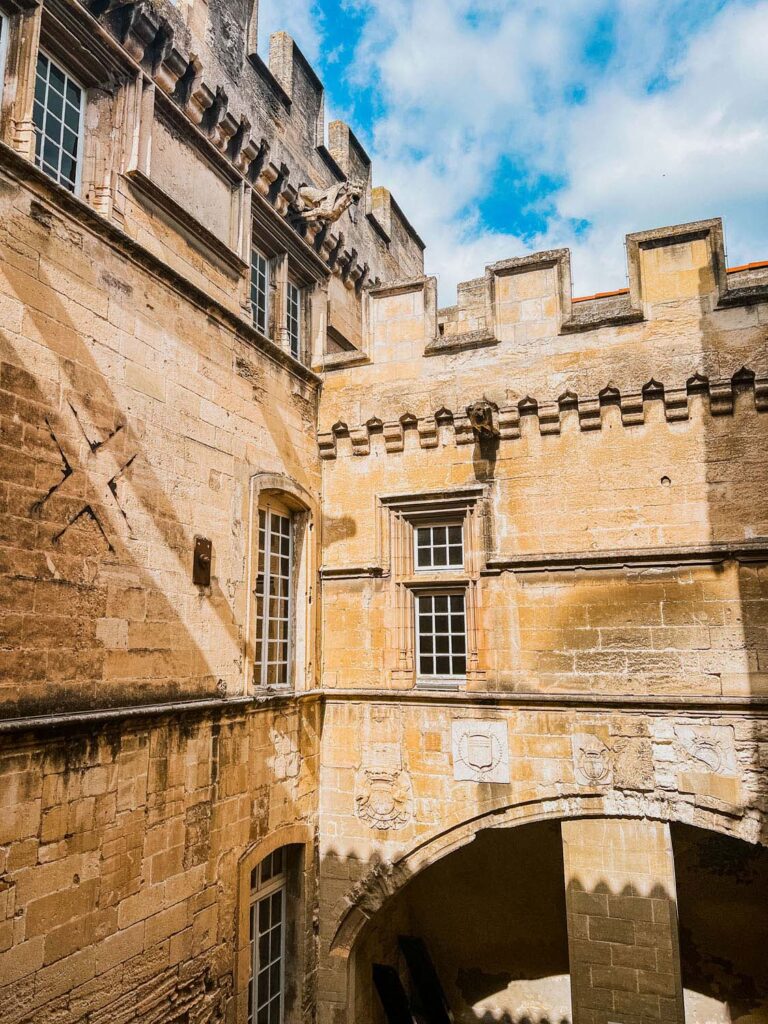
The Musée Réattu is housed in a former 15th-century priory. Exploring some of the historic parts of the building is one of the best reasons to stop here. The museum primarily showcases the world of Jacques Réattu, an influential French artist who was born in Arles. Réattu’s artistic journey took him from his hometown to the vibrant Paris art scene. It was in Paris that he gained recognition for his exceptional painting. But he never forgot about his beloved home of Arles. While Van Gogh might be the biggest name to have worked in Arles, Réattu is the homegrown pride of the city.
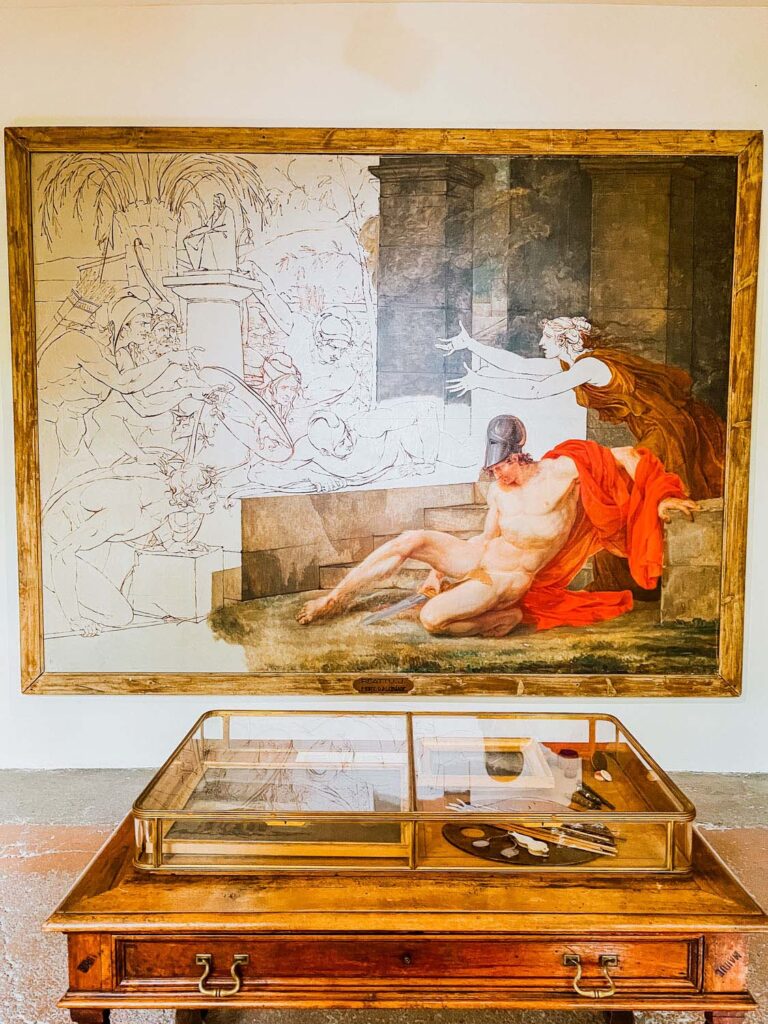
Réattu’s artistic repertoire encompassed various subjects, from historical and mythological themes. His works often exhibited a harmonious blend of classicism and romanticism, with a keen attention to detail and a deep understanding of human emotions.
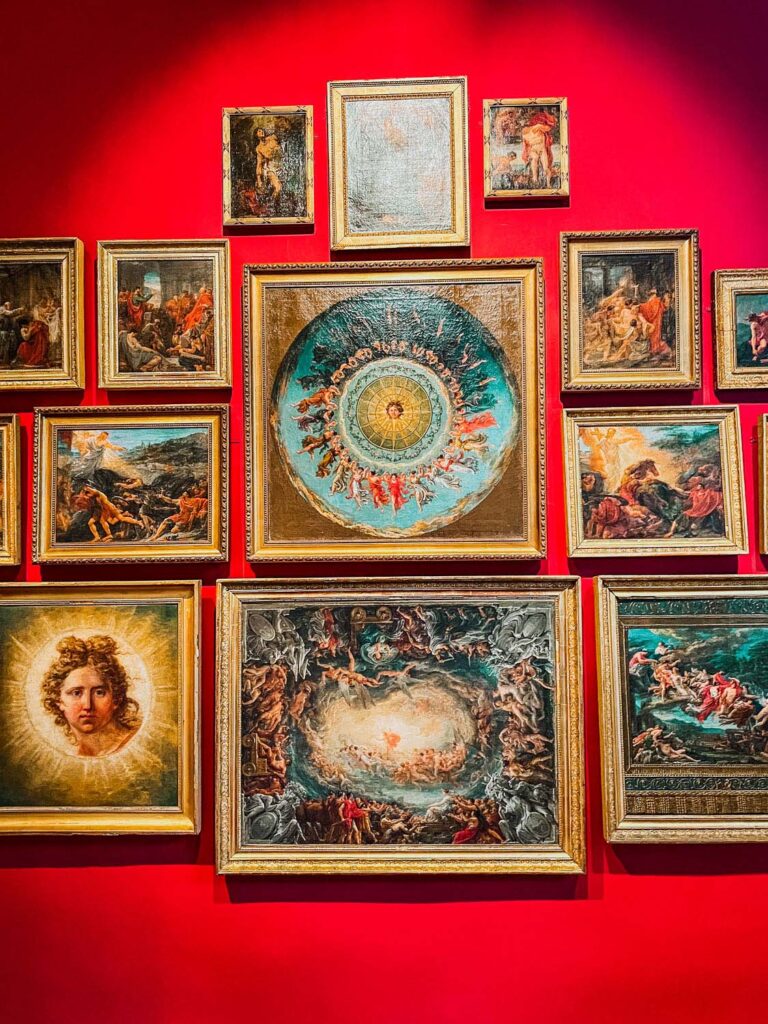
Picasso’s Arlesienne
Also included in the museum’s collection is a series of eight portraits painted by Picasso of his muse Jacqueline Roque, dressed as an Arlesienne. The term “Arlesienne” was often used to describe the traditional costume worn by women in the Arles region in the 19th century. This traditional dress typically includes a white or light-coloured blouse, a full black skirt, and an elaborate, intricately embroidered black velvet bodice. The outfit is completed with a headdress adorned with ribbons and flowers, which vary depending on the occasion. The Arlesienne has become an enduring symbol of Provencal and was also frequently painted by Gaugin and Van Gogh.
Individual Entry Price Roman Baths: 8€
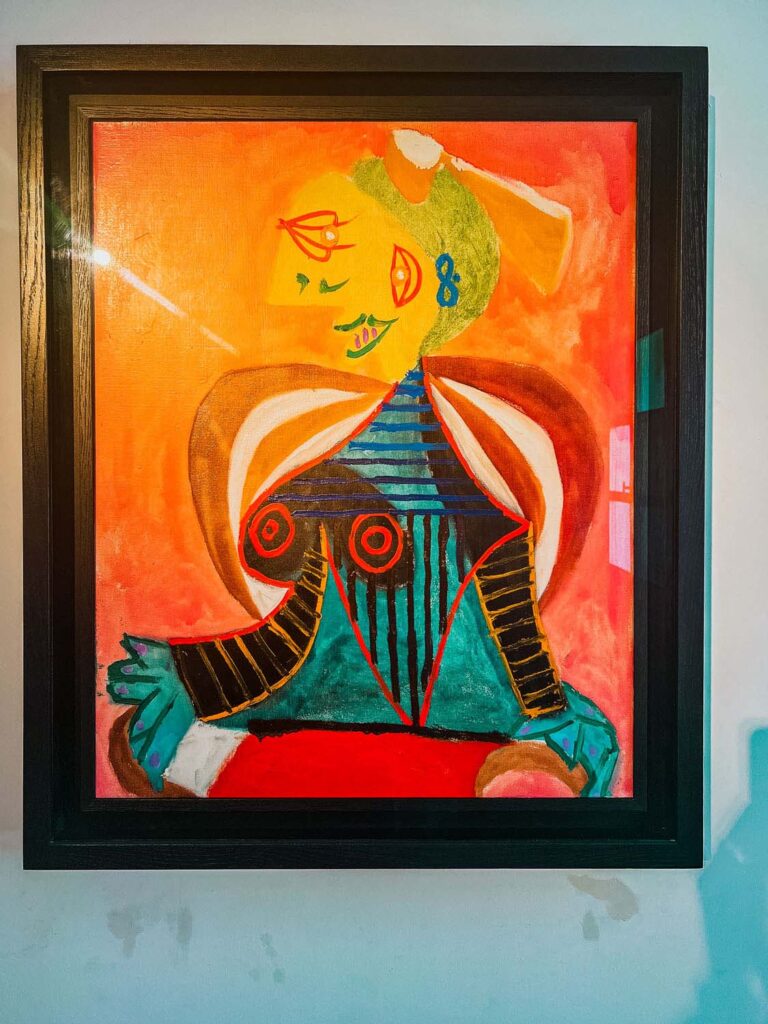
Place du Forum
From the museum, let’s meander down toward the Place du Forum. Turn left onto Rue Dominique Maisto , then right onto Rue du Sauvage, leading into Rue de la Place . The Place du Forum is a picturesque, vibrant square steeped in history and surrounded by charming cafes and shops.
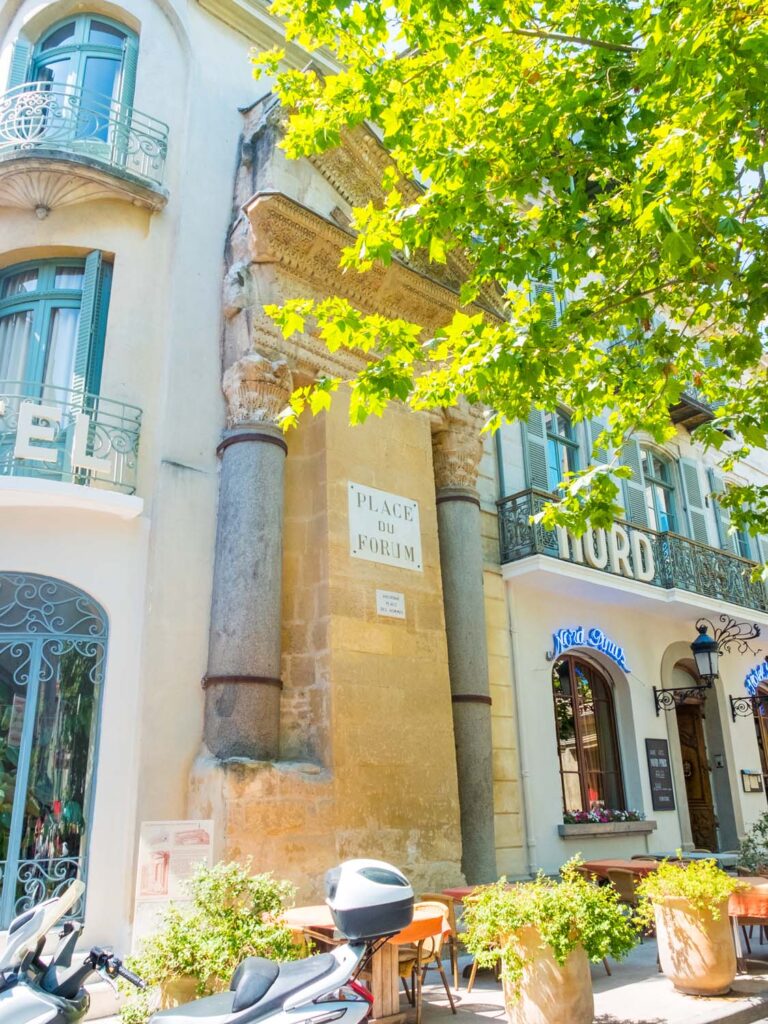
The Place du Forum is named after the Roman Forum that once stood a few blocks away. Today, remnants of the ancient Roman city can still be seen embedded into the walls of the square. Look closely at the building on the corner, now the Nord-Pinus Hotel . You can see it embedded in the hotel are two Roman Corinthian columns. These tall columns once supported a Roman temple that occupied this space.
A Corinthian column can be recognized immediately by its elaborate capitals decorated in acanthus leaves arranged in a spiral pattern, surrounding a central bell-shaped element called the “abacus.”
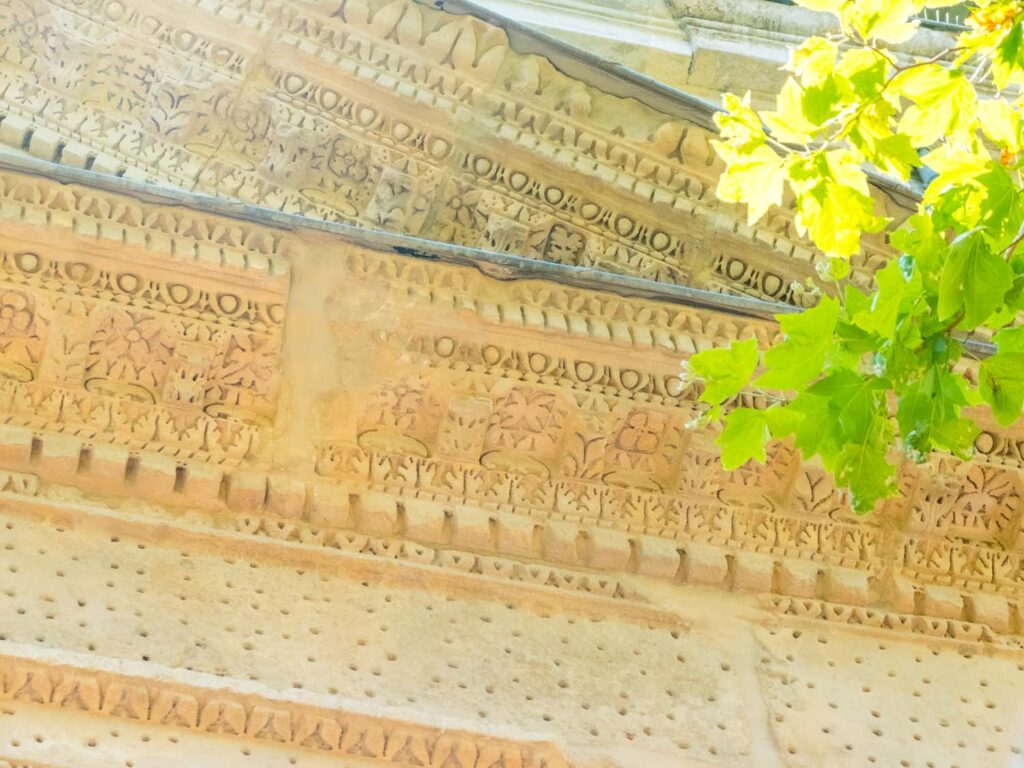
Van Gogh Café
At the heart of the Place du Forum stands the iconic Le Cafe La Nuit. Better known as the Van Gogh Café . This café features a bright yellow facade, believed to be the same café that inspired Van Gogh’s famous artwork, “ Café Terrace at Night. ”
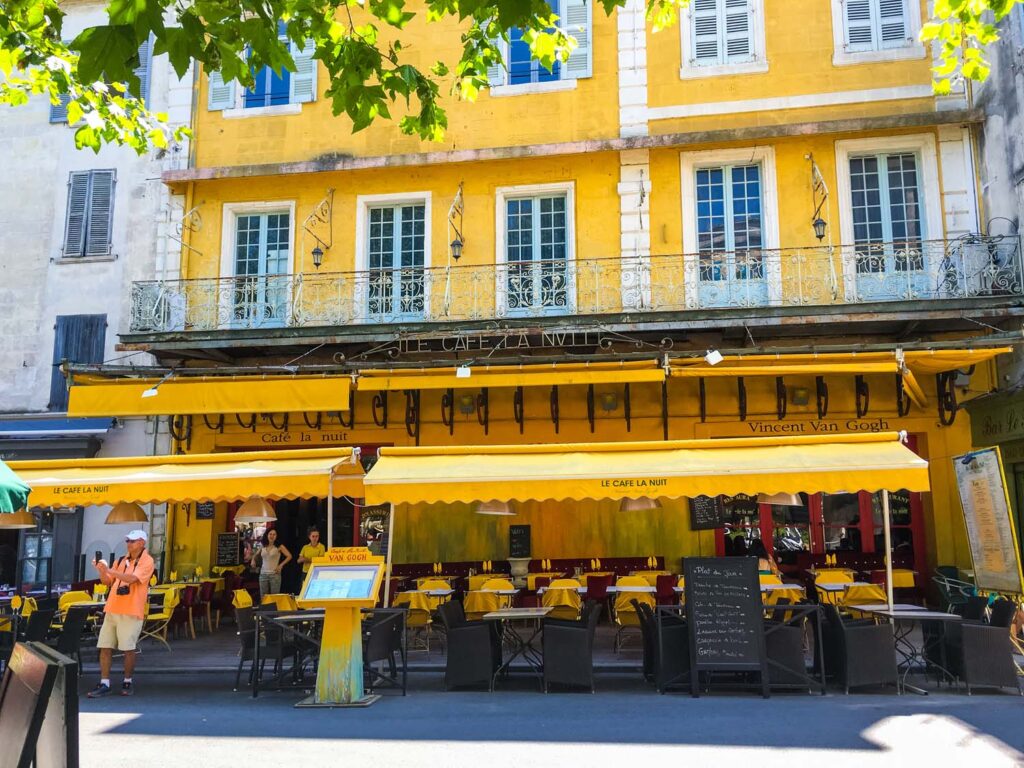
While the cafe might stand in the same spot as the original cafe from the painting, the ownership has changed hands many times. And today, the cafe sadly has a poor reupitation as a tourist trap. If you want to stop for an aperitif, consider L’Apostrophe Restaurant two doors down instead. If you can snag a spot outside, you have a beautiful view of the Yellow Cafe without the tourist trap prices and poor-quality food and service. After all this walking, you’ll definitely have deserved a sweet aperitif.
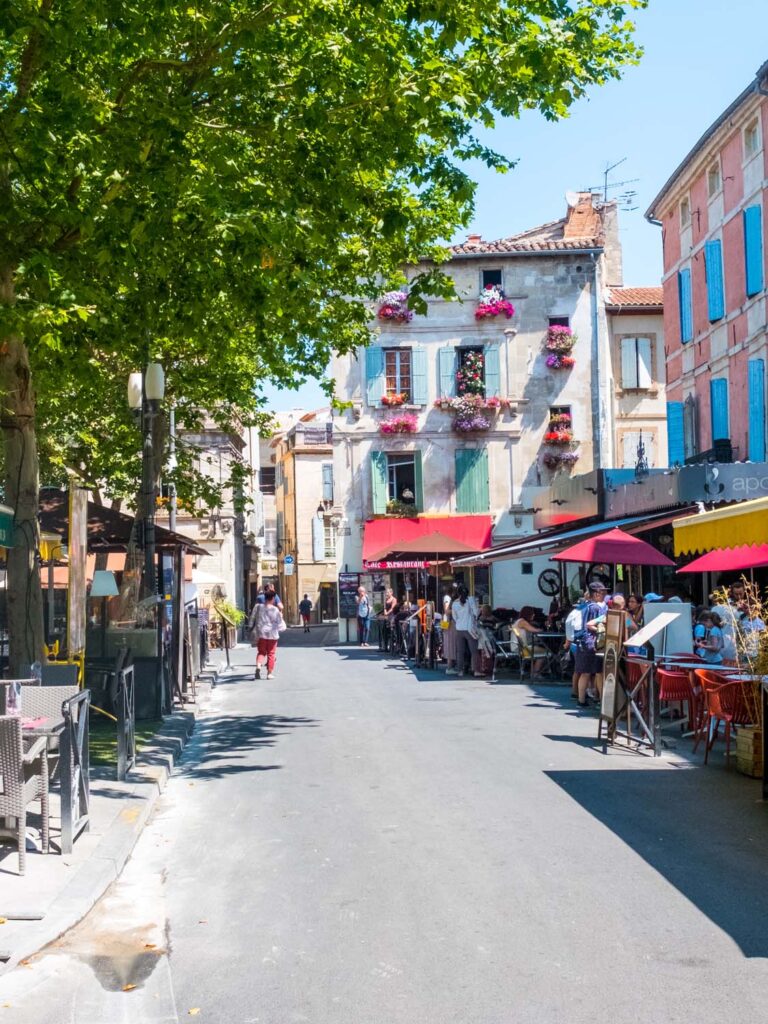
Cryptoporticus
Continue your journey towards the Cryptoporticus of the Roman Forum. This spot is just a few blocks from the Place du Forum. You must enter the old Town Hall of Arles to get inside. Once inside, you’ll find the entrance to the underground passageway.
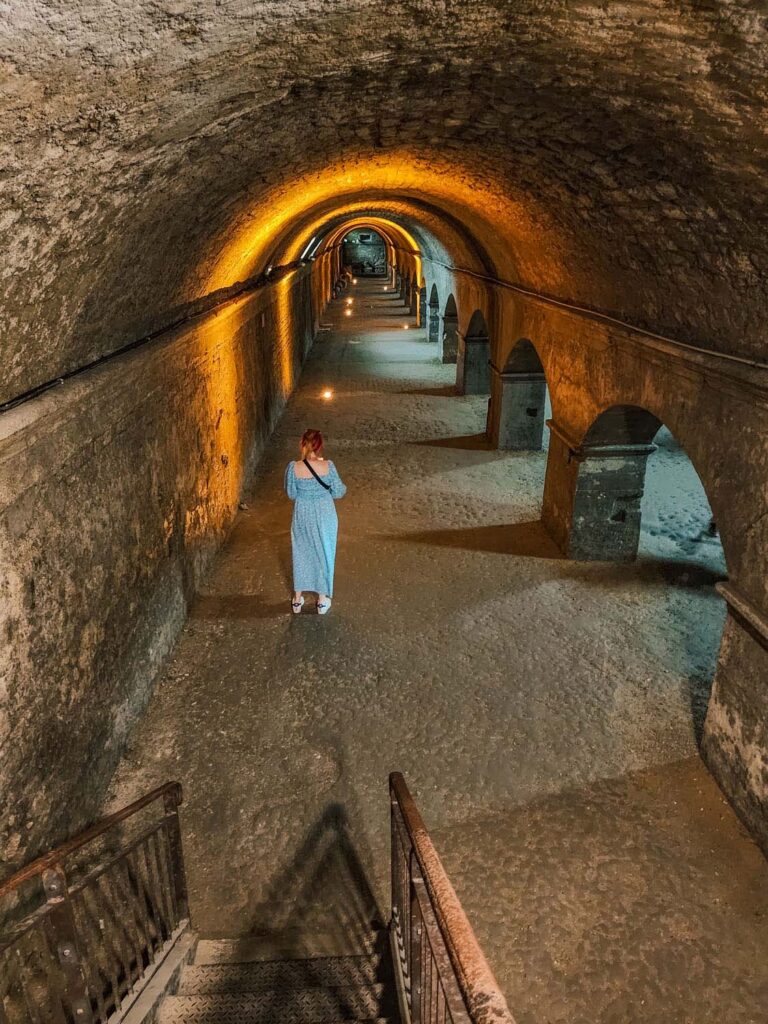
The Cryptoportiques d’Arles , also known as the A rles Cryptoporticus, dates back to the 1st century BC. These underground vaults were constructed to serve various functions, including supporting the enormous Roman Forum above. The Cryptoportiques consist of a network of underground galleries and corridors. These galleries are supported by a series of arches and pillars, characteristic of Roman architectural engineering. The ceilings of the passageways are vaulted, allowing for the even distribution of weight and enhancing the structure’s stability. Walking around in the dark, you feel like you’ve entered a labyrinth, and perhaps a minotaur lurks around the next corner…
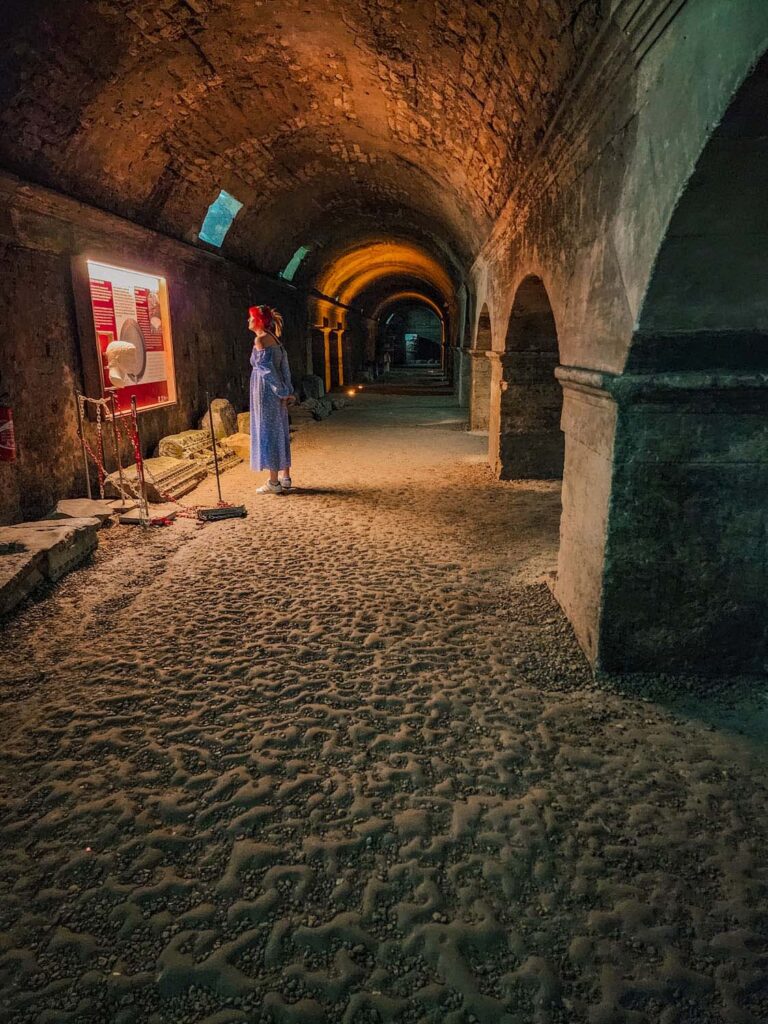
The walls and pillars of the Cryptoportiques were made using locally sourced stone, primarily limestone and sandstone. The choice of these durable materials contributed to the fact that this part of Roman Arles has been so pristinely preserved today. Since the temperature was much cooler in these underground passages, the Cryptoportiques were also employed as storage space.
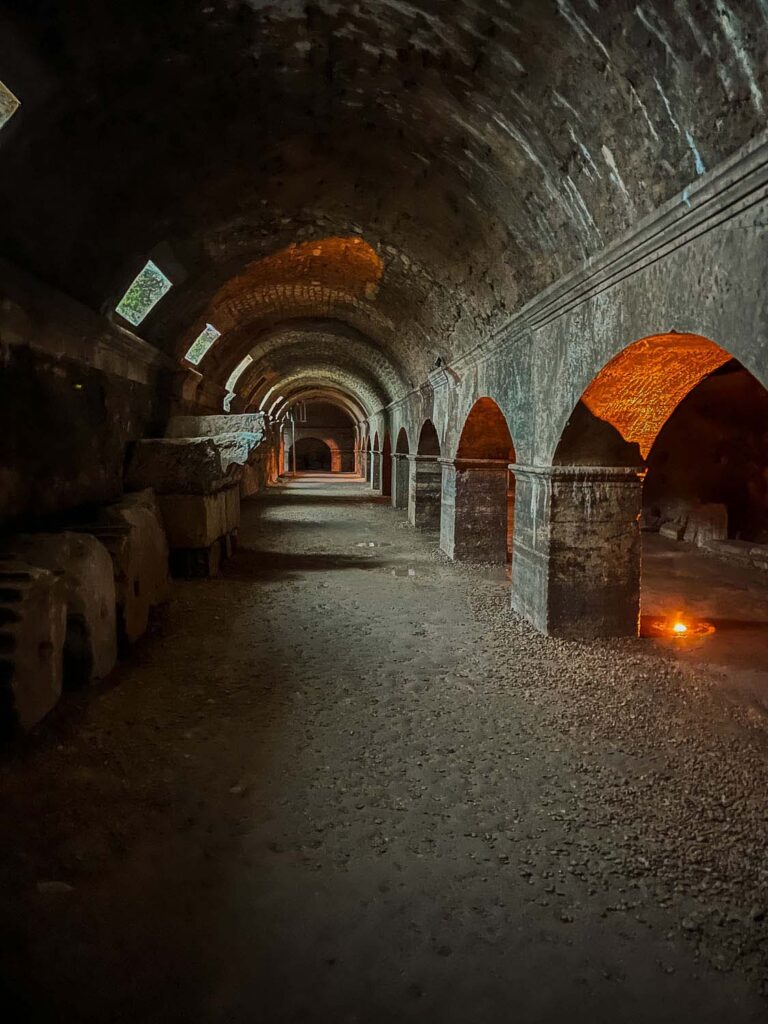
The Obelisk
After returning to street level, head out the doors from the city hall, which leads onto the Place de la République , the heart of the historic city center. Standing in the centre of the square is the monumental Obélisque d’Arles . The Obélisque d’Arles is one of the oldest surviving Roman obelisks in France. Standing approximately 15 meters (about 49 feet) in height. The Obelisk is made of reddish-pink granite, not native to France. This means that the Obelisk would have been brought in as far as Asian Minor in the region of Troy.
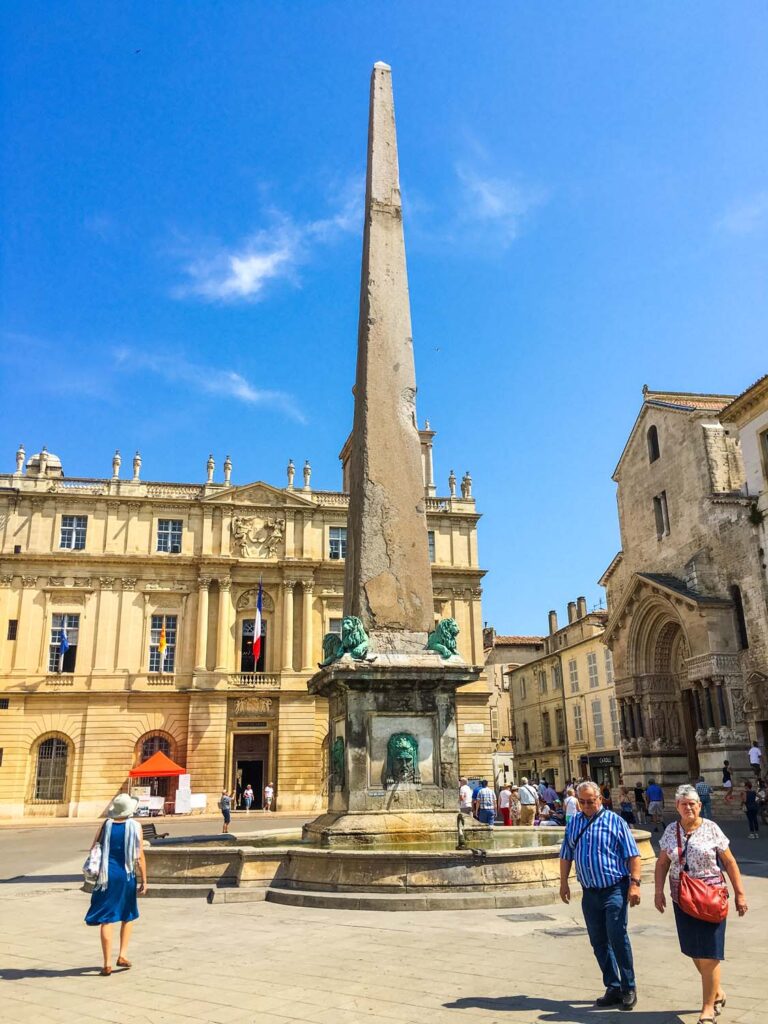
This majestic Obelisk dates back to the 4th century AD, although when it was first installed in the city, it stood in the centre of the Roman circus. A Roman circus, also known as “ circus maximus ” in Latin, was a large, elongated, and open-air venue used primarily for chariot racing, one of ancient Rome’s most popular and thrilling forms of entertainment.
When the Roman circus was demolished, the Obelisk collapsed or was knocked down. Breaking it into two different parts. It wasn’t until 1389 that the Obelisk was discovered and brought into the Amphitheatre to be displayed. In 1676, Louis XIV decreed it should be moved into the town square. And four engravings dedicated to the glory of Louis XIV were added. The decorative base was added in the 19th century, along with the fountain’s basin and surrounding bronze lion head water spouts.
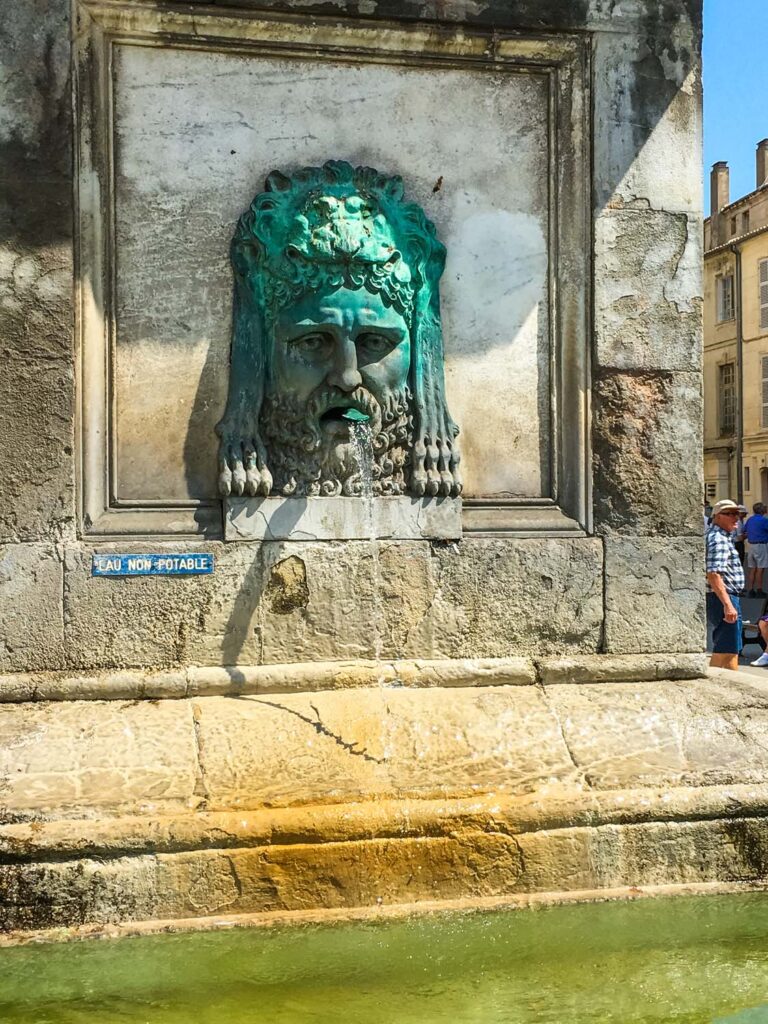
Church of St. Trophime
On the east side of the town square stands the great Church of St. Trophime. While the majority of the church we see today was completed in the 12th century, such an extraordinary structure took time to complete, and there are elements from the 11th century and even earlier still to be found throughout.
The church is named for Saint Trophimus , one of the early Christian saints and the first bishop of Arles. Originally the church was named Saint Stephen, but in 972, the relics of Saint Trophimus were reinterred, and the church was renamed in his honour.
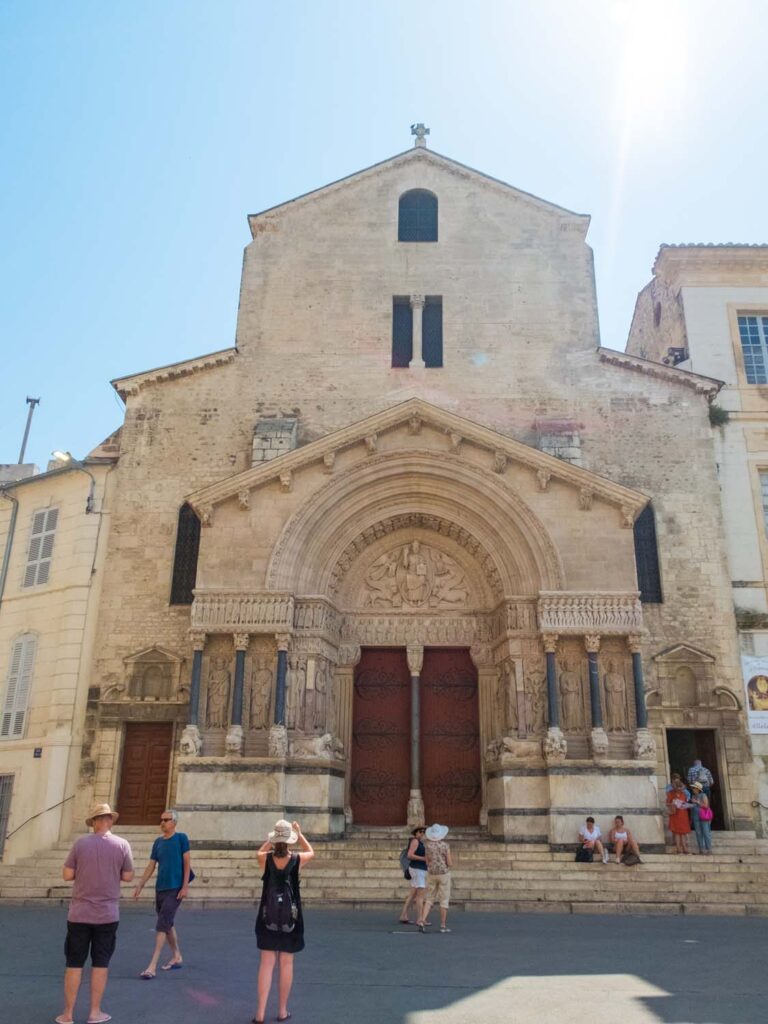
Its exterior facade, adorned with exquisite Romanesque carvings, is a magnificent example of medieval artistry and storytelling through art. Back in the medieval era, peasants were barely literate. Communicating these religious ideas and stories through art and imagery was paramount.
The elaborate portal, known as the “Portal of the Last Judgment,” is the doorway through which visitors have entered the church for hundreds of years. For our purposes on this tour of Roman art and architecture in Arles, you should note how the archway leading into the church is reminiscent of a Roman triumphal arch.
The Tympanum
In the semi-circle above the doorway is the tympanum. Here we can see the image of Christ, seated, holding the Bible on his knees. On either side of him are found animals representing the four evangelists. The winged lion for Saint Mark, an angel for Saint Matthew, an eagle for Saint John and a winged bull for Saint Luke. Surrounding the archivolt (a moulding that frames the arch) is a choir of angels with vivid expressions; you can hear them singing.
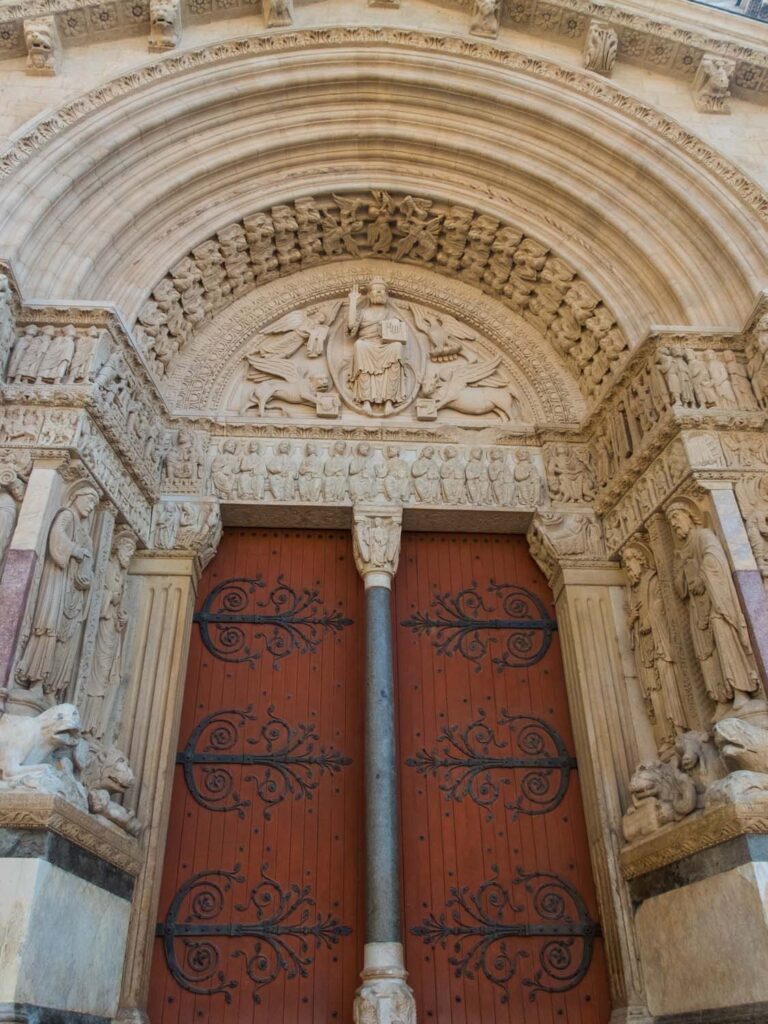
Lintels and Pilasters
The lintel , the band of stone that runs under the tympanum, depicts the souls of the dead in a The souls on the left are dressed in fine garb procession bound for judgement. The souls on the left (the righteous) march towards the centre, led by an angel with outstretched wings towards the twelve apostles. They are seated in the centre, holding a book on their knees, ready for judgment. On the right, we have the souls of the damned, who have been turned away as they walk naked and chained toward their doom.
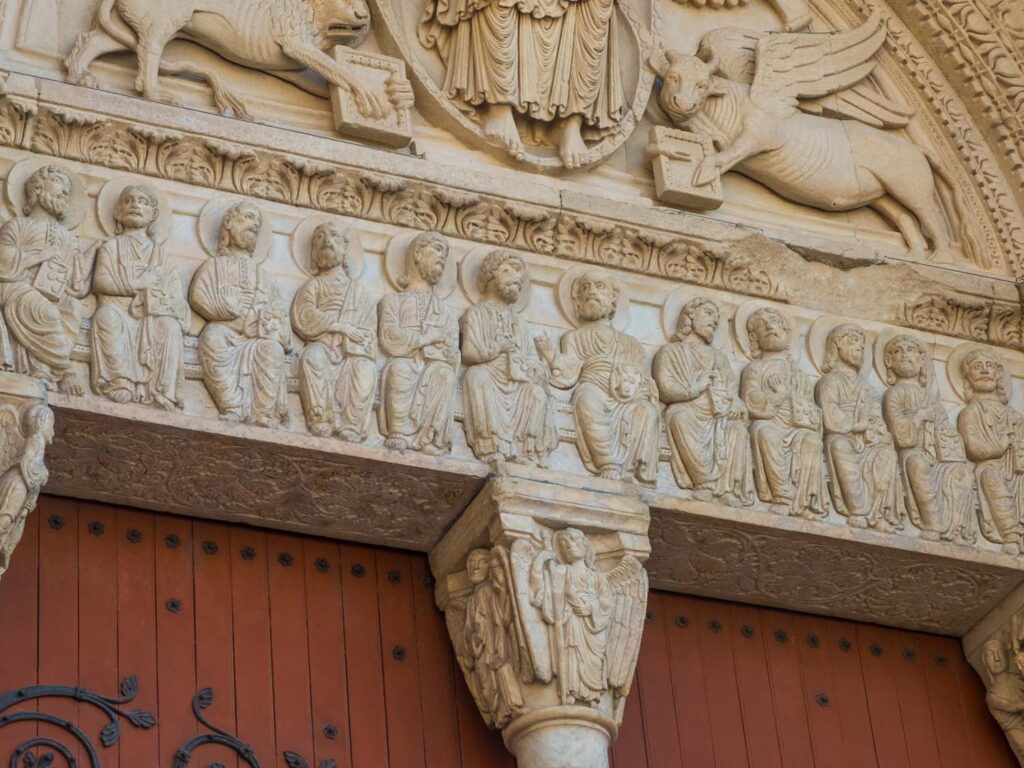
The pilasters that support the lintel are also very interesting, and it’s worth studying the intricate carvings on their base. Evil beasts and monsters torment the souls of the damned. And the huge face of Samson’s slain lion is almost wrapped around the base of the column. These tormented scenes are contrasted above, with the column capitals covered in various decorative elements like acanthus leaves, foliage, and vegetal motifs, almost like they depict heaven and hell throughout this imagery.
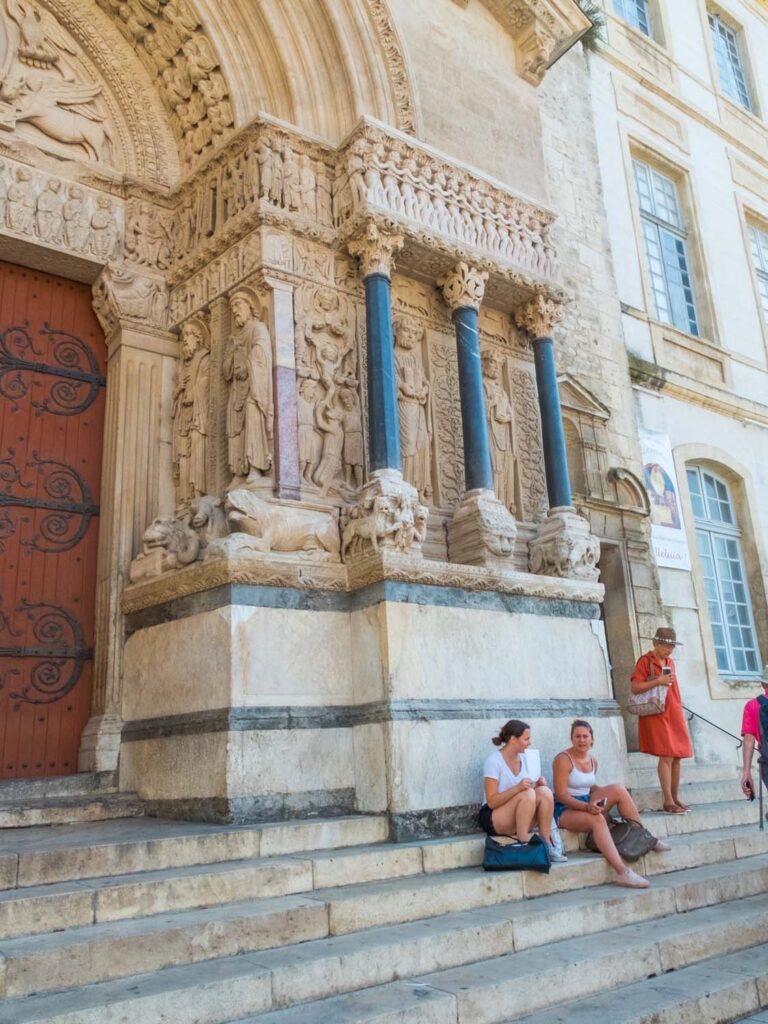
Outer Frieze
A frieze behind the pilasters depicts the major saints of the Church, including Saint Stephen and Saint Trophime. You can spot Saint Trophime on the left dressed in his episcopal costume holding a curved cane, a Crozier, in his hand. He is also seen being crowned two angles.
If you look closely, there is a secondary frieze above the apostles which illustrates the childhood of Christ. Starting with the Annunciation made to Mary, the dream of Joseph into the Massacre of the Innocents and the Flight to Egypt and finally, the Nativity.
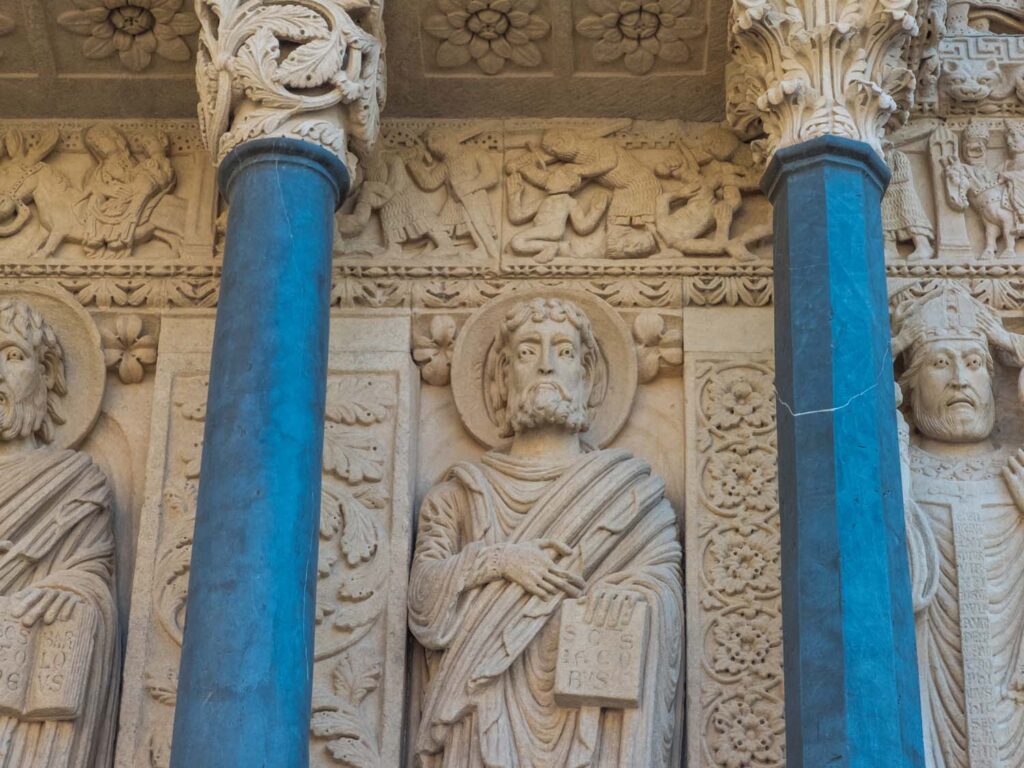
Entry into the church’s interior is free, but the St. Trophime Cloisers , located next door, require an admission fee. Thankfully if you purchased the Pass Avantage , this is included in your pass. We will explore the cloisters after briefly walking through the church’s interior.
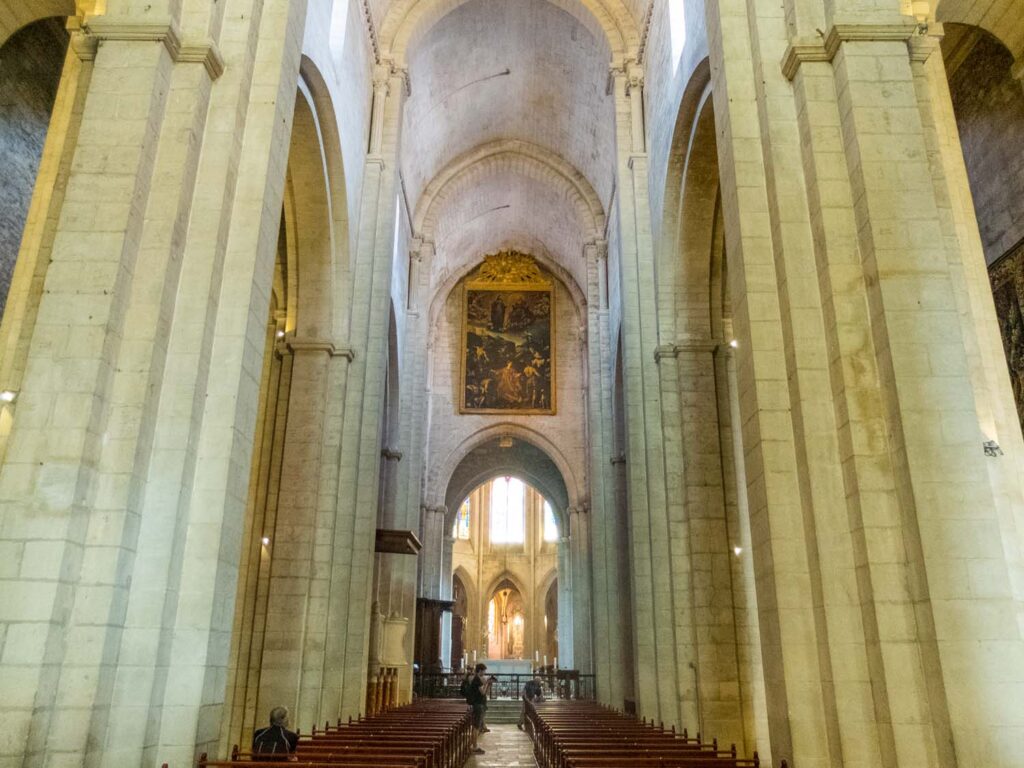
Aubusson Tapestries
Entering the church, we can tell right away that this is a romanesque construction. The columns are thick and rudimentary. Lacking the lightness of many later gothic churches. There is a heavy atmosphere inside. The stoney interior of the church is lacking in carved decorations. Several side chapels were rebuilt during the Gothic periods, as these are doubtlessly the most elaborate designs inside the church. To add some interest to the austere church, tapestries were hung on the blank walls. These date back to the 17th century and illustrate scenes from the life of the Virgin Mary.
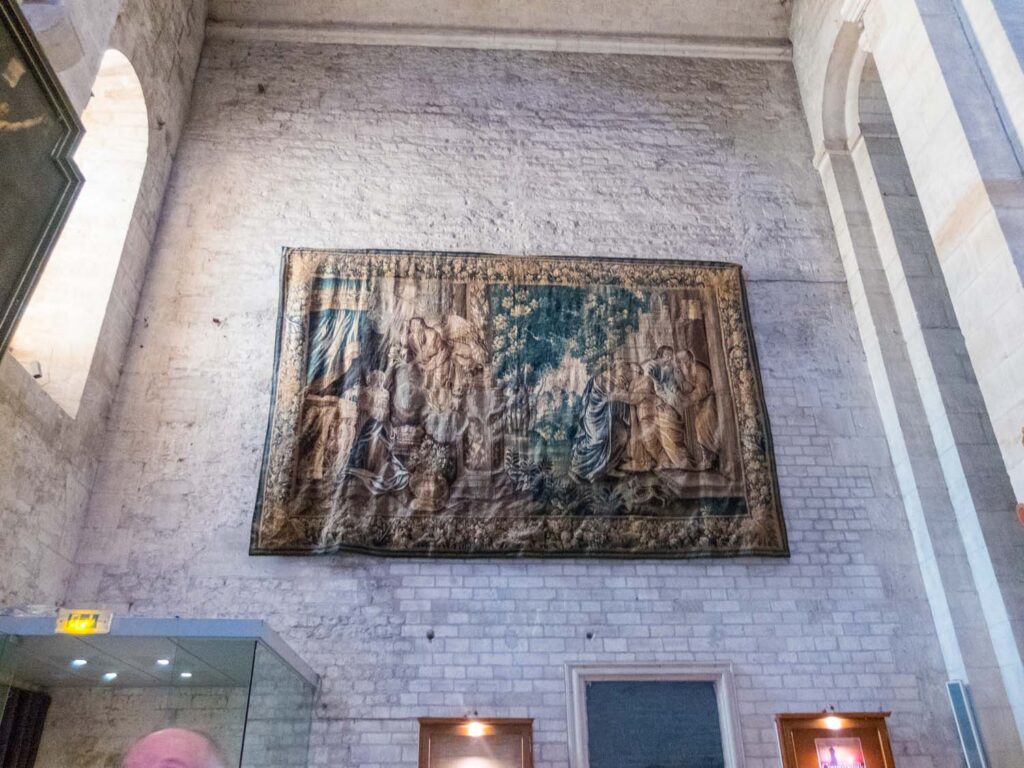
Early Christian sarcophagi
Throughout the church, see if you can spot the three early Christian sarcophagi that were brought to the church from their original resting place in Les Alsycamps. Unlike the remaining tombs in Les Alsycamps, these sarcophagi are covered in complicated and precise carvings. They almost appear architectural in their design, comprising arches, pilasters and niches that frame tiny figures representing various biblical stories. The earliest of these tombs dates to the 4th century, although they only made this church their resting place in the 19th century.
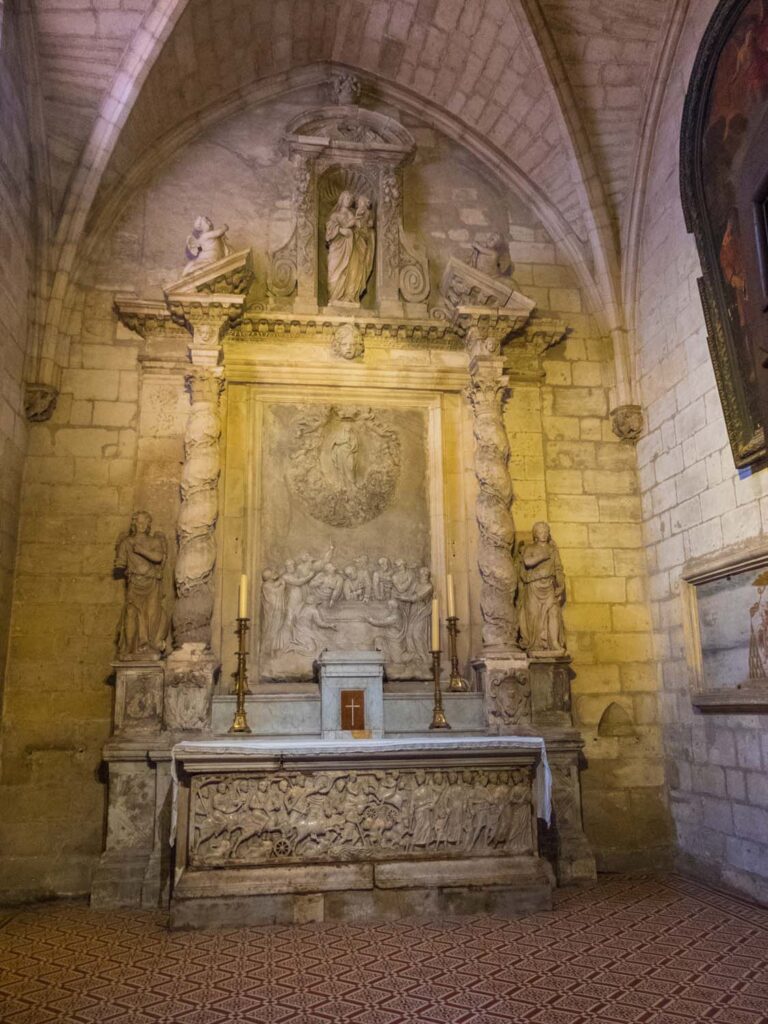
Chapel of Saint-Genès
Make a point to stop at the chapel of Saint-Genès to the north of the transept. This is where one of the old sarcophagi is held and where you can find a beautiful white marble statue of the Virgin Mary. This statue was originally placed in the Saint-Honorat-des-Alyscamps and is a great example of the beautiful decorations that would have once adorned the church we saw at the start of this tour.
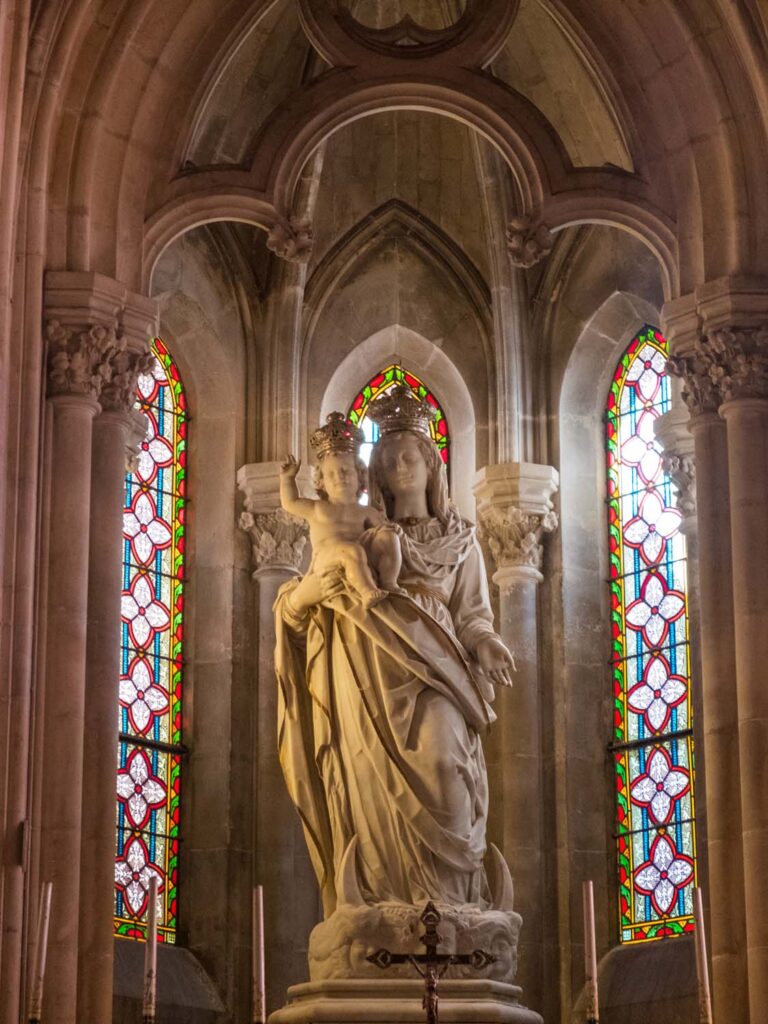
Reliquary chapel
My favourite part of the church is the reliquary chapel. Hidden behind a filagree wrought-iron gate, under a blue-painted ceiling with stars dotting the sky, are dozens of golden reliquaries. A reliquary is a container to house and display relics, which are objects or remains believed to have a special connection to a saint or religious figure. These reliquaries are stunning works of art all on their own. The most important of these reliquaries is that of Saint Trophimus, patron of the church. But you can also see reliquary for Saint Stephen, Saint Anne, and even the Mother of Mary.
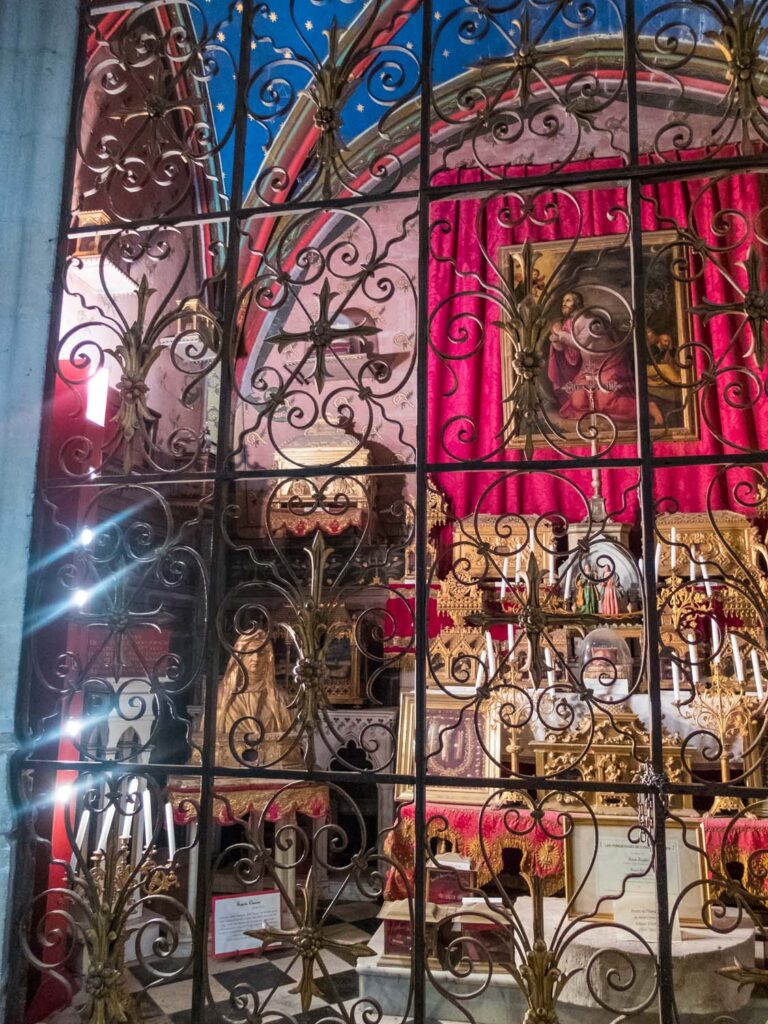
Cloître Saint-Trophime
Exiting the church, walk back onto the square and pass through the Palais de l’Archevêché. This leads you into an interior courtyard where you’ll find the entrance to the Cloître Saint-Trophime . Initially, the church would have been connected to these cloisters, but since the cloisters now require a ticketed entry, this side entrance was constructed to filter guests into the building here. Walking through this courtyard, be sure to admire the exquisite vantage point you have here to gaze up at the old Romanesque church tower.
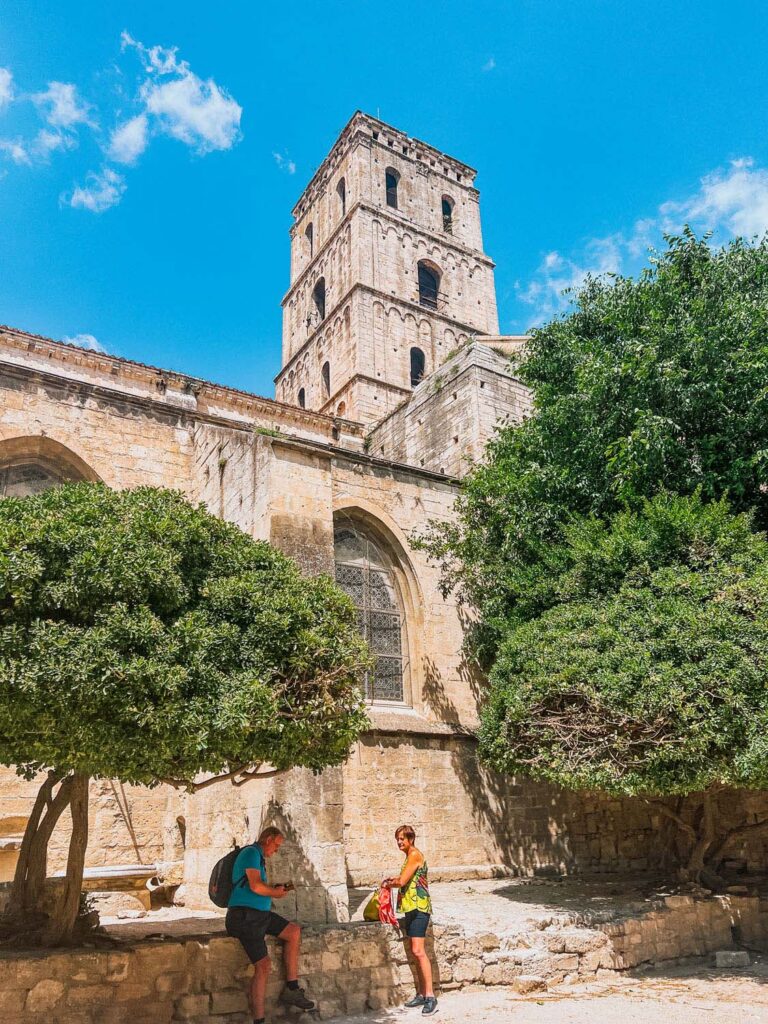
History of Cloître Saint-Trophime
The Cloître Saint-Trophime was built during the 12th and 13th centuries. It served as the monastery’s private quarters for the canons of Saint-Trophime. It was a place for them to gather for prayer, contemplation, and meditation. Providing a quiet and peaceful sanctuary away from the hustle and bustle of daily life. Surrounding the cloisters are a dormitory, refectory and dining hall were also built where the canons could continue their private life outside the church. But just as these buildings were being constructed, the Counts of Provence moved from Arles to Aix and much of the wealth that the city had been used to dissipated.
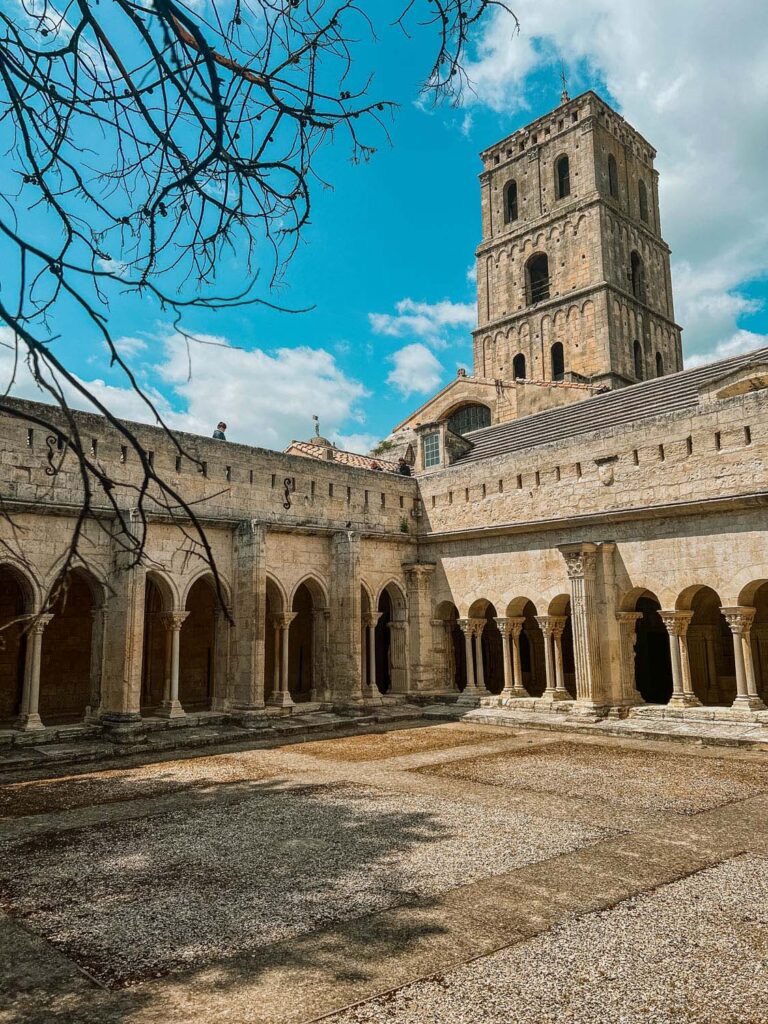
Another big hit to the continued construction of the Cloisters was in 1348 when the Black Death came to Provence, vastly reducing the population of almost every infected. When the canons filled the cloister, these buildings became granaries and storehouses for food. As such, when you visit the dormitory, refectory and dining hall interiors, you’ll notice a difference in the style of these buildings.
The highlight of the cloister is its exquisite arcades adorned with elaborately sculpted capitals. These capitals depict various biblical scenes and religious figures. Each is intricately carved with meticulous detail.
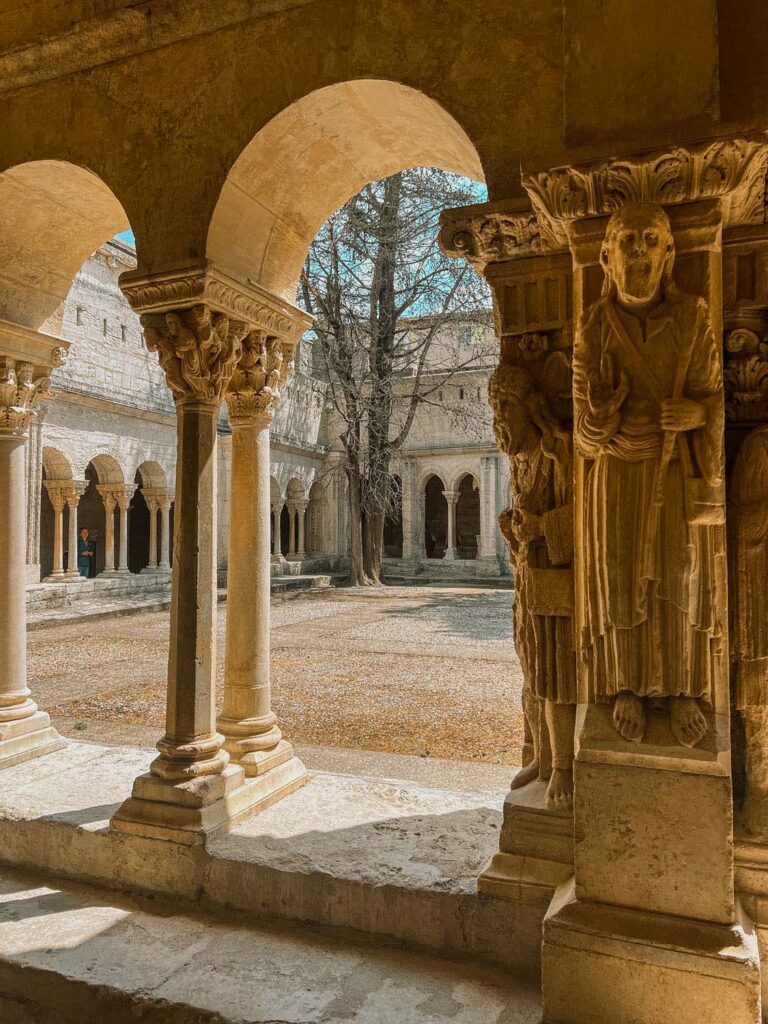
Interior Courtyard
West gallery.
You enter through the gallery’s west portions into a space built around 1375. The southern and western galleries, built later in the construction of the cloisters, are Gothic, whereas the north and east galleries are Romasnaques.
The images on the columns here are devoted to religious figures and scenes popular in Provence. You” find the story of Samson slaying the lion, the stoning of St. Stephen, Mary Magdalene kissing Christ’s feet and the Coronation of the Virgin.
North Gallery
Each section of the cloisters is divided into the north, south, east and west galleries. The North Gallery’s main themes you can keep your eyes looking to spot as you stroll through the cloister. This is the resurrection of Christ and the glorification of the patron saints of the city, Saint Trophime and Saint Stephen.
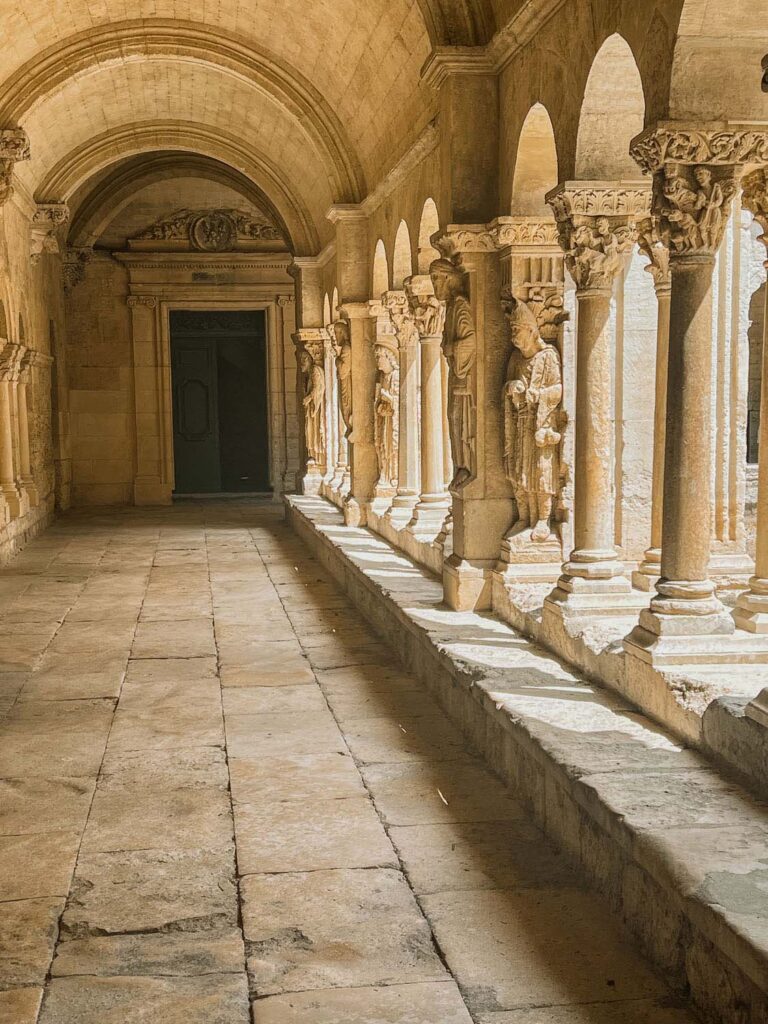
Saint Trophime
To find Saint Trophime, head to the northwest corner of the cloisters. He stands with his right palm facing the viewer while the left holds onto his curved crook, although the top of the cane has since been broken off and lost to history. On his right and left, respectively, are Saint Peter and Saint John. Saint Peter sent Saint Trophime to Gaul, now modern-day France, to evangelize the people there and become Archbishop of Arles.
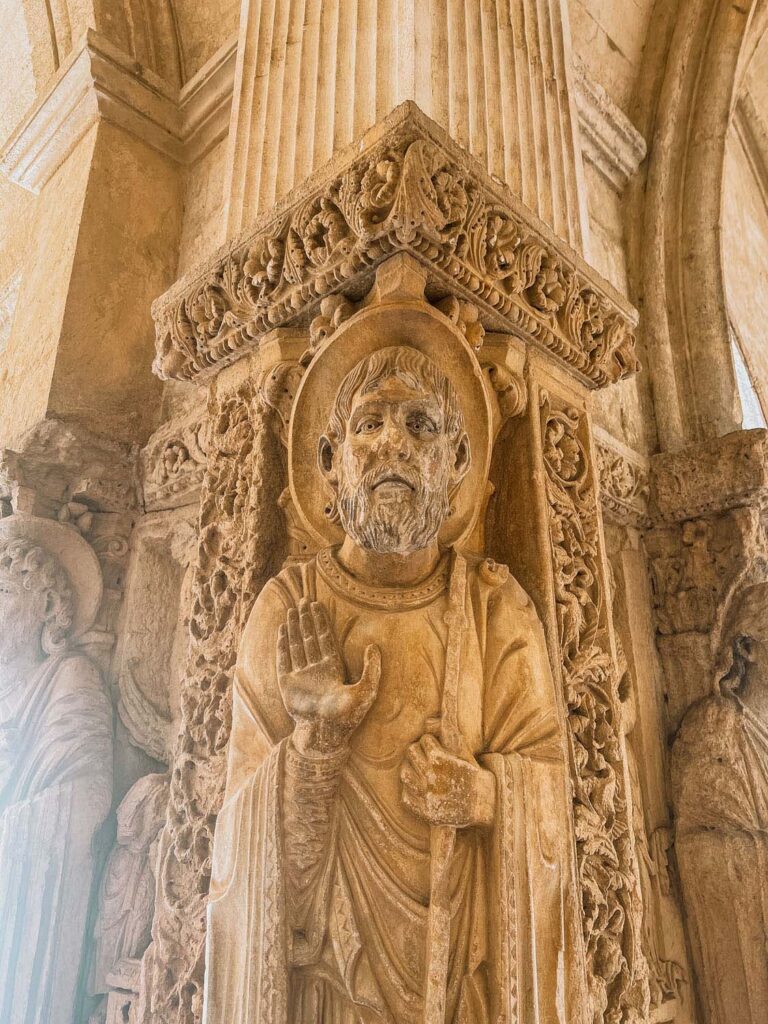
Above the doorways, you can make out the coat of arms carved onto the lintel. This image represents the coat of arms of Arles. You can see an eagle with spread wings wide; this symbolized the Holy Roman Emperor, who at the time ruled Arles.
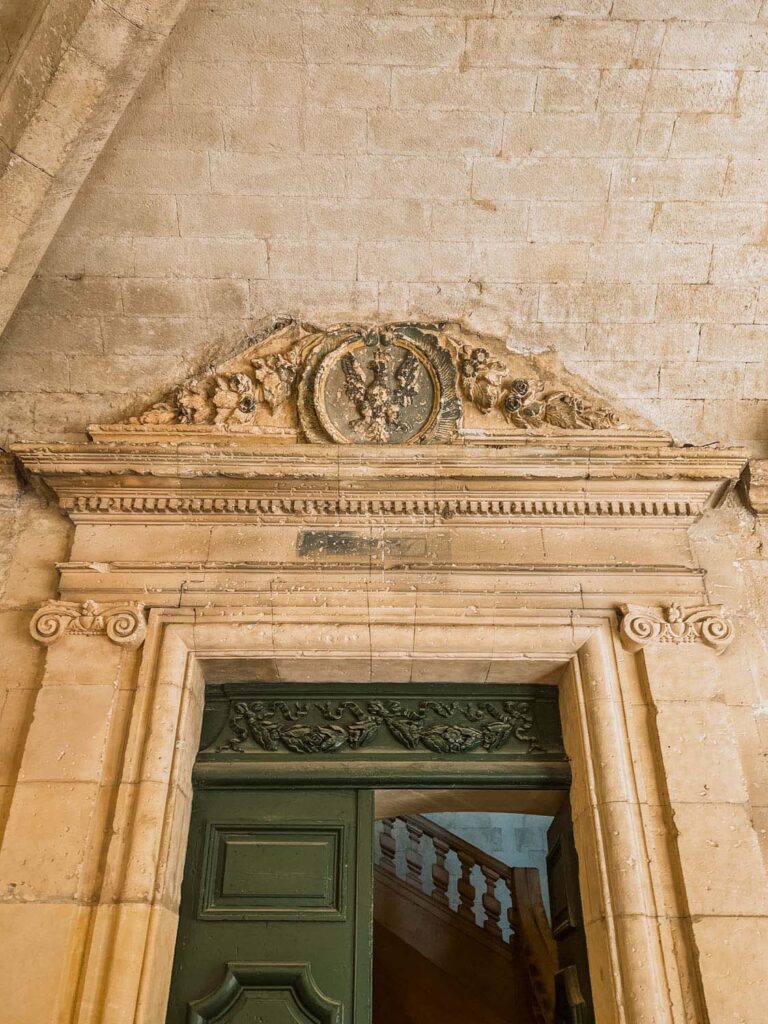
Eastern Gallery
The eastern gallery columns focus on the passion of Christ. Throughout the carvings, you can see the Christ being flogged bare-chested while tied to a column. Judas is also widely represented here, carrying the purse of coins given to Judas in exchange for his betrayal and that fateful kiss. We also can spot scenes from the last supper.
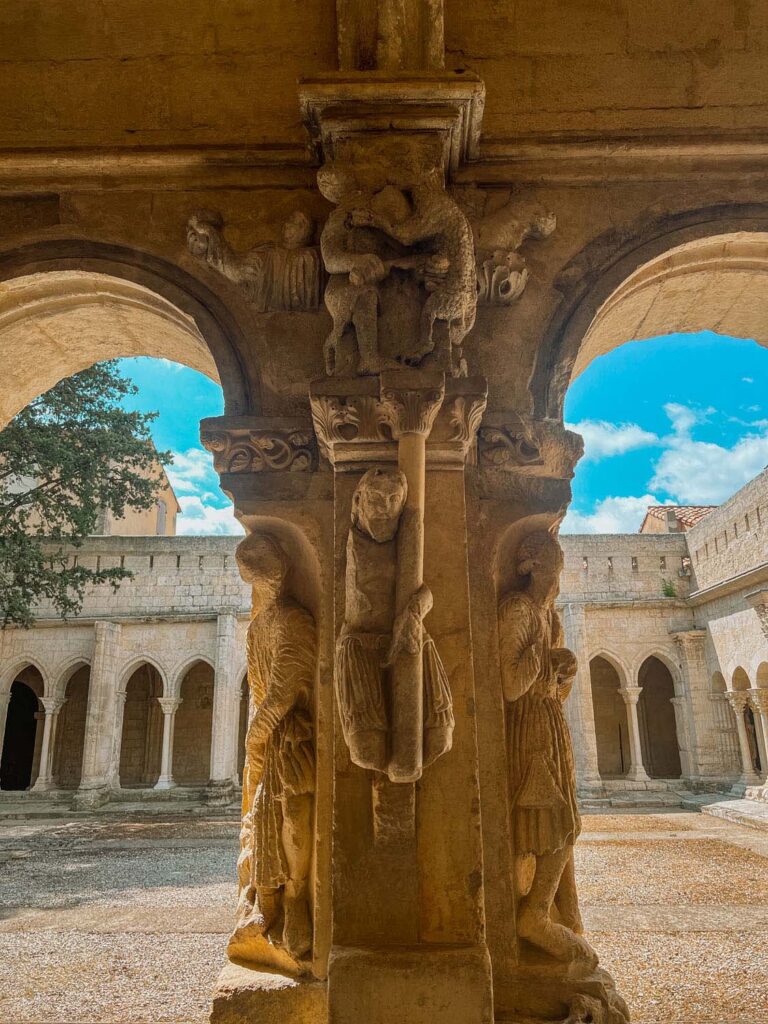
South Gallery
The south gallery features columns telling how Saint Trophime became a saint. You can see depictions of St. Trophime and Christ himself blessing the Alyscamps, the miracles they performed, and even how they brought a knight back to life! See if you can spot the scene of falsely accursed men being hanged on the gibbet who were saved by Saint Trophime. And faced with this miracle, King Charlemagne was forced to set them free.
Be sure to take a walk inside the old stone dormitory building. Despite being completely empty, it’s worth entering to admire the ethereal glow of the tiny yet intricately painted, stained glass window that cast a golden glow into the room.
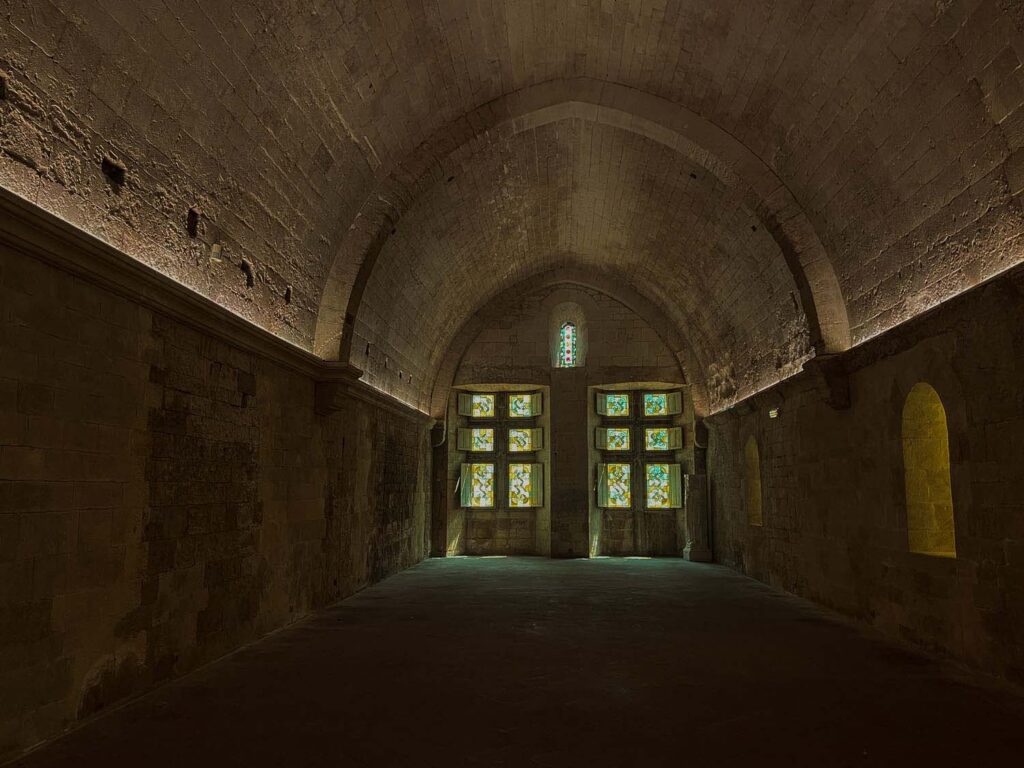
Heading to the second level, you can walk around the upper deck, which wraps around the lower level’s courtyard. From this vantage point, you have a stunning view of the cloisters below and an exquisite view of the old Romanesque Bell tower of the adjoining church.
Individual Entry Price the Cloisters: 6€
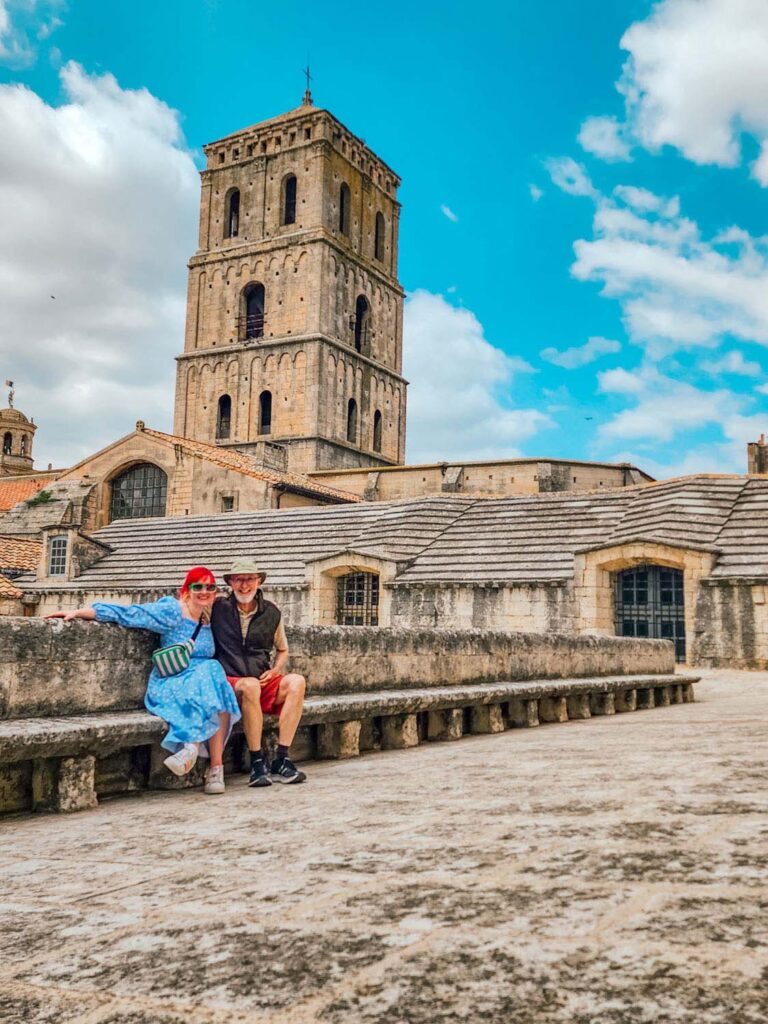
Jardin Des Arts
The cloisters are where we end the historical walking tour of Arles. But if you’re in search of the perfect on-theme place to enjoy a final meal in Arles, make your way to the Jardin Des Arts restaurant. This restaurant is located inside a 13th-century cloister. The Order of the Trinitarians founded their church here in 1198. And built a beautiful cloister and gardens where they lived and worked.
View this post on Instagram A post shared by lili mani (@mlaeti08)
During the Revolution, the property was abandoned and partially destroyed. All that remained was the nave and some parts of the old cloister galleries. Thanks to the restaurant’s efforts, many remaining spaces have been restored and transformed into stunning restaurants. You can eat inside below the old vaults or outside on their charming outdoor terrace, where you can relax amongst the beautiful greenery. The menu features some classic French dishes, but if you’ve never tried Daube , this is a wonderful place to try this Provencal classic.
View this post on Instagram A post shared by Caroline Generosi (@gourmicom)
As you drive back to your home base or enjoy your dinner on the terrace, I hope you reflect on the wonderful journey we have taken into the ancient past of Arles . Hopefully, this tour allowed you to imagine yourself in the fascinating world of gladiators, emperors, and Roman antiquities. And that you leave Arles with a new sense of appreciation for all the people of this city who have helped preserve their past for generations to come.
Happy Travels, Adventurers

« The Ultimate French Bakery Guide, a Boulangerie in Provence
An honest review of art ticket barcelona, a guide to the most amazing museums », you may also like.
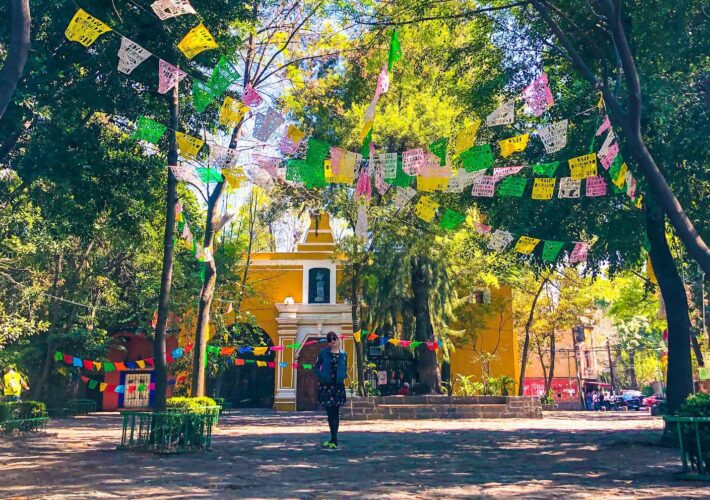
14 of the Best Places to Visit in Coyoacán to Spend the Perfect Day in Mexico City
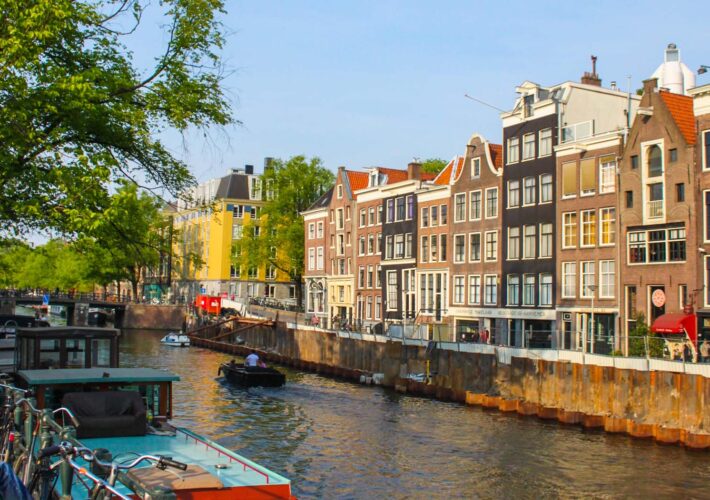
The Ultimate Self-Guided Amsterdam Canal Tour On Foot

The 10 Best Activities for Kids in Provence, the Ultimate Guide for Little Explorers
Leave a comment cancel reply.
Your email address will not be published. Required fields are marked *
Copyright @ 2023 The Creative Adventurer | All Rights Reserved | Privacy Policy
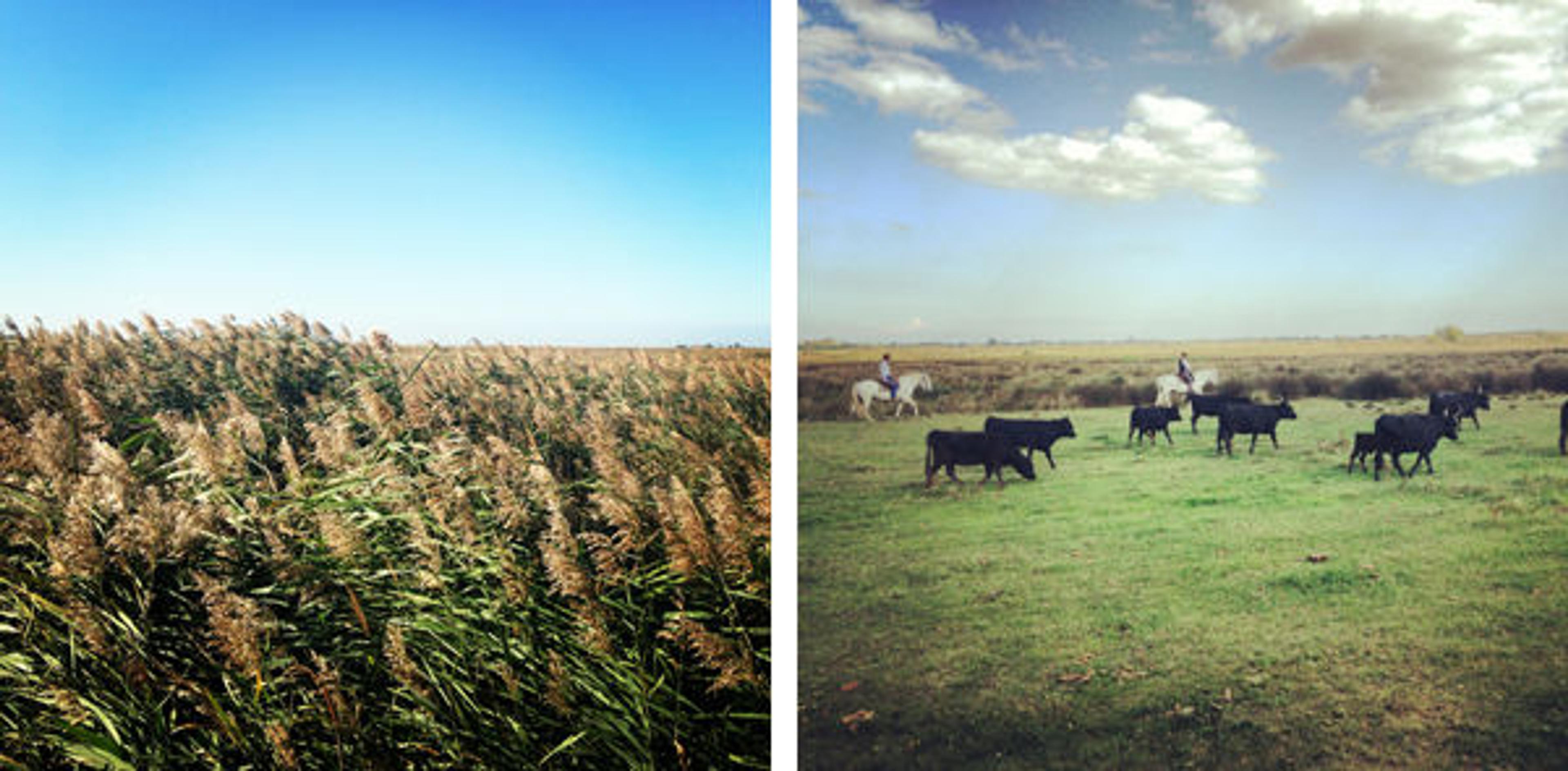
Arles and The Camargue: In Van Gogh's Footsteps
Two views of the Camargue. Photographs by Daphne Birdsey
«We've spent the last few days of our trip in and around the city of Arles. The nearby region of the Camargue, also known as the Rhone Delta, is where the Rhone River ends and the Mediterranean Sea begins. Its salty marshland is renowned for its wild, white horses and pink flamingos.»
The Camargue region has been inspired by the Spanish tradition of breeding bulls for races and fights. We visited one such farm, where the owners explained the difference between Camargue and Spanish bulls—the ones in the Camargue are a bit smaller and their horns point up. Furthermore, the Camargue bulls aren't injured in their fights; in fact, they often perform until they are about fourteen or fifteen years old and are respected like soccer stars. Rather than killing the bulls, matadors win money based on how many ribbons they retrieve off the bulls' horns. After showing us how they work with the animals, the owners of the farm invited us to enjoy a kir (a traditional French drink of white wine with a splash of cassis) at their lovely ranch-style home.
The spirit of Vincent Van Gogh presides over all that we see here—from the many views he painted of the Camargue (the reeds, the thatched huts, the people, the wild animals) to the ones he captured in the city of Arles. He created three hundred paintings during the fifteen months that he lived in the city. We visited the Hotel Dieu, a hospital where he stayed for a short period in 1888, which has re-created the colorful garden he painted, and I had lunch outside the yellow Café Terrace that he so beautifully portrayed at night. One can walk in his footsteps to see many more such scenes in person.
The author (right) with Curator Maryan Ainsworth
We also saw important Roman ruins, including an arena and amphitheater, as well as the Romanesque Church of St. Trophime, a French treasure and one of the starting points of the pilgrimage to Santiago de Compostela, Spain.
The Church of St. Trophime. Photograph by Daphne Birdsey
Contributors
- Top Destinations
- Mexico City, Mexico
- Tokyo, Japan
- Paris, France
- Rome, Italy
- London, United Kingdom
- All Destinations
- Upcoming Experiences
- Private Walking Tours
- Small-Group Tours
- Tours for Kids
- Museum Tours
- Food, Wine and Market Tours
- Newly Added Tours
- Audio Guides
- Pre-Trip Lectures
- Admin Dashboard
- My Experiences
- My Favorites
- Cookies Preferences
- Client Orders
- Monthly Commissions
- My Advisor Profile
- Advisor Toolkit
- Guide Dashboard
Credit Balance
Transactions are based on current exchange rates and performed in USD. There maybe slight variations in the price estimates.
Introduction to Arles Tour with Roman Ruins and Van Gogh Highlights
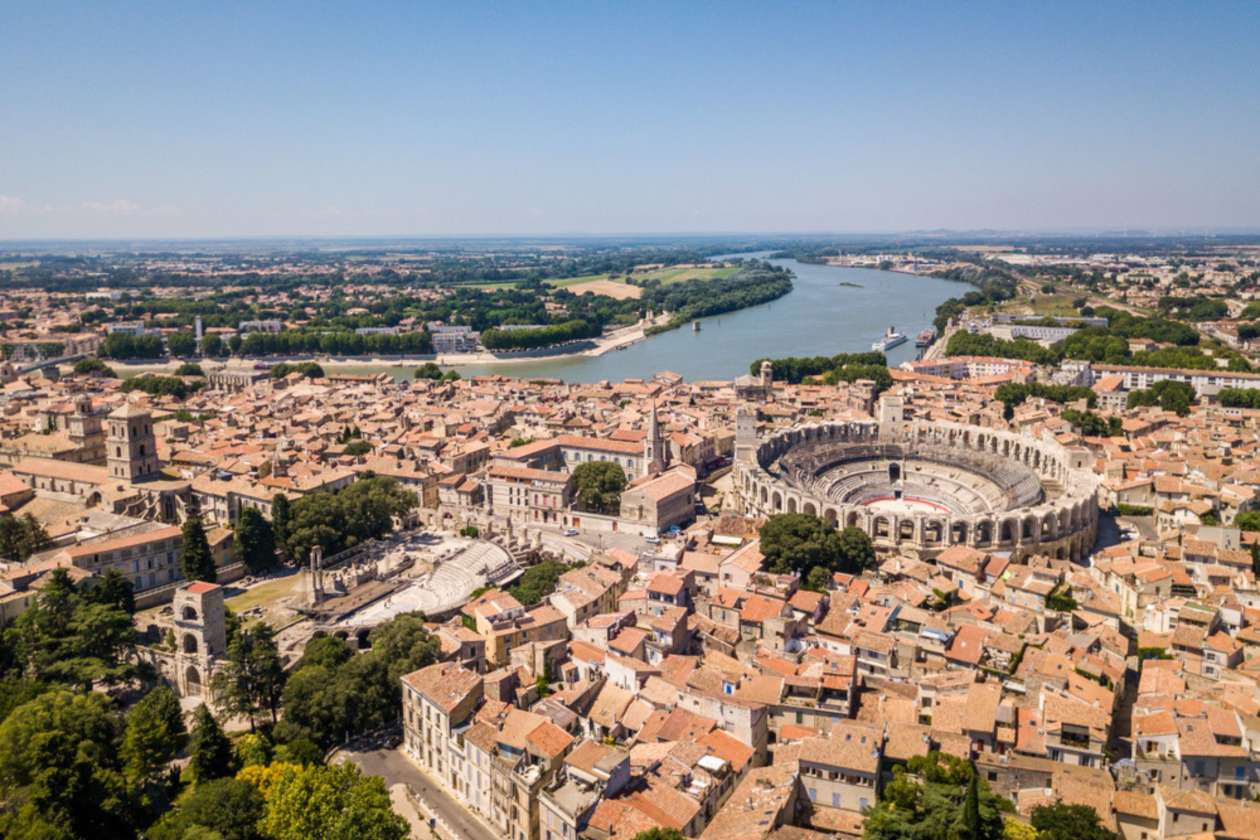
- Arles Amphitheatre
- Roman Theatre of Arles
- Saint Trophime Church
- various Van Gogh painting sites

- Visit the fascinating ruins of the Roman Empire in Provence
- Discover the charming streets which inspired some of Vincent Van Gogh’s greatest works
Sites Visited
- buildings, squares and bridges which inspired Van Gogh's work
- 2 hours with an expert guide
Itinerary Details

Reviews can only be left by Context customers after they have completed a tour. For more information about our reviews, please see our FAQ .
You May Also Like
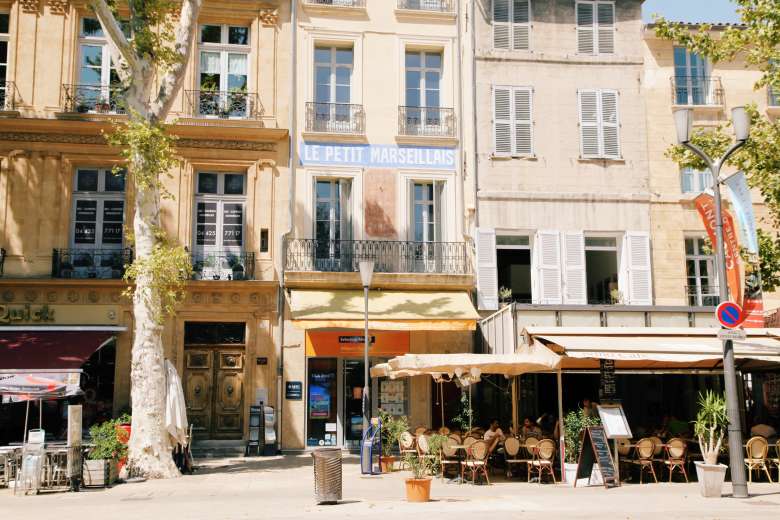
Cézanne's Aix-en-Provence Tour
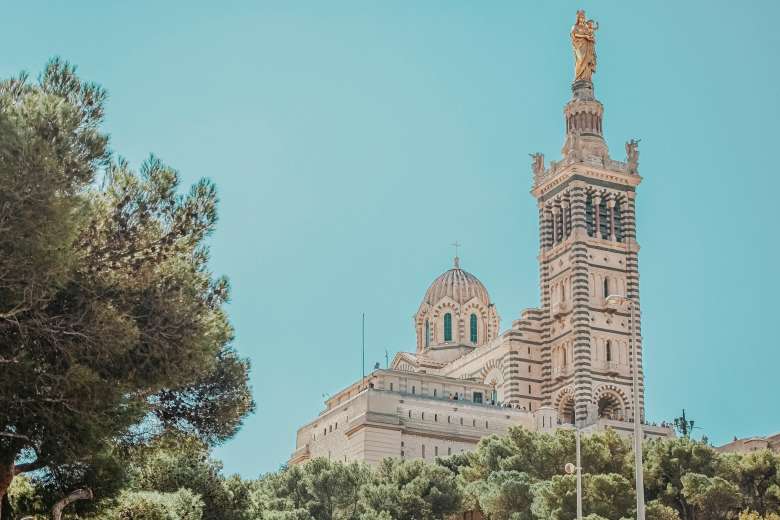
Introduction to Marseille Tour with the Old Port
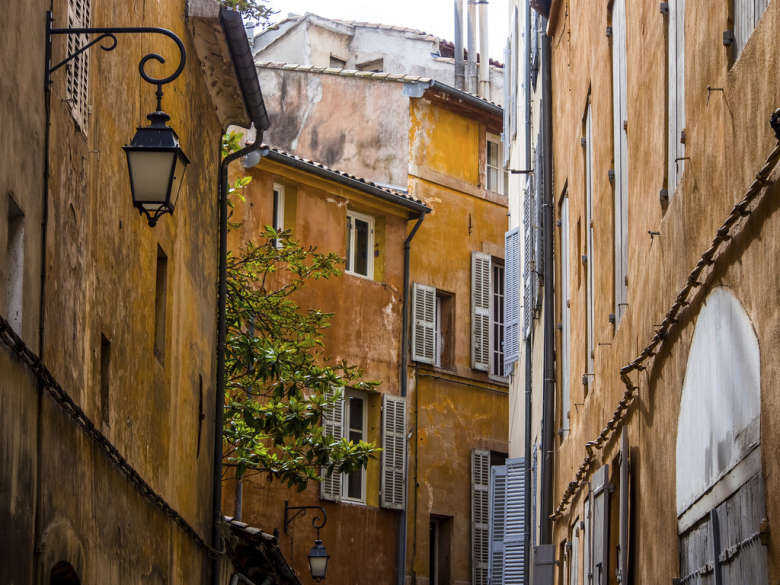
Introduction to Aix-en-Provence Tour
Book a tour.
- Our Experts
- Working with Context
- View All Cities
- Sustainable Tourism
- Refer a Friend for $50
- Travel Updates
- Advisor Login
- Expert Portal
Subscribe to our Newsletter
- Privacy Statement & Security
- Cancellation Policy

11 Top-Rated Tourist Attractions in Arles
Written by Lisa Alexander Updated Dec 22, 2023
In the heart of Provence, Arles offers distinctive Provençal character and small-town charm. Thanks to its relaxing atmosphere, Arles is a pleasant place to explore. The narrow pedestrian streets and tree-lined public squares invite you to take leisurely strolls, then relax at the shaded terraces of outdoor cafés.
Despite its slow-paced southern-French lifestyle, Arles inspires sightseeing at a fast clip. There are so many attractions to see: wonderfully preserved ruins, including the ancient Arena, Roman Theater, the Forum, and the Baths of Constantine. These archaeological sites make Arles one of the best places to visit in Provence for a glimpse of the region's Roman heritage.
Art lovers will want to follow in the footsteps of Vincent van Gogh by visiting the scenes of the artist's famous paintings. For more ideas on things to do, read our list of the top attractions in and around Arles.
L'Amphithéâtre Romain (Les Arènes d'Arles)
Les alyscamps, cloître saint-trophime, théâtre antique, musée départemental arles antique, van gogh self-guided walking tour, thermes de constantin, musée réattu (musée des beaux-arts d'arles), place de la république, fondation vincent van gogh arles, place du forum, best day trips from arles, the camargue, les baux-de-provence, abbaye de montmajour, a romanesque pilgrimage church.
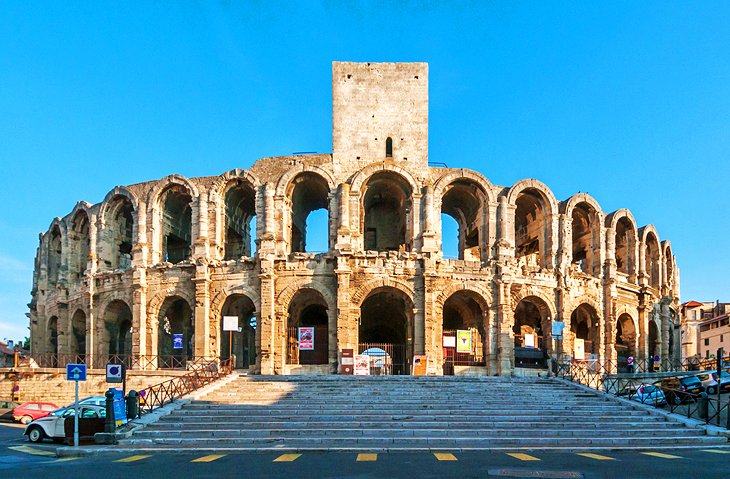
The UNESCO-listed Roman Amphitheater ( les Arènes d'Arles ), dating back to the 1st century CE, is the largest and best-preserved ancient monument in Arles. With a length of 136 meters and a width of 107 meters, the arena was one of the largest in Gaul and could accommodate around 21,000 spectators.
The facade has a double row of arcades with 60 archways and four arches used as main entrances. Seating for the spectators was once on 33 rows of tiered steps. The arena was actually built into the bedrock of the site, and in Roman times, the stone seats were covered with wooden planks.
During the Middle Ages, towers were added to the arena. Visitors can climb to the top of the tower over the entrance for a wonderful view of the old town of Arles and the nearby ancient theater. The amphitheater is still used today as an open-air venue for bullfights, reenactments of gladiator fights, music concerts, and shows.
Address: 1 Rond-Point des Arènes, Arles
Read More: Best Places to Visit in the South of France
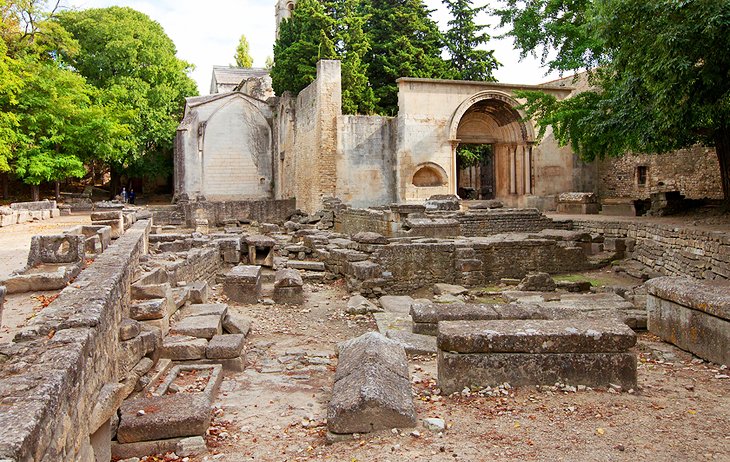
Another UNESCO-listed site, Les Alyscamps reveals the remains of ancient Arles' vast Gallo-Roman necropolis. This site was also an important stop on the Way of Saint James medieval pilgrimage route to Santiago de Compostela in Spain, because of a priory installed here around the year 1040.
In the Middle Ages, the Alyscamps was so revered that the dead were brought here for burial from considerable distances. Dante refers to this necropolis in his Inferno . Only the plain stone tombs remain; more ornate examples are on display at the Church of Saint-Trophime.
At the end of the Allée, visitors arrive at the 12th-century Church of Saint-Honorat . In the side chapel on the left, lies a beautiful sarcophagus dating from the 4th century CE.
In October 1888, Vincent van Gogh captured the Alyscamps in several paintings. Around the same time, Paul Gauguin also created two paintings of the Alyscamps.
The site is open year-round, with longer hours during summertime. Entrance requires an admission fee.
Address: Avenue des Alyscamps, Arles
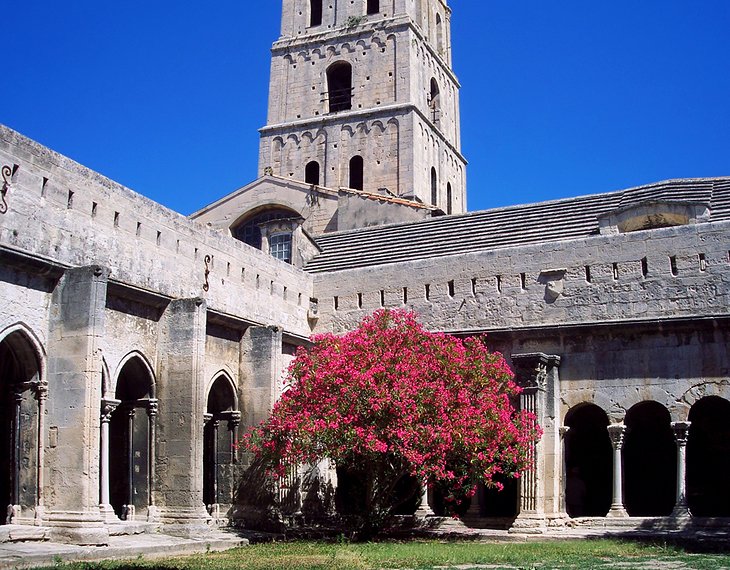
The Cloître Saint-Trophime is a masterpiece of Provençal Romanesque architecture. This UNESCO-listed monument was constructed between the 12th and 14th centuries.
The cloister features pairs of pillars with beautifully carved capitals. Upon closer observation, the finely detailed sculptures reveal biblical scenes, including the life of Christ and Saint Trophime.
The medieval cloister adjoins the Church of Saint-Trophime and is accessible by way of the church's courtyard. The adjacent Eglise Saint-Trophime also exemplifies Romanesque architecture with its marvelous intricately sculpted portal, featuring a theme of the Last Judgment.
Along with Les Alyscamps, the Church of Saint-Trophime was a stop on the Chemin de Saint Jacques medieval pilgrimage route to Santiago de Compostela in Spain .
The cloister and the church are dedicated to Saint Trophime. An important local historical figure, Saint Trophime was the first bishop of Arles during the early Christian period.
The Cloître Saint-Trophime welcomes visitors daily (except holidays) year-round. Entrance requires an admission fee.
Address: Place de la République, Arles
Read More: Top-Rated Attractions of Parc Naturel Régional du Luberon, Provence
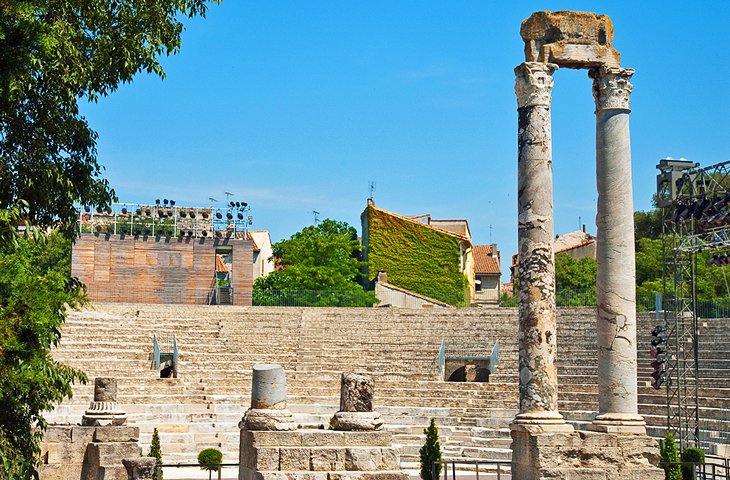
Not as well preserved as other ancient sites in Arles but still interesting, the UNESCO-listed Théâtre Antique (Roman Theater) was built in the 1st century BCE during the rule of Augustus. The theater could accommodate a crowd of 10,000 people in 33 rows of seats.
Archaeologists have discovered that the theater's stage was sumptuously decorated with marble columns and statues. The Musée Départemental Arles Antique displays some of the objects that were excavated here, including an enormous statue of Augustus.
During the early Middle Ages, the theater was used as a quarry, and the town wall was built with the material it provided.
The Théâtre Antique is open year-round daily, except for January 1st and December 25th. The theater also serves as a venue for outdoor performances and cultural events during the summer.
Address: Rue de la Calade, Arles
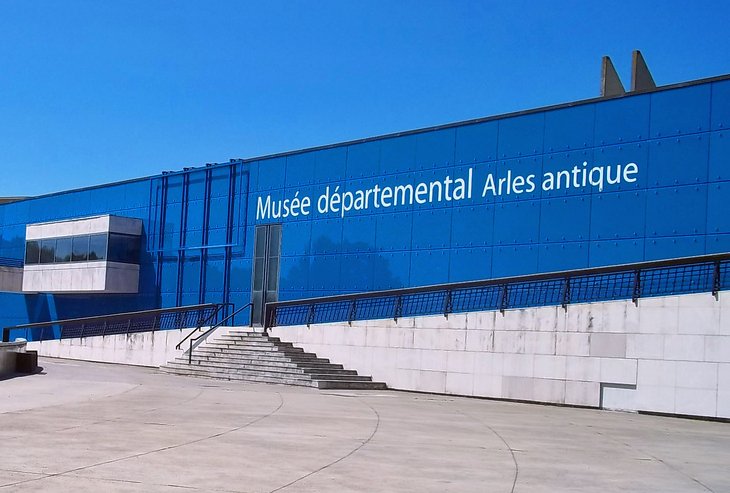
If you are interested in ancient history and archaeology, the Departmental Museum of Ancient Arles is a must-see destination. The museum occupies a striking contemporary building on the remains of the ancient Roman circus.
The museum's wealth of art and everyday objects reflects Arles' status as one of ancient Rome's most important colonial outposts. Featuring a wide range of exhibits, the museum's collection includes mosaics, statues, and other objects offering insight into daily life during Roman times.
The Musée Départemental Arles Antique is open Wednesday through Monday from 10am until 6pm and closed on Tuesdays, January 1st, May 1st, November 1st, and December 25th. The first Sunday of every month, entrance is free of charge. From July 9th through August 30th, guided tours in English are available on Thursdays at 3pm.
Address: Presqu'île du Cirque-Romain, Arles
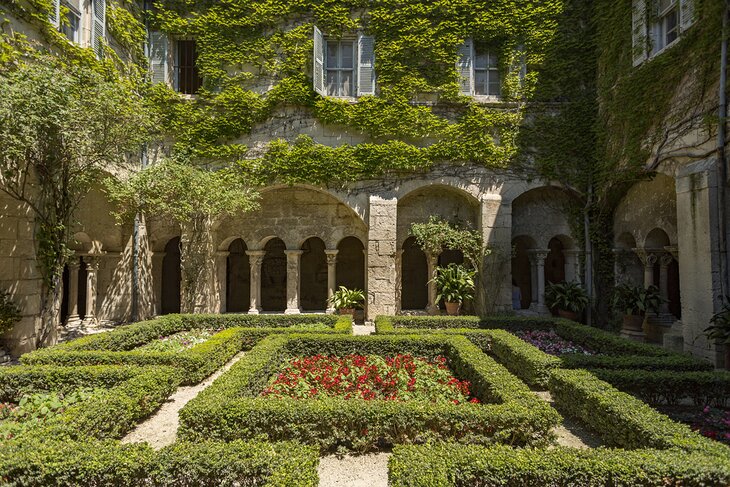
Follow in the footsteps of Vincent van Gogh by visiting the sites where he created some of his most well-known works. The Van Gogh Pedestrian Path indicates 11 of Van Gogh's painting sites. Pick up a map of the pedestrian circuit at the Tourist Office of Arles (9 Boulevard des Lices).
Highlights of this self-guided walking tour include the outdoor café on the Place du Forum (now the Café Van Gogh ) that provided the scene for the Café Terrace at Night ( Terrasse du Café le Soir ) painting, and the location of the celebrated Starry Nights ( La Nuit Etoilée ) painting.
Read More: Top-Rated Day Trips from Marseille
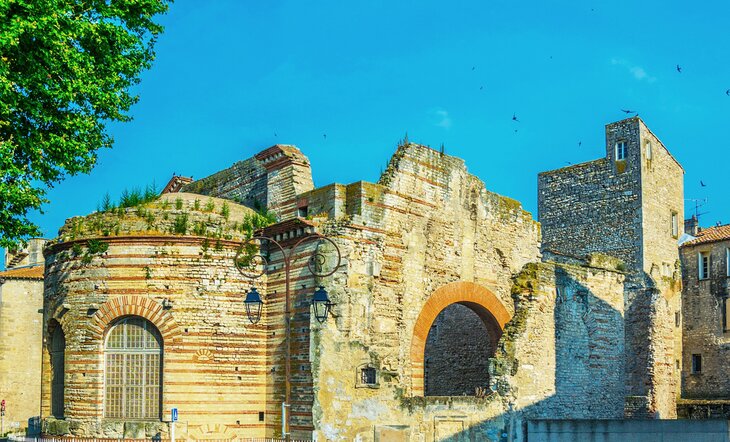
Visit the ancient Roman ruins of an extensive bathing complex, which was once as elaborate and pampering as any modern-day spa.
The Thermes de Constantin (Baths of Constantine) is a UNESCO-listed 4th-century CE bathing complex. During Roman times, the complex served as a place where people could socialize, exercise, bathe, and relax, and even get massage treatments.
The site is open every day (for an admission fee). You can see remains of the Caldarium ("hot bath"), parts of the underfloor heating system, and the Tepidarium ("warm air room" that functioned as a steam room).
Address: Rue Dominique Maïsto, Arles
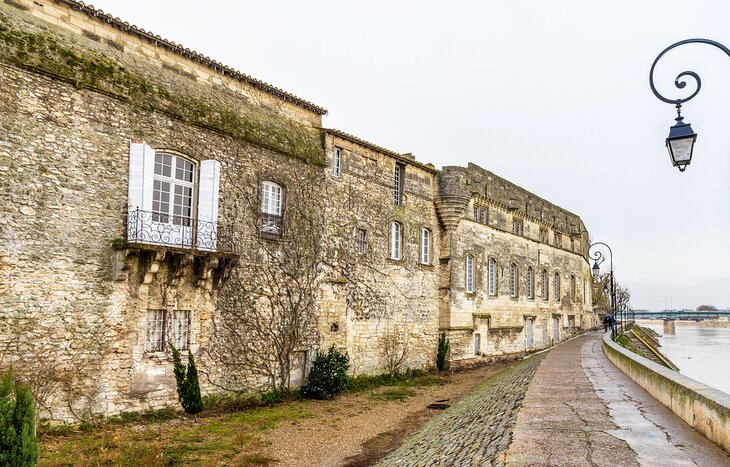
The Musée Réattu ( Arles Fine Arts Museum ) is housed in a magnificent Renaissance building that was once the Grand-Prieuré de l'Ordre de Malte (Grand Priory of the Knights of Malta). The 15th-century building is found in an inspiring spot, overlooking a bend in the Rhone River.
The museum exhibits paintings by Jacques Réattu , who purchased the Grand Priory building in 1796 and lived here for about 30 years. Réattu was a renowned Peintre d'histoire , the esteemed French classification for a History Painter. Réattu painted historical, biblical, and mythological subjects in a realistic yet aesthetically pleasing way.
Contemporary art is also well represented at the museum. There is a noteworthy assortment of artworks by Pablo Picasso . Many of the Picasso pieces on display are painted in his characteristic whimsical, humorous style. Several paintings feature Picasso's evocative images of musketeers and harlequins.
The museum is open year-round from Tuesday through Sunday. Closed on Mondays, January 1st, May 1st, November 1st, and December 25th. Admission is free of charge on the first Sunday of every month.
Address: 10 Rue du Grand Prieuré, Arles
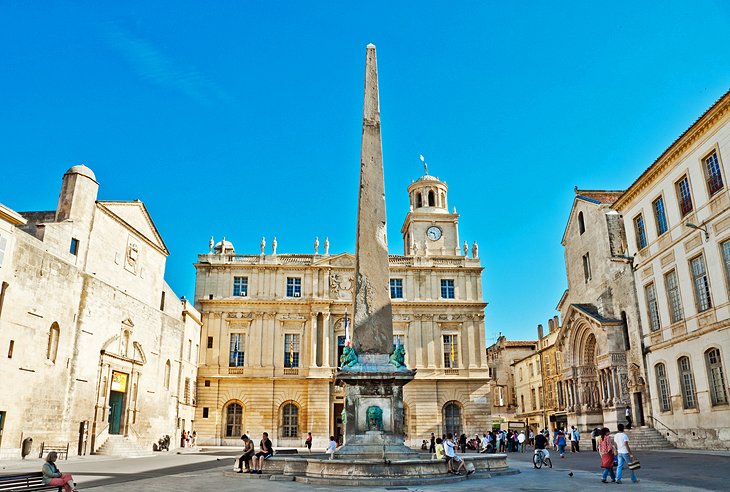
At the heart of Arles, the Place de la République centers around an ancient Egyptian obelisk that is 15 meters high. The obelisk was found in the amphitheater and placed here in 1676.
On the north side of the square stands the Hôtel de Ville (Town Hall), an elegant building constructed between 1673 and 1675. Its bell tower dates from 1553 and came from the building that previously stood on the site.
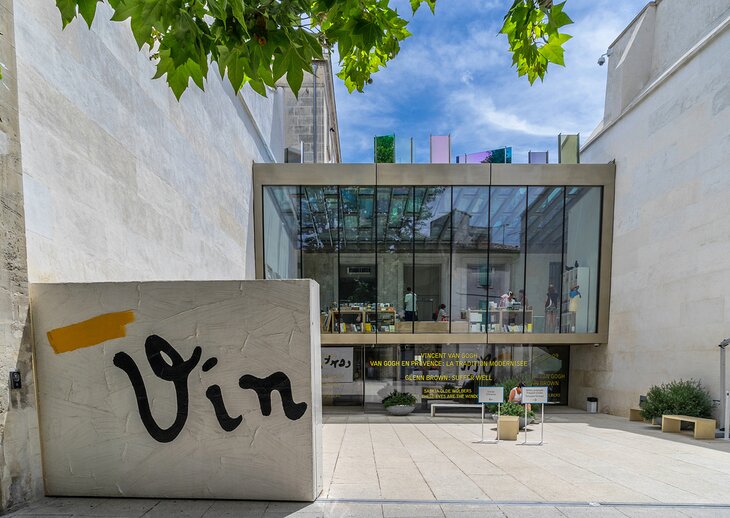
The Fondation Vincent van Gogh Arles explores the influence of Vincent van Gogh on 19th-century and 20th-century art. The gallery space displays themed exhibits. Many exhibits feature contemporary artworks alongside influential paintings by Van Gogh.
Not to be missed, the rooftop terrace affords beautiful views of the city. The Fondation also has a gift shop/bookstore.
Address: 35 ter, Rue du Docteur Fanton, Arles
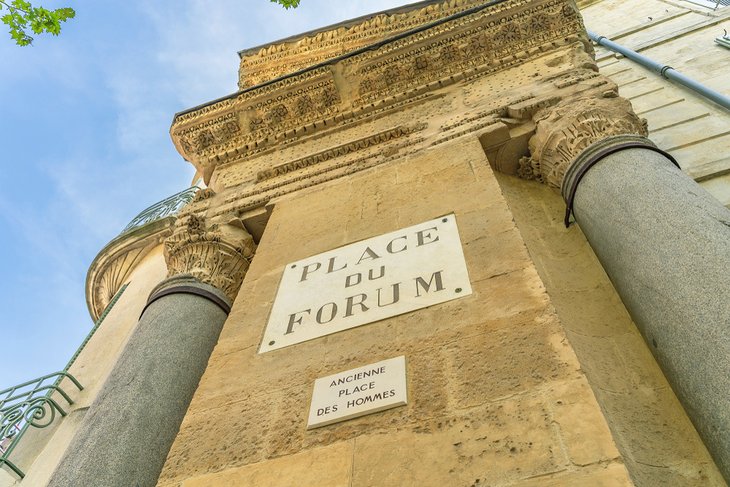
Vincent van Gogh depicted a café on the Place du Forum in his famous painting Le Café Le Soir ( Café Terrace at Night ). On the pleasant tree-lined square, the café's outdoor terrace still has the same enchanting ambience captured by Van Gogh. This café is today called the Café Van Gogh .
Another point of interest: The Place du Forum was the Roman-era town center. Part of an ancient building with weathered Corinthian columns is visible in one corner of the square.
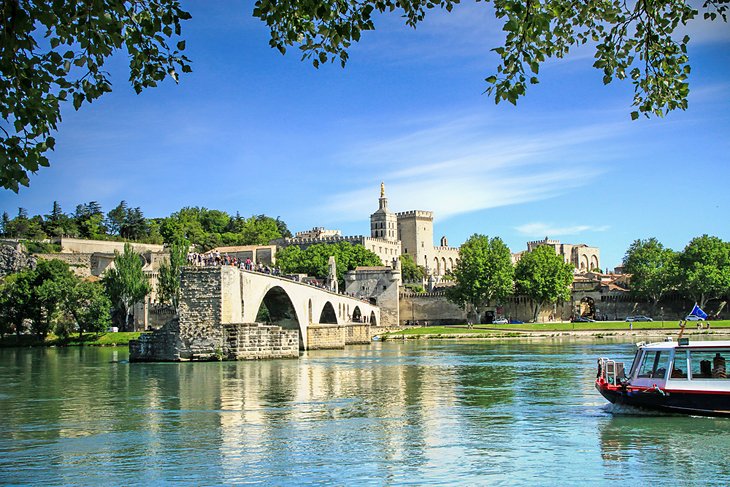
Tourists flock to Avignon to visit the UNESCO-listed Palais de Papes , a remarkable fortress-like palace that was built in the 14th century. Between 1309 to 1377, seven Popes lived in lavish quarters of the Palais de Papes.
Avignon's other must-see attractions include the Pont d'Avignon (Saint Bénézet Bridge) and the Musée du Petit Palais , which displays masterpieces of medieval and Renaissance art.
Arriving at Avignon from Arles (43 kilometers away) takes about 50 minutes by car and less than 20 minutes by train.
Across the river from Avignon (three kilometers away) is Villeneuve-lès-Avignon , with a splendid Carthusian Monastery. Also worth a detour, the medieval village of Châteauneuf-du-Pape is perched on a hilltop about 20 kilometers away from Avignon. Slightly farther north (10 kilometers from Châteauneuf-du-Pape) is Orange , a Provençal town renowned for its ancient Roman ruins.
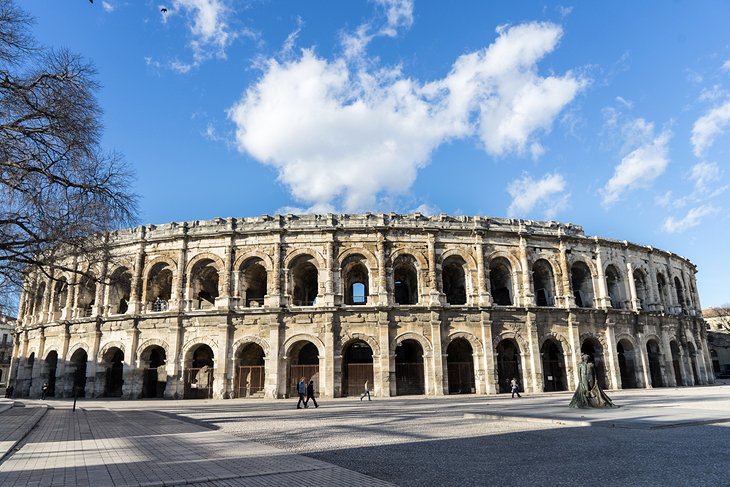
Nestled in the foothills of the Languedoc region, Nîmes has a lovely historic center with shady, tree-lined streets and squares that feature gushing fountains, typical of Southern France. Outdoor cafés in the pedestrian areas add to the appealing ambience.
One of Nîmes' top attractions is the Arènes , the best-preserved of all existing ancient Roman amphitheaters. This 1st-century amphitheater is now used as an open-air venue for music concerts and cultural events.

The Camargue is a wild and unspoiled region of Provence, protected as a natural regional park (the Parc Naturel Régional de Camargue ) and a UNESCO Biosphere Reserve . Vast open spaces, lagoons, and wetlands characterize this unique landscape that is less than 20 kilometers from Arles.
An incredible variety of bird species inhabit the marshlands. For many visitors, a highlight of visiting the Camargue is the chance to spot pink flamingos .
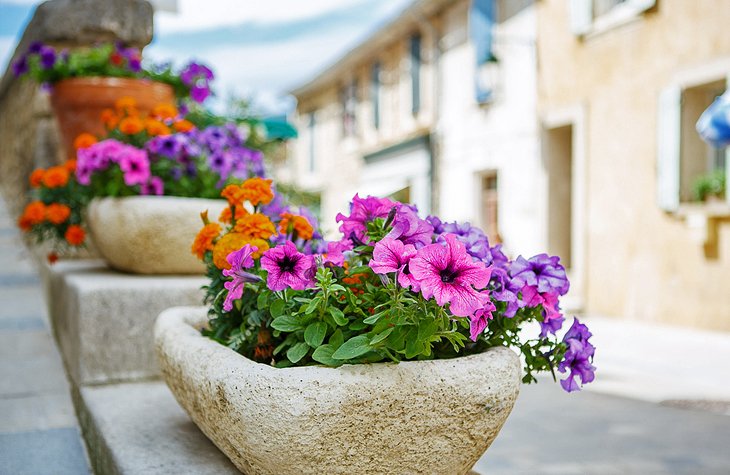
Listed as one of France's Plus Beaux Villages (Most Beautiful Villages), this ancient hilltop town feels a world away but is just a 30-minute drive from Arles. One of the most enjoyable things to do in Les Baux-de-Provence is to wander the quaint, old streets and soak up the medieval ambience .
The most striking aspect of Les Baux-de-Provence is its dramatic location on a rocky outcrop. The vantage point affords breathtaking panoramic views of the Provence countryside.
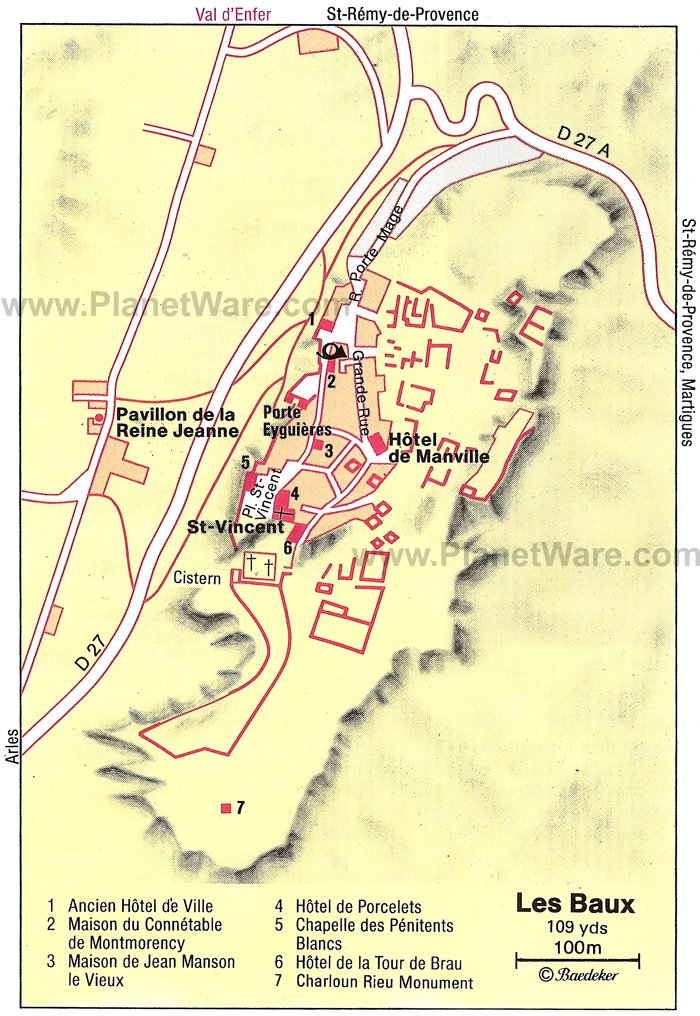
In the countryside, about a 15-minute drive from Arles, this monumental abbey is the perfect spot to meditate and contemplate the spiritual heritage of the Benedictine monks. Perched on a rocky hill like a fortress, the Abbey of Montmajour was an important place of pilgrimage throughout the Middle Ages.
The abbey has an immense Romanesque crypt dating back to the 12th century and an austere single-aisled church. Built in 1369, the abbey's cloisters exemplify serene Romanesque design with rows of double pillars.
Address: Route de Fontvieille, Arles
More Related Articles on PlanetWare.com
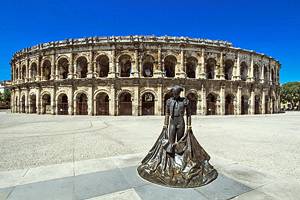
Quintessential Provence : At the center of Provence , Arles is a great place to begin exploring the region. Several interesting historic towns are within easy travel distance: the medieval city of Avignon , renowned for the UNESCO-listed Palais de Papes, is one hour by train; the ancient Roman ruins of Orange are 30 minutes by train; and Nîmes is one hour by train.
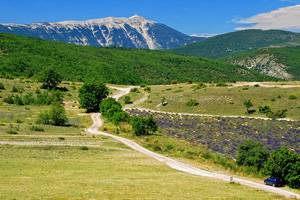
Less-Touristy Places to Visit : In the Provençal countryside, the Haut-Vaucluse area is dotted with picturesque perched villages such as Gordes, about a one-hour drive from Arles. Farther off-the-beaten tourist path, Vaison-la-Romaine (about a 90-minute drive away) is renowned for archaeological sites and summertime festivals. For a taste of real life in Provence, the seaside metropolis of Marseilles (less than one hour from Arles by train) is the place to go.
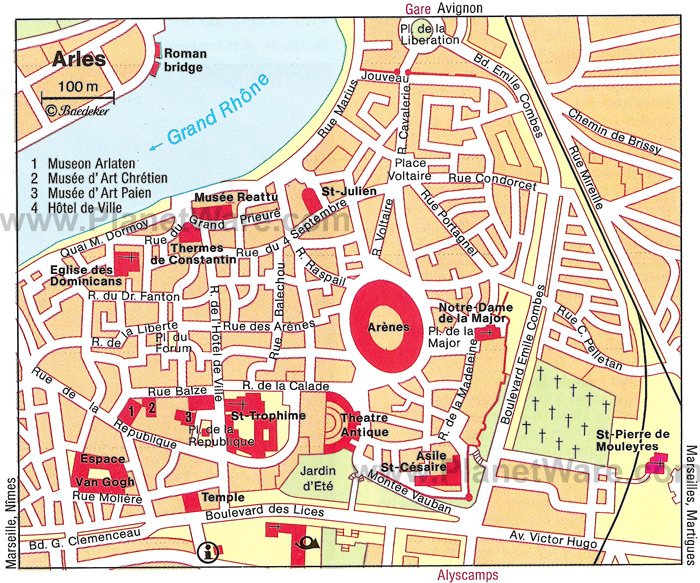
More on France
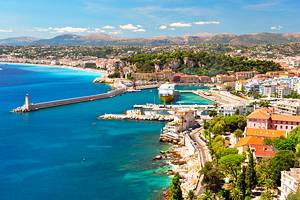

IMAGES
COMMENTS
Van Gogh was born in Zundert but spent one of the most important years of his life as a painter in Arles, France.Arles and the provincial countryside inspired Van Gogh to create brighter and more exciting landscapes.This walking tour will wind you across the city, through its narrow, quaint and beautiful cobblestone backstreets. Our journey takes us along the Rhone River and into the various ...
The courtyard of the former Arles Hospital, now known as "Espace Van Gogh," is the subject of this painting. The vantage point is from Van Gogh's room. The garden is well maintained and just as vibrant today as it was more than 100 years ago. Flowers featured in the painting include irises, pansies and poppies.
Arles Van Gogh Self-guided Walking Tour (with Maps!) You're about to embark on a self-led tour through the heart of Arles, where history is palpable in every quaint street and enduring building. Whether they hail from the Roman era, the Middle Ages, or more modern times, these structures lend the city a timeless charm. This charm has not only ...
Arles. 20 Feb. 1888 1888. - 8 May 1889. Vincent lived in Arles in the South of France for more than a year. He experienced great productivity there before suffering a mental breakdown. Vincent moved to Arles on 20 February 1888. After two years in Paris, he was tired of the bustle and demands of city life and longed for the sunshine and vibrant ...
Fondation Vincent van Gogh Arles 35 ter, rue du Docteur-Fanton 13200 Arles +33(0)4 88 65 82 93 . Shop +33(0)4 88 65 82 86 [email protected] www.eshop-fvvga.com. Tickets . Admission. ... The Dicovery Tour. A guided tour lasting one hour, for students from preschool to high school.
Walk in Vincent Van Gogh footsteps in Arles and discover what inspired his work during his stay in the Camargue capitale between February 1888 & May 1889 with this immersive self-guided audio tour. ... Starting Point: Place du Forum End Point: The tour concludes at Espace Van Gogh Interactive Map: A downloadable map with GPS tracking to guide ...
Start the Van Gogh trail in Place Lamartine, two minutes walk from the railway station. It was here that the artist painted one of his most personal pictures, The Yellow House. Van Gogh rented the ...
Visit UNESCO-listed Arles and discover many of the sites which stirred Van Gogh's creativity. In St-Rémy de Provence, you will visit Saint-Paul de Mausole, the mental hospital where the painter stayed for a year. This is a tour for Van Gogh's lovers. Price €95.
Come and learn about the history and life of the world's most famous painter with your private tour guide. Immerse yourself in the spirit of Van Gogh in Arles on a guided tour in the artist's footsteps. In 1888, in Arles, Vincent Van Gogh started his painting school which he wishes to develop with his friend Paul Gaugin.
Immerse yourself in the world that inspired Vincent van Gogh with this captivating self-guided walking tour of Arles. This offline app-based experience takes you through the charming streets and historic sites that captivated the famous artist.
Arles Van Gogh Self-guided Walking Tour (with Maps!) You're about to embark on a self-led tour through the heart of Arles, where history is palpable in every quaint street and enduring building. Whether they hail from the Roman era, the Middle Ages, or more modern times, these structures lend the city a timeless charm. This charm has not only ...
Vincent van Gogh lived in Arles for just 15 months. But it was the most thrilling period of the painter's life, and a stroll round his haunts reveals the city through his eyes. Click here to book a hotel in Arles. Van Gogh arrived in Arles by train from Paris on 18 February 1888. It was a revelation.
Van Gogh did much of his work in Arles and this self-guided tour does a great job of showing the painting against the actual scene. Allow a half day to fully appreciate it. Pick up the brochure/map in the TI office to begin your tour. Read more about what you'll visit this downloadable PDF. 9 Boulevard des Lices, 13200 Arles, France.
Walk in Vincent Van Gogh's footsteps in Arles and discover what inspired his work during his stay in the Camargue capitale between February 1888 & May 1889 with this walking audio tour.
Vincent van Gogh Walking Tour Map. The Yellow House, or "Het gele huis" in Dutch, is an iconic painting created by Vincent van Gogh. Painted in 1888, it depicts the right wing of 2 Place Lamartine in Arles, France, which served as van Gogh's residence for a period of time.
It was a favourite spot for Van Gogh when he lived in Arles. ... To learn more about Van Gogh's time in Arles, read our dedicated Van Gogh-ian Self-Guided Tour of Arles. By Paul Gauguin - The Yorck Project (2002), Public Domain. L'Allée des Alyscamps *oil on canvas *91.7 x 73.5 cm *November 1, 1888
The Van Gogh's Footsteps walking tour in Arles invites visitors to explore the vibrant city and its artistic legacy for just $32.75 per group, accommodating up to six participants in an immersive two-hour experience.. Covering approximately three miles, this engaging tour takes participants through the very streets that inspired Van Gogh's masterpieces.
On 8 May 1889 van Gogh left Arles, voluntarily committing himself for psychiatric treatment at Saint Paul de Mausole, just outside Saint Rémy de Provence. But he was unable to find peace there and took his own life the following year, on 29 July 1890, aged just 37. Click here to read about walking in van Gogh's footsteps outside Saint Rémy.
The spirit of Vincent Van Gogh presides over all that we see here—from the many views he painted of the Camargue (the reeds, the thatched huts, the people, the wild animals) to the ones he captured in the city of Arles. He created three hundred paintings during the fifteen months that he lived in the city.
Walk in Vincent Van Gogh footsteps in Arles and discover what inspired his work during his stay in the Camargue capitale between February 1888 & May 1889 with this immersive self-guided audio tour.
L'Espace Van Gogh. This is the hospital where Van Gogh was taken after he cut off a portion of his ear. He also painted the interior courtyard of this former hospital. This image shows the courtyard of the Hospital at Arles as it is today and as Vincent painted it in 1889. - Photo by Rudi ScholsAddress: Place du Docteur Félix-Rey Phone: 33 ...
Tour Description. Succumb to the charms of this fascinating Provençal city in the company of a local expert. During this two-hour introductory walking tour, you will wander through the streets of Arles to discover the remaining traces of the Roman Empire and visit the buildings, squares and bridges which Vincent Van Gogh deemed intriguing ...
Arles is probably most famous in modern times as the city that inspired Vincent Van Gogh—he completed his celebrated 1888 oil painting Café Terrace at Night in Arles. It's possible to visit the exact spot where Van Gogh painted this masterpiece, Le Café Van Gogh, located in the historic city center. But it's only worth a brief stop to snap ...
Van Gogh Self-Guided Walking Tour Hospital in Arles, scene of two Van Gogh paintings on the Van Gogh Pedestrian Path. Follow in the footsteps of Vincent van Gogh by visiting the sites where he created some of his most well-known works. The Van Gogh Pedestrian Path indicates 11 of Van Gogh's painting sites. Pick up a map of the pedestrian ...